NRAO (National Radio Astronomy Observatory)
Astronomy and Telescopes
NRAO (National Radio Astronomy Observatory)
Facilities News and features References
The US NRAO is a facility of the National Science Foundation (NSF) operated under cooperative agreement by Associated Universities, Inc. (AUI), a consortium of nine leading private universities. Its headquarters are in Charlottesville, Va. Founded in 1956, the NRAO provides state-of-the-art radio telescope facilities for use by the international scientific community. NRAO telescopes are open to all astronomers regardless of institutional or national affiliation. Observing time on NRAO telescopes is available on a competitive basis to qualified scientists after evaluation of research proposals on the basis of scientific merit, the capability of the instruments to do the work, and the availability of the telescope during the requested time. NRAO also provides both formal and informal programs in education and public outreach for teachers, students, the general public, and the media.
NSF is an independent federal agency created by Congress in 1950 "to promote the progress of science; to advance the national health, prosperity, and welfare; to secure the national defense..." The NRAO is funded by the NSF.
The NRAO conceives, designs, builds, operates, and maintains world-class radio telescopes used by scientists from around the world to study virtually all types of astronomical objects, from bodies in our own Solar System to galaxies in the distant Universe. The NRAO facilities currently include the international Atacama Large Millimeter/submillimeter Array (ALMA) located in Chile; the Karl G. Jansky Very Large Array (VLA) located near Socorro, New Mexico; and the Very Long Baseline Array (VLBA), with antennas at ten sites in Hawaii, St. Croix (Virgin Islands), and across the continental United States. NRAO, located in Charlottesville, Virginia, also operates a Central Development Laboratory (CDL) in Charlottesville providing technology and expertise in supporting current and future radio astronomy instrumentation. 1)
Background on Radio Astronomy
Radio astronomy was born early in the 20th century. In 1932, a young engineer for Bell Laboratories in New Jersey, named Karl G. Jansky (1905-1950), tackled a puzzling problem: noisy static was interfering with short-wave radio transatlantic voice communications. After months of tracking the source, he noticed that it shifted slowly across the sky. Jansky had discovered something at the heart of the Milky Way Galaxy. His work led to one of the most important papers in the history of astronomy in the 20th century, called “Radio Waves from Outside the Solar System”, published in 1933. His work laid the foundation for the science of radio astronomy! 2) 3)
Radio Astronomy and “Little Green Men”: One of the most famous radio astronomy discoveries occurred in 1967 when a young graduate student named Jocelyn Bell noticed a strange signal in a printout from a radio telescope she helped to build.
What did she find? At first it wasn’t clear. The object produced strong radio pulses at a regular rate, about 30 times a second. Bell and her colleagues first called the object LGM-1, since they joked that the regular pulses could be from “Little Green Men,” though they understood that it was an as-yet-unexplained natural phenomenon.

The signals turned out to be flashes of radio emissions from a weird object called a pulsar. Pulsars are what remains after a massive star collapses and then explodes as a supernova. It sends clouds of debris into space, leaving behind a massive compressed object made entirely of neutrons. The pulsar Bell discovered spins on its axis 30 times a second, sending out a beacon with each spin. It is almost like the ticking of a clock.
Today, we know of more than 2,000 pulsars. For some, such as the pulsar at the center of the Crab Nebula, we can also see the glowing debris of the massive star. Radio astronomers focus on the ticking pulsar at the heart of the explosion.
NSF Facilities
1) ALMA (Atacama Large Millimeter/submillimeter Array) in Chile enables transformational research into the physics of the cold Universe, regions that are optically dark but shine brightly in the millimeter/submillimeter portion of the electromagnetic spectrum. ALMA provides one to two orders of magnitude improvement over previous facilities in all areas of millimeter- and submillimeter-wave observations, including sensitivity, angular resolution and image fidelity. ALMA is a general-purpose facility that started operation in 2011, overlapping with construction which was completed in 2015. Within the broad range of science accessible with ALMA, the top-level objectives include imaging the redshifted dust continuum and molecular line emission from evolving galaxies in the early Universe, determining the chemical composition and dynamics of star-forming gas in nearby and distant, but normal, galaxies like the Milky Way, and measuring the gas kinematics in young disks in nearby molecular clouds and detecting the tidal gaps induced by planet formation.
ALMA is an international partnership program of ESO (European Southern Observatory, representing its member states), NSF (National Science Foundation) USA, and NINS (National Institute of Natural Sciences, Japan), together with NRC (National Research Council, Canada), MOST and ASIAA (Taiwan), and KASI (Korea Astronomy and Space Science Institute, Republic of Korea), in cooperation with the Republic of Chile.
ALMA construction and operations are led by ESO on behalf of its Member States; by the National Radio Astronomy Observatory (NRAO), managed by Associated Universities, Inc. (AUI), on behalf of North America; and by the National Astronomical Observatory of Japan (NAOJ) on behalf of East Asia. The Joint ALMA Observatory (JAO) provides the unified leadership and management of the construction, commissioning and operation of ALMA.
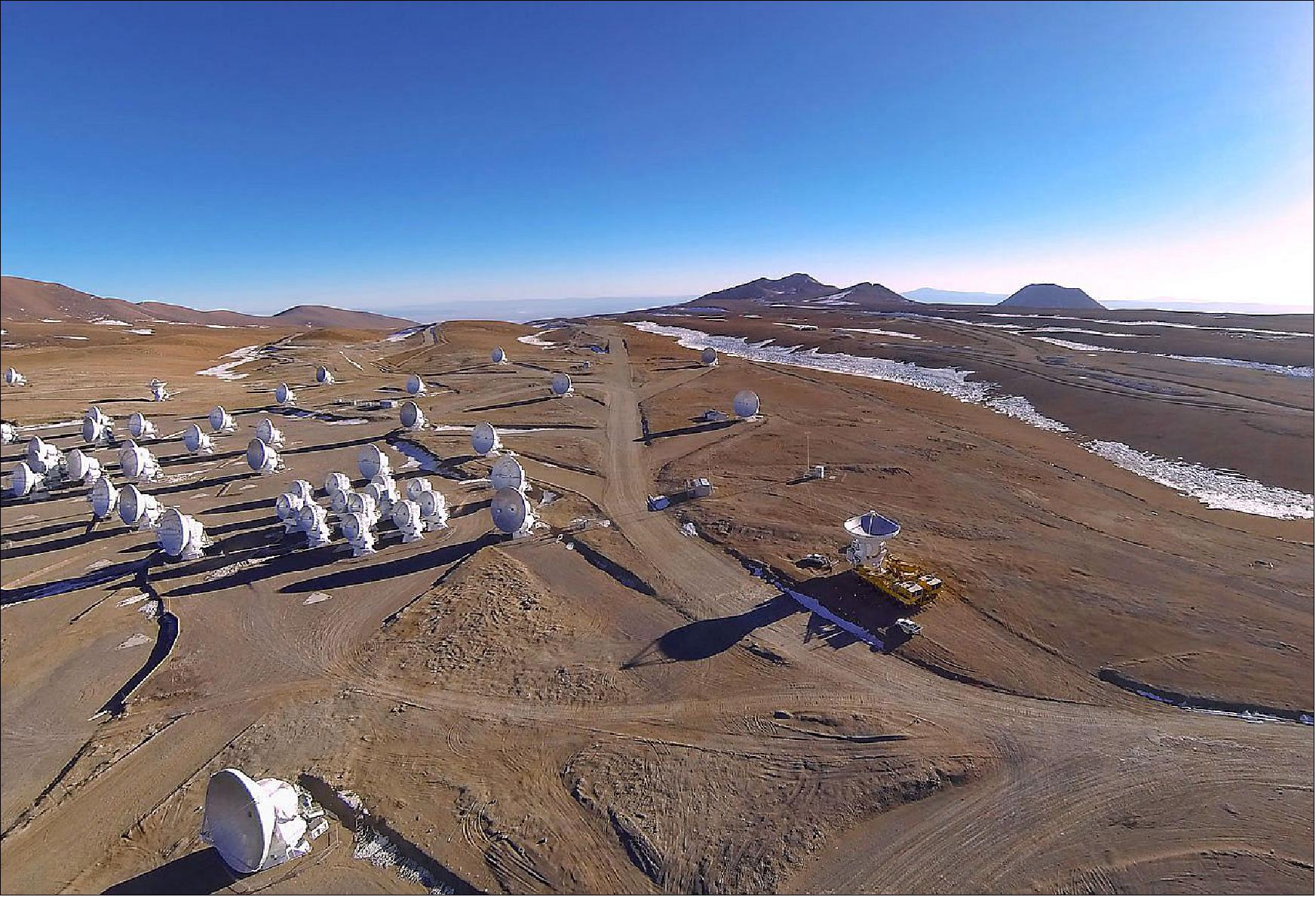
2) The Karl G. Jansky VLA (Very Large Array) is the world’s leading centimeter-wavelength radio telescope. Following a major overhaul completed in early 2013, the VLA provides one to three orders of magnitude improvement over all previous performance aspects except angular resolution. Among a broad range of scientific capabilities, the VLA addresses four primary science themes: measuring the strength and topology of cosmic magnetic fields; imaging young stars and massive black holes in dust-enshrouded environments; following the rapid evolution of energetic phenomena; and studying the formation and evolution of stars, galaxies and active galactic nuclei.
From the early 1960s at NRAO, astronomers knew they needed an array of radio dishes to complement the work of our giant, single-dish telescopes. An array is a group of several radio antennas observing together creating — in effect — a single telescope many miles across. 5)
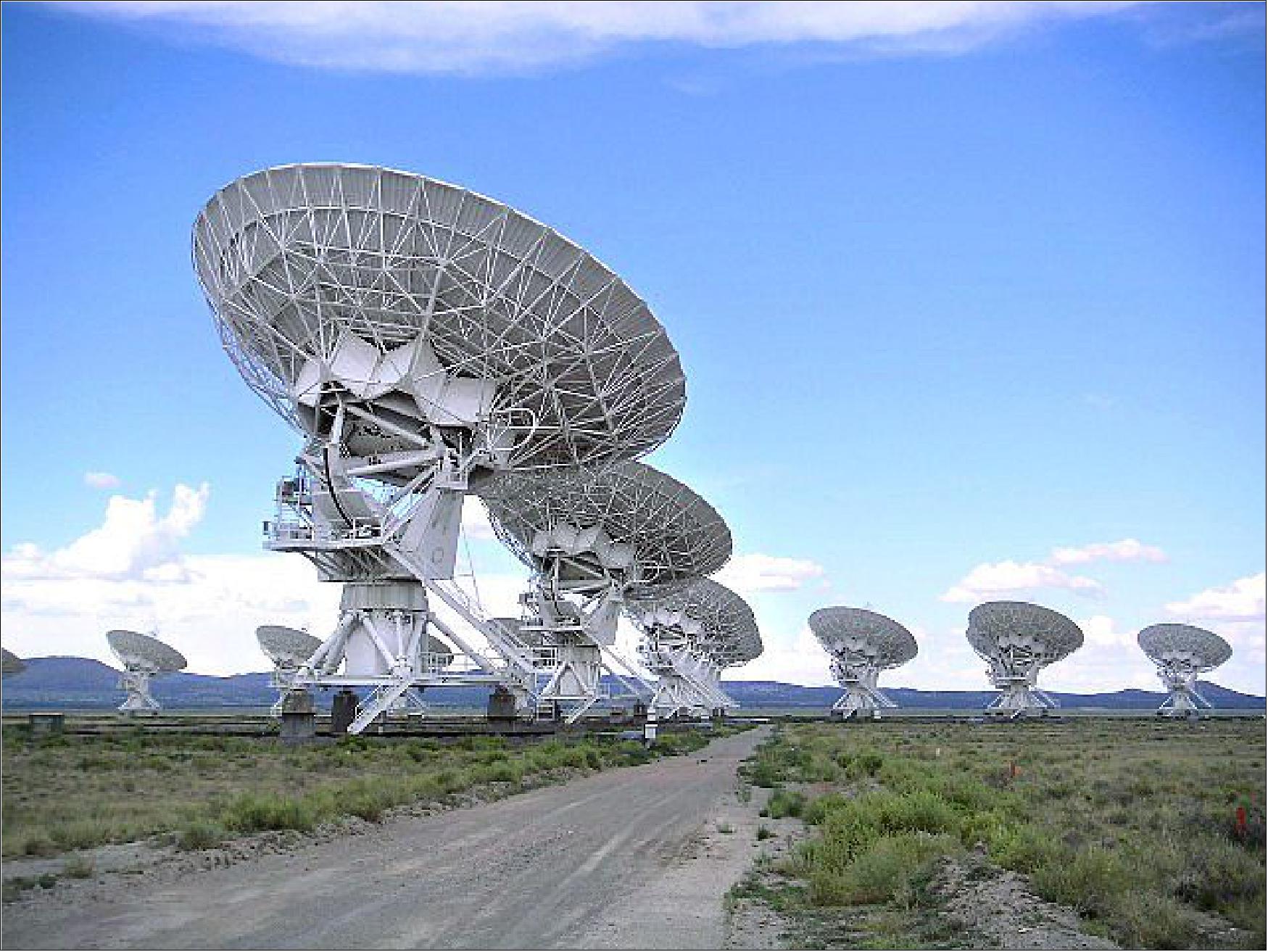
The antennas are distributed along the three arms of a track, shaped in a Y-configuration, (each of which measures 21 km. Using the rail tracks that follow each of these arms the antennas can be physically relocated to a number of prepared positions, allowing aperture synthesis interferometry with up to 351 independent baselines: in essence, the array acts as a single antenna with a variable diameter. 6)
Each of the VLA’s 28 antennas (including the one that is a spare) is an 25 m dish with 8 receivers tucked inside. The dish moves on an altitude-azimuth mount, what you’ve probably seen as a classic tripod mount: it tilts up and down and spins around.
As a first step, NRAO built the Green Bank Interferometer (GBI) to learn and develop best communications, correlation, and atmospheric correction practices. Throughout the 1960s and 1970s, this four-element array helped NRAO prepare for a Very Large Array of 27 telescopes. 7)
However, before such a large-scale project could be funded, NRAO needed to prove the design’s hardiness and our ability to operate it.
From 1959 in Green Bank, we had been running a successful and busy 85-foot telescope, called the Tatel Telescope, that we bought as a kit from Blaw-Knox Corporation. Blaw-Knox was still making these kits in 1963 when we ordered another 85-footer from them to create a two-telescope observing system.
By February of 1964, we had assembled this near-twin 85-foot radio telescope that we named the 85-2. The 85-2 differed slightly from the Tatel in that it had 80 14-ply truck tires permanently mounted to its frame. Using a D-7 Caterpillar and an Army surplus aircraft towing tractor, we could haul the 85-2 closer or farther away from the static Tatel to change the pair’s combined resolution and sensitivity.
In anticipation of our new movable arrival, we built a mile and a half-long track leading away from the Tatel. We placed the 85-2 at the end of the new track for maximum distance and mounted six staging stations at 1000-ft intervals along the track. Each station had three piers for stability and sockets for data and power lines that ran the length of the track, some buried, some suspended above on trays.
Cabling between the 85-2 and the 85-foot Tatel took several months, and, with the first digital autocorrelator to combine their observations, the two finally became a working interferometer on June 1, 1964. The interference patterns of the telescopes’ combined radio wave observations told astronomers about position, size, and strength of objects in space.
Renamed the Green Bank Interferometer (GBI), this pair’s interference (fringe) patterns were very good, showing astronomers the periodic changes in radio signals from objects that dimmed and brightened over time. Within the first year of GBI observations, the major astronomy report from the National Academy of Sciences recommended the immediate funding and building of a large-scale radio telescope array as a national science facility. We began experiments and discussing designs for what would become that national facility, the Very Large Array in New Mexico.
We built for the GBI a new control room and added a third 85-foot Blaw-Knox telescope to the middle of the interferometer track in spring of 1967, greatly increasing the sensitivity of the Green Bank Interferometer. The 85-3, too, had truck tires mounted on either side, and we used it to test multiple baselines – but still only in one, short direction, running roughly northeast to southwest. For a true test of a high-resolution array, we needed a telescope located far outside of that track.
Therefore, that year, a fourth portable telescope was added to the Green Bank Interferometer. The dish of this portable kit telescope was half the size of the others, 42 feet. This unique telescope could be dismantled and hauled away on the truck that also ran its control desk and motorized mount.
The 42-foot telescope was hauled first to a location 8 miles from its larger siblings. It later was relocated to a site 11 miles north-northeast, a mountaintop called Spencer Ridge. (The distance is the same as an arm of the Y-shaped VLA, still under design at the time.) Finally, it was sited on a ridge in Huntersville, West Virginia, 26 miles from Green Bank, the same distance of the longest baseline of the VLA.
Its observations were wirelessly transmitted as a microwave data link down the mountains to a receiver that sent the signal into the autocorrelator, still in the little building along the GBI track.
By 1972, the aging surface of the 42-foot portable was too inaccurate for our increasing research needs, and the unique telescope package was given to Cornell for interferometer work at its Arecibo observatory in Puerto Rico.
A new, 45-foot portable replaced the outgoing 42-foot in 1973 and served through 1983 on the Huntersville mountaintop. It was brought back to the Green Bank site as a stand-alone telescope, still in use, but now as a solar radio telescope.
A new 46-foot portable dish telescope was placed on Point Mountain to complete the VLA test work. In 1988, with the VLA nearly a decade into its reign as the best interferometer on Earth, the 46-foot was given to the NOAA, moved to Fortaleza, Brazil in 1991, and served as an element in their Earth-mapping VLBI project. - The GBI continued doing important scientific observations into the 21st century.
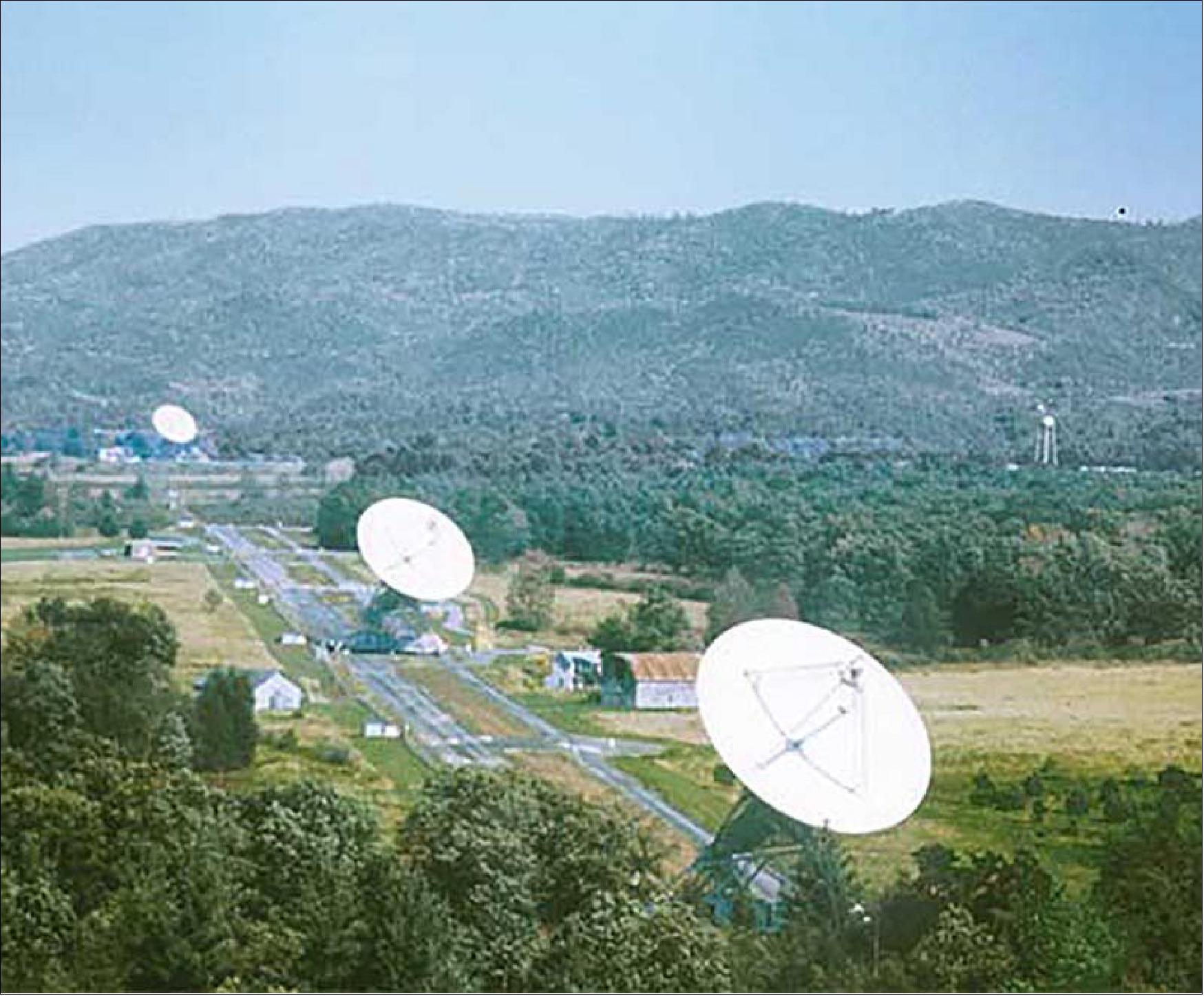
Discoveries: The Green Bank Interferometer (GBI) was not solely a VLA testbed. It was a fully-functioning, state-of-the-art interferometer on its own. Most notably, in mid-February of 1974, the GBI discovered an intense and point-like source of radio waves coming from the heart of our Milky Way Galaxy. Named Sagittarius A*, this incredibly compact object was soon determined to be a supermassive black hole. Until 1978, the GBI’s detailed views were used for studying fine structure in known radio objects. The GBI completed the first radio measurement that confirmed, to high accuracy, Einstein’s prediction of the bending of light (i.e. any electromagnetic radiation) near a massive body, commonly called Einstein rings or gravitational lensing.
From 1978 to 1996 the GBI was operated by the US Naval Observatory for its studies of Earth rotation (for accurate timekeeping) and monitoring of variable sources, such as pulsars. From 1996 until 2000 the GBI was in continuous use, funded partly by NASA, for studies of X-ray and Gamma-ray sources.
From 1995 until 2000, the GBI carried out a survey focused on the binary star systems Beta Persei and V711 Tauri — both are about 95 light-years from Earth. These stars orbit each other, but are pairs of different types of stars. Beta Persei is the prototype of the “Algol” class of interacting binary stars. An Algol system contains a hot, blue, main sequence star, along with a cool, orange/red star that is more active than our Sun. V711 Tauri is an “RS Canum Venaticorum” binary, which contains two cool stars that behave like our Sun. The continuous monitoring program, the longest ever completed, also demonstrated that Beta Persei and V711 Tauri have short- and long-term cycles, and active and inactive cycles. These data will help us to better understand our Sun’s activity.
The Green Bank Interferometer ceased operations on October 6, 2000, but the newer 85-foot telescopes had contract jobs for some years after, observing pulsars and other transient radio objects. They are still in working order and ready to take on new contract jobs.
3) The VLBA (Very Long Baseline Array) of NRAO provides the astronomical community users with a unique and fully dedicated facility able to conduct sensitivity-limited radio observations with an astrometric precision as high as 5 microarcsec, over the frequency range of 0.3 to 96 GHz (90 cm to 3 mm). It is the only Very Long Baseline Interferometry (VLBI) facility in the world with availability and responsiveness for observing transient events in an efficient and timely way. With the VLBA, astronomers can conduct observations from the smallest physical scales such as the surfaces of asteroids, penetrate through the dusty disk of the Milky Way to observe star forming regions beyond the Galactic Center, measure the distances to pulsars and monitor pairs of super-massive black holes billions of light-years away.
The VLBA is a network of ten observing stations located across the United States. Each station consists of a 25-meter radio antenna dish and a control building. Radio signals captured by each antenna are amplified, digitized and recorded. The recorded data are then sent to Socorro, NM to be processed by a powerful computer known as a correlator. By combining their data, the stations form one of the world’s most powerful radio cameras. 8)
Locations: The VLBA stations are located in areas with limited radio interference, and widely spread across the country. The distance between any two stations is known as their baseline. The longer the baseline, the better the angular resolution. The most widely separated antennas are at Mauna Kea in Hawaii and St. Croix in the U.S. Virgin Islands, which are 8,611 km apart. While each VLBA antenna is identical, each location is unique. Each station also has a webcam. One can see them in realtime at: http://www.vlba.nrao.edu/sites/SITECAM/SCcam.shtml
- St. Croix – U.S. Virgin Islands
- Hancock – New Hampshire
- North Liberty – Iowa
- Fort Davis – Texas
- Los Alamos – New Mexico
- Pie Town – New Mexico
- Kitt Peak – Arizona. NSF’s NOIRLab (National Optical-Infrared Astronomy Research Laboratory) is the United States national center for ground-based, nighttime optical and infrared astronomy.
- Owens Valley – California
- Brewster – Washington
- Mauna Kea – Hawaii

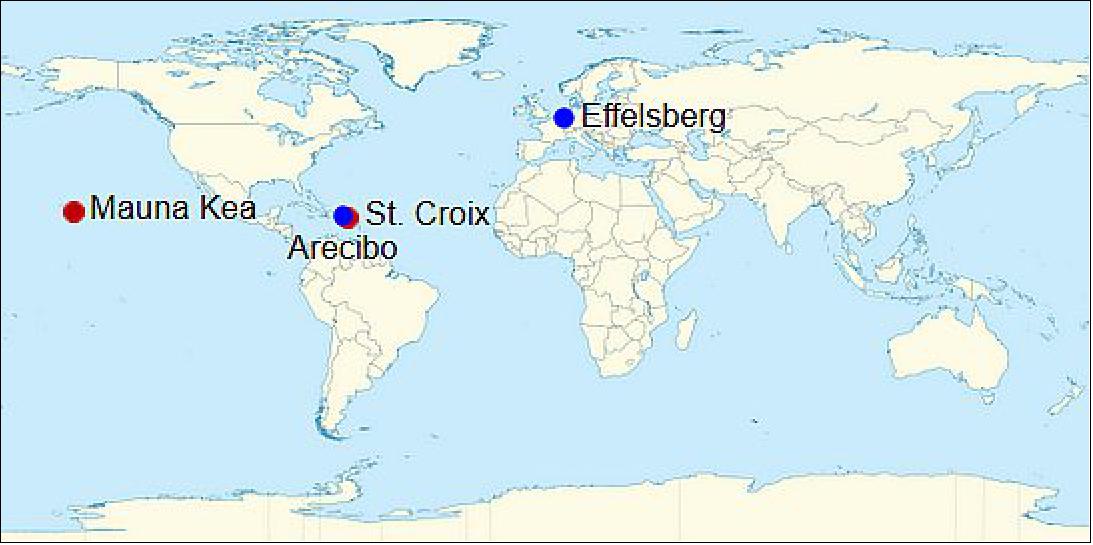
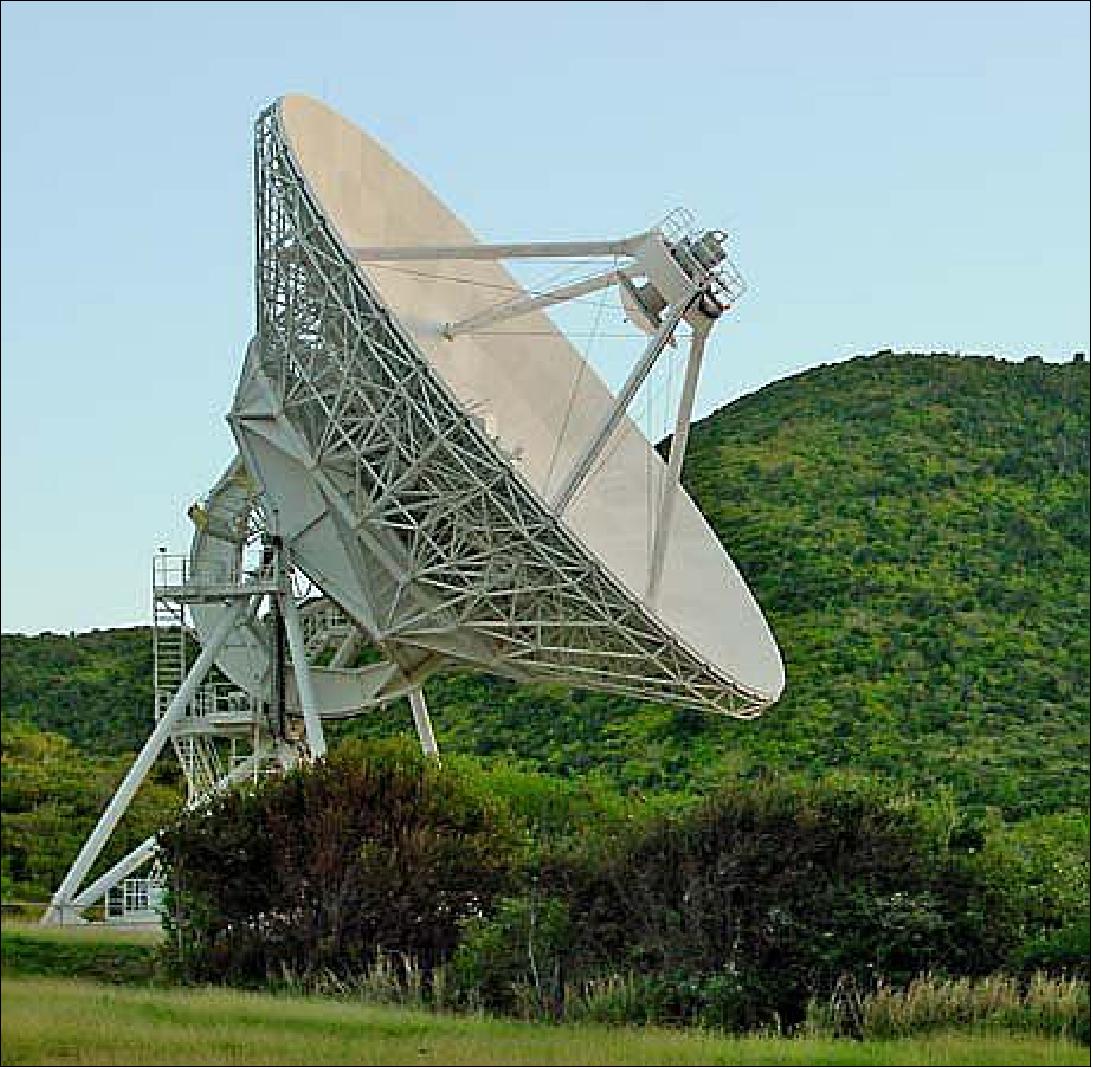
The use of the VLBA can be scheduled dynamically, and its sensitivity can be improved by a factor of five by including other radio telescopes such as the Green Bank Telescope (GBT) in West Virginia, the Very Large Array (VLA) near Socorro, New Mexico and the Effelsberg radio telescope in Germany. These additional sites are brought online for as much as 100 hours per four-month trimester. In this configuration, the entire array is known as the High-Sensitivity Array (HSA).
Discoveries
• Observing superfast jet material from a neutron star merger
• Measuring the precise locations and distances of Fast Radio Bursts
• Settling the controversy over the distance to the Pleiades
• Mapping the spiral arms of our galaxy
• Observing the rotation of an asteroid passing near Earth
• Tracking the collision of powerful stellar winds
• Measuring water masers to accurately determine cosmic distances.
VLBA Science
High precision observations are the VLBA’s greatest strength. With its unmatched pinpoint accuracy, astronomers can measure the positions and distances of cosmic objects to determine their masses, makeup and movement.
Mapping the Universe: Milky Way illustration.The VLBA can measure the position and distance of radio sources extremely well, so it is an excellent tool for mapping where things are in the heavens. By observing water masers (naturally occurring “lasers,” but with microwaves instead of visible light) the VLBA can determine distances across billions of light years to study the amount of dark energy in the universe. It can measure the shape and motion of galaxies, and predict when galaxies will collide.
It measures the exact location of planets in our solar system, ensuring that spacecraft sent to Mars and other planets will reach their destination. The VLBA also provides the most accurate positions and distances of stars. It also maps the positions of quasars with exquisite precision, which provides a celestial reference grid used by other telescopes.
Monitoring the Changing Earth: The VLBA can determine the location of each of its dishes to within a small fraction of an inch. It does this by observing very distant quasars. Quasars are brilliant beacons in the sky. They are powered by supermassive black holes, and are located billions of light years away. They are so distant they can be used as fixed points in the cosmos. By observing the directions of these quasars relative to each telescope, the VLBA tracks the position of each dish,
With the support of the US Naval Observatory, the VLBA telescopes then act like pins tacked to the Earth’s crust; any movement of the crust shows up as a change in distances between the telescopes. With the exact ground positioning of the VLBA, scientists can monitor movements of the Earth’s crust to learn how they reflect wind patterns and climate change. They also help GPS services improve their accuracy.
Tracking Near-Earth Asteroids: Asteroids can be studied by bouncing radio signals off their surface. When radar facilities beam radio pulses on to nearby asteroids, the VLBA’s telescopes observe the pulses as they return to Earth. This allows the VLBA to pinpoint an asteroid’s location over time. The precise timing of these reflections reveals the asteroid’s spin rate and direction and allows astronomers to calculate changes in its orbit.
The orbits of some asteroids cross paths with Earth’s orbit. Asteroids have collided with Earth in the past, creating fireballs and even craters on Earth’s surface. If one were to strike Earth near a populated area, the result could be devastating. With the VLBA’s timing accuracy, astronomers track the orbits of potentially threatening asteroids, giving us time to prepare for a collision and perhaps even change its course.
The VLBA also helps us look to the future by monitoring asteroids humanity might explore in the future. Whether it’s a mission to learn more about the outer solar system, or the quest to mine asteroid resources, the more we know about an asteroid’s orbit and composition, the better prepared we can be for future missions.
Studying Black Holes: The VLBA is one of the world’s most powerful radio cameras. With it, astronomers can peer through dense clouds of gas and dust such as those surrounding supermassive black holes. The VLBA can see into the heart of a galaxy, watching it pulse as the black hole whip out quintillions of tons of charged gas every day. By recording time-lapse movies of supercharged gas speeding away from black holes, astronomers can update theories of how supermassive black holes feed and grow.
4) GBT (The Robert C. Byrd Green Bank Telescope)
The Robert C. Byrd Green Bank Telescope is a 100 meter diameter telescope with offset optics and active surface compensation. It is designed to cover three decades of frequency from approximately 100 MHz to 115 GHz (3.0 m -2.6 mm). It is the largest fully-steerable telescope in the world, with access to 85% of the celestial sphere. Its offset optics provide a very clean main diffraction beam with low sidelobes. It is an extremely versatile facility, capable of unique science from meter to millimeter wavelengths. 9)
GBT, in Green Bank in West Virginia, was the initial site of the National Radio Astronomy Observatory, with construction commencing in the late 1950s. Principal telescopes at the facility have included the 300 Foot (91 m) Telescope, the 140 Foot (43 m) Telescope, the Green Bank Interferometer, and now the GBT. Telescopes presently in operation on the site include the GBT, the 85-3 pulsar monitoring telescope, the 45-Foot telescope now in use for the Solar Radio Burst Spectrometer project, and the 40 Foot Educational Telescope. The Observatory is presently considering a project to recommission the 140 Foot Telescope for contract use by an external group. The Green Bank Interferometer and the 20 Meter Telescope (formerly operated for the US Naval Observatory) are currently dormant but could be reactivated if needed. The site also operates the Green Bank Science Center, a new facility housing classrooms, an auditorium, and exhibits on the science and history of radio astronomy. An active Education and Public Outreach program is run by the staff of the Science Center, including site tours, educational programs for K-12 and undergraduate students, and summer training workshops.
Managing institution and organization: The Green Bank Telescope and Green Bank Operations are a part of the NRAO (National Radio Astronomy Observatory), a facility of the National Science Foundation, operated under cooperative agreement by Associated Universities, Inc.
Funding source(s): Major funding for Green Bank Operations derives from AUI's cooperative agreement with the NSF. Occasionally, additional funding has been obtained through NSF and NASA grants, or through contracts with other entities to perform a service or operate a telescope. These external grants and contracts are typically small in comparison with cooperative agreement funds.
Construction history and cost: The GBT replaces the 300-foot telescope which collapsed in 1988. In less than a year, AUI submitted a proposal to NSF for the replacement telescope. GBT construction was included in the Emergency Supplemental Appropriations bill passed in 1989 (this item in the NSF budget became known as the MREFC line). A construction contract for $55M was let to RSI in 1990. "First Light" observation of the pulsar PSR 1140+223 occurred in Aug 2000 about the time of the formal dedication. Commissioning tests began in Feb 2001 with the first early science observations demonstrating the first bistatic (Arecibo-GBT) radar of Venus a month later. Final acceptance of the GBT from the contractor (by this time Lockheed-Martin) occurred in Sept 2001. Full scientific operations were achieved (>50% time scheduled for astronomy) in Oct 2003.
Operational history and cost: The GBT began early scientific operation in the spring of 2001 while commissioning was still underway. For the following two years, science and commissioning activities were interspersed. Routine scientific operation using over 50% of total telescope time was achieved by the Fall of 2003.
Coordinates | Latitude: 38º25’59.236'' North (NAD83); Longitude: 79º50’23.406'' West; (NAD83); Track Elevation: 807.43 m (NAVD88) |
Optics | 110 m x 100 m unblocked section of a 208 m parent paraboloid; Offaxis feed arm |
Telescope diameter | 100 m (effective) |
Available Foci | Prime and Gregorian; f/D (prime) = 0.29 (referred to 208 m parent parabola); f/D (prime) = 0.6 (referred to 100 m |
Receiver mounts | Prime: Retractable boom with Focus-Rotation Mount; Gregorian: Rotating turret with 8 receiver bays |
Subreflector | 8 m reflector with Stewart Platform (6 degrees of freedom) |
Main reflector | 2004 actuated panels (2209 actuators); Average intra-panel RMS 68 µm |
FWHM beamwidth | Gregorian Feed: ~ 12.60/fGHz arcmin; Prime Focus: ~ 13.01/fGHz arcmin |
Elevation limits | Lower limit: 5 degrees; Upper limit: ~ 90 degrees |
Declination range | Lower limit: ~-46 degrees; Upper limit: 90 degrees |
Slew rates | Azimuth: 35.2 degrees/min; Elevation: 17.6 degrees/min |
Surface RMS | Passive surface: 450 µm at 45º elevation, worse elsewhere; |
Active surface | ~250 µm, under benign night-time conditions |
Pointing accuracy | 1σ values from 2D data; 5'' blind; 2.2'' offset |
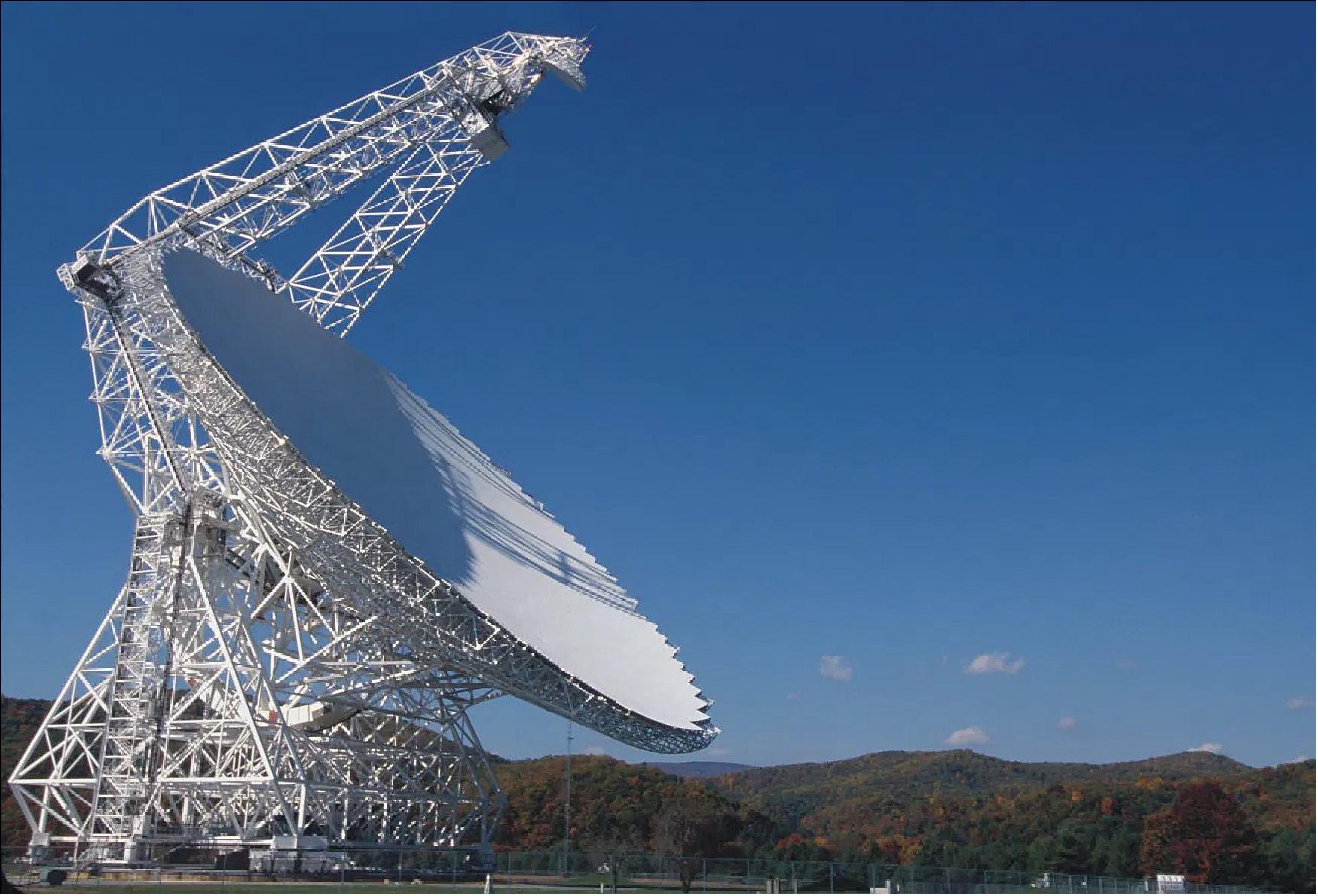
Quick Facts about the GBT
• The GBT is running observations roughly 6,500 hours each year, more than any other observatory.
• More than 600 individual scientists and students proposed to use the GBT within the past year.
• More than $25,000,000 has been invested in the GBT in the past five years by colleges, universities, the NSF, and the state of West Virginia.
• The surface of the GBT is perfectly smooth to a noise level of 260 µm (5 human hairs).
• The pointing accuracy of the GBT is 2 arcseconds, able to resolve a quarter at 3 miles.
• The GBT weighs almost 17 million pounds and stands over 485 feet above ground level.
• The GBT’s collecting area is 2.34 acres and its diameter is 300 feet.
• The GBT operates 24 hours/day, 362 days/year.
• The operational funding provided by the NSF is approximately 0.1% of the NSF astronomy budget
News and Features
• June 15, 2022: Astronomers analyzing data from the VLA Sky Survey (VLASS) have discovered one of the youngest known neutron stars — the superdense remnant of a massive star that exploded as a supernova. Images from the National Science Foundation’s Karl G. Jansky Very Large Array (VLA) indicate that bright radio emission powered by the spinning pulsar’s magnetic field has only recently emerged from behind a dense shell of debris from the supernova explosion. 10)
- The object, called VT 1137-0337, is in a dwarf galaxy 395 million light-years from Earth. It first appeared in a VLASS image made in January of 2018. It did not appear in an image of the same region made by the VLA’s FIRST Survey in 1998. It continued to appear in later VLASS observations in 2018, 2019, 2020, and 2022.
- “What we’re most likely seeing is a pulsar wind nebula,” said Dillon Dong, a Caltech graduate student who will begin a Jansky Postdoctoral Fellowship at the National Radio Astronomy Observatory (NRAO) later this year. A pulsar wind nebula is created when the powerful magnetic field of a rapidly spinning neutron star accelerates surrounding charged particles to nearly the speed of light.
- “Based on its characteristics, this is a very young pulsar — possibly as young as only 14 years, but no older than 60 to 80 years,” said Gregg Hallinan, Dong’s Ph.D advisor at Caltech.
- The scientists reported their findings at the American Astronomical Society’s meeting in Pasadena, California.
- Dong and Hallinan discovered the object in data from VLASS, an NRAO project that began in 2017 to survey the entire sky visible from the VLA — about 80 percent of the sky. Over a period of seven years, VLASS is conducting a complete scan of the sky three times, with one of the objectives to find transient objects. The astronomers found VT 1137-0337 in the first VLASS scan from 2018.
- Comparing that VLASS scan to data from an earlier VLA sky survey called FIRST revealed 20 particularly luminous transient objects that could be associated with known galaxies.
- “This one stood out because its galaxy is experiencing a burst of star formation, and also because of the characteristics of its radio emission,” Dong said. The galaxy, called SDSS J113706.18-033737.1, is a dwarf galaxy containing about 100 million times the mass of the Sun.
- In studying the characteristics of VT 1137-0337, the astronomers considered several possible explanations, including a supernova, gamma ray burst, or tidal disruption event in which a star is shredded by a supermassive black hole. They concluded that the best explanation is a pulsar wind nebula.
- In this scenario, a star much more massive than the Sun exploded as a supernova, leaving behind a neutron star. Most of the original star’s mass was blown outward as a shell of debris. The neutron star spins rapidly, and as its powerful magnetic field sweeps through the surrounding space it accelerates charged particles, causing strong radio emission.
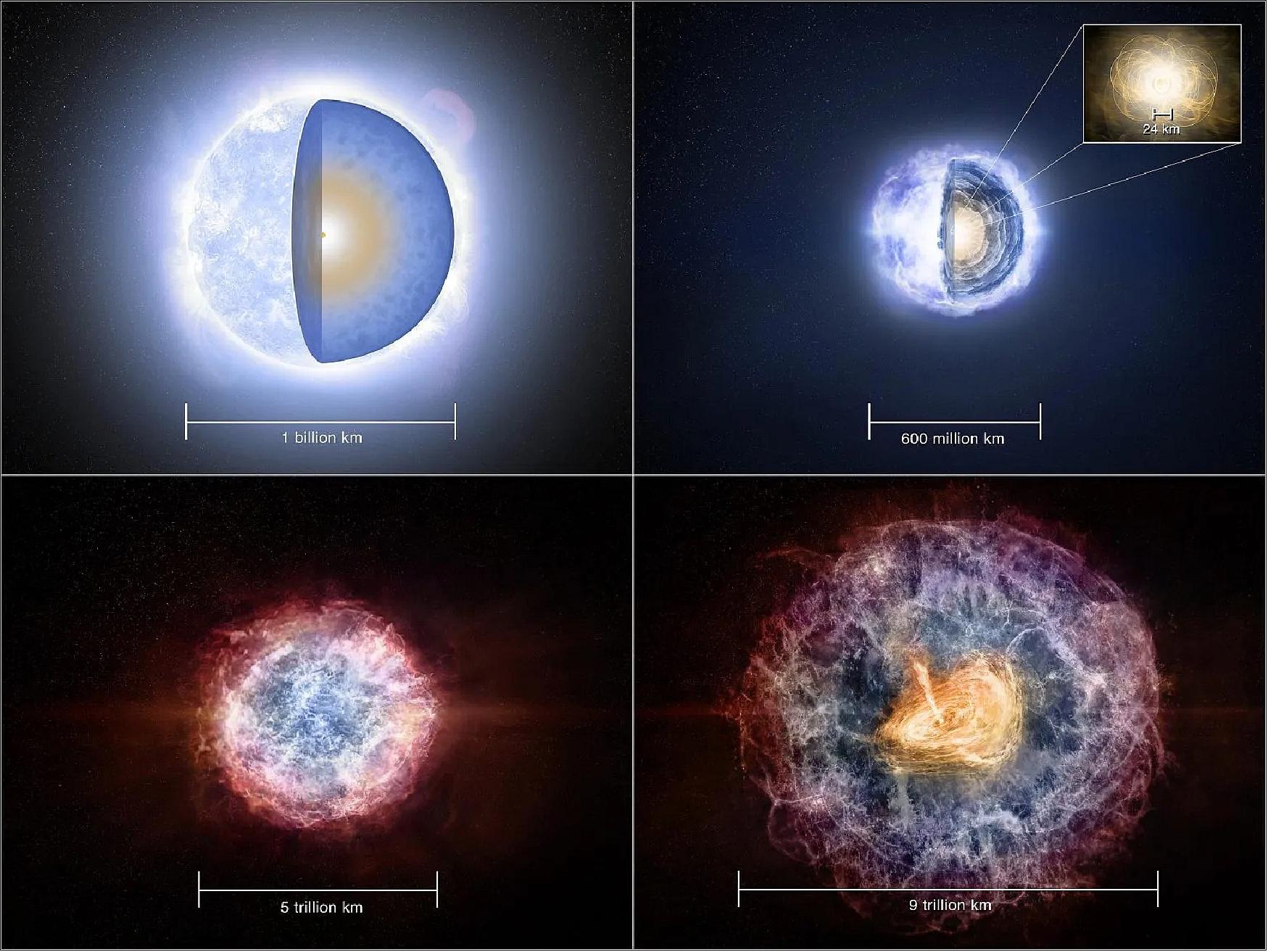
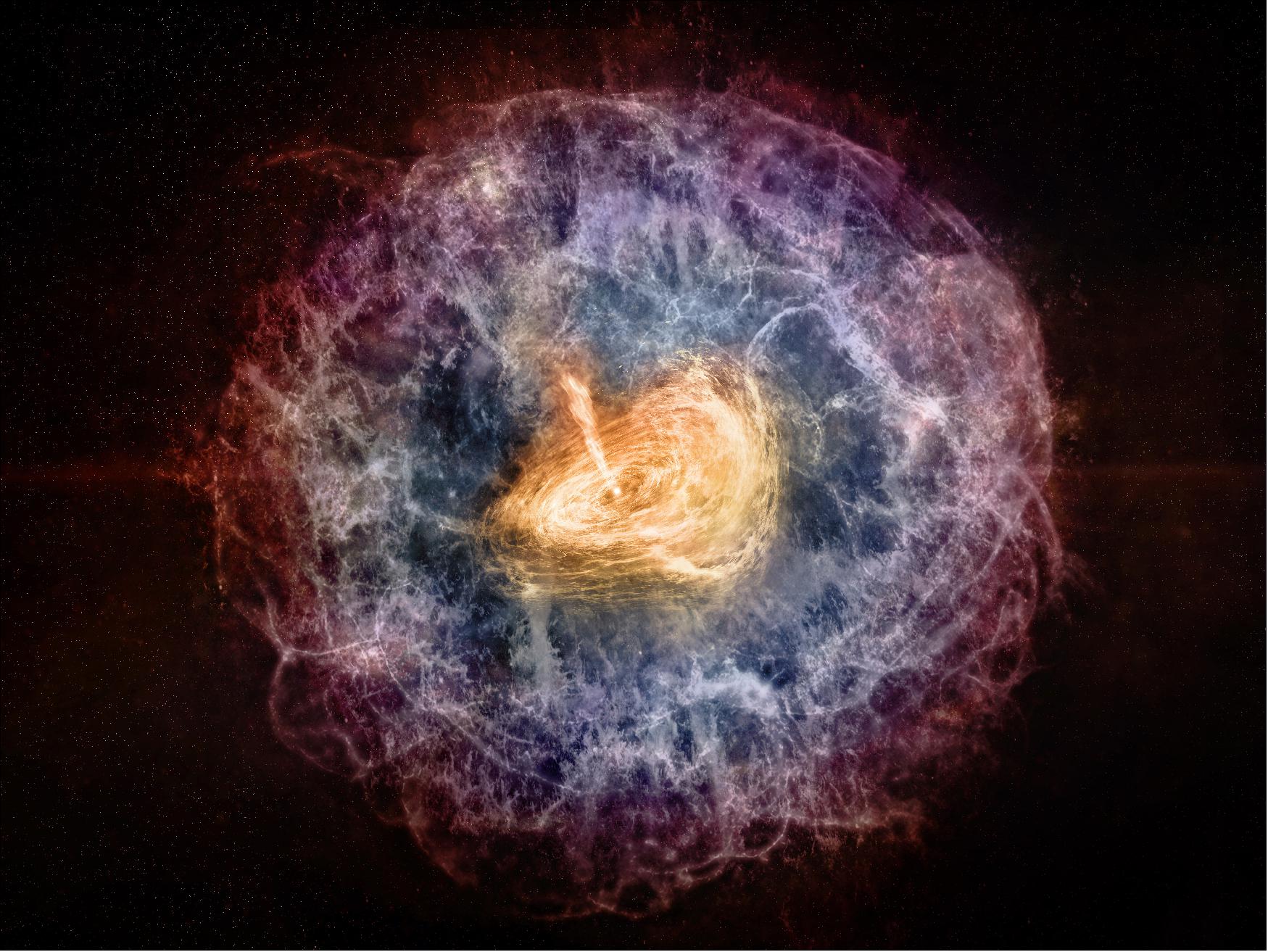
- Initially, the radio emission was blocked from view by the shell of explosion debris. As that shell expanded, it became progressively less dense until eventually the radio waves from the pulsar wind nebula could pass through.
- “This happened between the FIRST observation in 1998 and the VLASS observation in 2018,” Hallinan said.
- Probably the most famous example of a pulsar wind nebula is the Crab Nebula in the constellation Taurus, the result of a supernova that shone brightly in the year 1054. The Crab is readily visible today in small telescopes.
- “The object we have found appears to be approximately 10,000 times more energetic than the Crab, with a stronger magnetic field,” Dong said. “It likely is an emerging ‘super Crab’,” he added.
- While Dong and Hallinan consider VT 1137-0337 to most likely be a pulsar wind nebula, it also is possible that its magnetic field may be strong enough for the neutron star to qualify as a magnetar — a class of super-magnetic objects. Magnetars are a leading candidate for the origin of the mysterious Fast Radio Bursts (FRBs) now under intense study.
- “In that case, this would be the first magnetar caught in the act of appearing, and that, too, is extremely exciting,” Dong said.
- Indeed some Fast Radio Bursts have been found to be associated with persistent radio sources, the nature of which also is a mystery. They bear a strong resemblance in their properties to VT 1137-0337, but have shown no evidence of strong variability.
- “Our discovery of a very similar source switching on suggests that the radio sources associated with FRBs also may be luminous pulsar wind nebulae,” Dong said.
- The astronomers plan to conduct further observations to learn more about the object and to monitor its behavior over time.
- The National Radio Astronomy Observatory is a facility of the National Science Foundation, operated under cooperative agreement by Associated Universities, Inc.
• April 25, 2022: Scientists discovered that post-starburst galaxies condense their gas rather than expelling it, begging the question: what’s actually keeping them from forming stars? 11)
- In most galaxies, scientists expect gas to be distributed in a way similar to starlight. But for post-starburst galaxies, or PSBs, this isn’t the case. PSBs are different from other galaxies because they are born in the aftermath of violent collisions, or mergers between galaxies. Galaxy mergers typically trigger massive bursts of star formation, but in PSBs, this outburst slows down and near-completely stops almost as soon as it begins. As a result, scientists previously believed that little or no star-forming fuel was left in these galaxies’ central star-forming factories. And until now, the belief was that the molecular gases had been redistributed to radii well beyond the galaxies, either through stellar processes or by the effects of black holes. The new results challenge this theory.
- “We’ve known for some time that large amounts of molecular gas remains in the vicinity of PSBs but haven’t been able to say where, which in turn, has prevented us from understanding why these galaxies stopped forming stars. Now, we have discovered a considerable amount of remaining gas within the galaxies and that remaining gas is very compact,” said Adam Smercina, an astronomer at the University of Washington and the principal investigator of the study. “While this compact gas should be forming stars efficiently, it isn’t. In fact, it is less than 10-percent as efficient as similarly compact gas is expected to be.”
- In addition to being compact enough to make stars, the gas in the observed dormant—or quiescent—galaxies had another surprise in store for the team: it was often centrally-located, though not always, and was surprisingly turbulent. Combined, these two characteristics led to more questions than answers for researchers.
- “The rates of star formation in the PSBs we observed are much lower than in other galaxies, even though there appears to be plenty of fuel to sustain the process,” said Smercina. “In this case, star formation may be suppressed due to turbulence in the gas, much like a strong wind can suppress a fire. However, star formation can also be enhanced by turbulence, just like wind can fan flames, so understanding what is generating this turbulent energy, and how exactly it is contributing to dormancy, is a remaining question of this work.”
- Decker French, an astronomer at the University of Illinois, and a co-author of the research added, “These results raise the question of what energy sources are present in these galaxies to drive turbulence and prevent the gas from forming new stars. One possibility is energy from the accretion disk of the central supermassive black holes in these galaxies.”
- A clear understanding of the processes that govern the formation of stars and galaxies is key to providing context to the Universe and our place in it. The discovery of turbulent, compact gas in otherwise dormant galaxies gives researchers one more clue to solving the mystery of how galaxies in particular live, evolve and die over the course of billions of years. And that means additional future research with the help of ALMA’s 1.3mm receiver, which sees the otherwise invisible with stark clarity.
![Figure 11: Post-starburst galaxies, or PSBs, were previously thought to expel all of their gas in violent outbursts, leading to quiescence, a time when galaxies stop forming stars. But scientists using the Atacama Large Millimeter/submillimeter Array (ALMA) found that instead, PSBs condense and hold onto this turbulent gas, and then don’t use it to form stars. This artist’s impression highlights the compactness of molecular gas in a PSB and its lack of star formation [image credit: ALMA (ESO/NAOJ/NRAO)/S. Dagnello (NRAO/AUI/NSF)]](https://www.eoportal.org/ftp/satellite-missions/n/NRAO_270622/NRAO_Auto39.jpeg)
- J.D. Smith, an astronomer at the University of Toledo, and a co-author of the research said, “There is much about the evolution of a typical galaxy we don’t understand, and the transition from their vibrant star-forming lives into quiescence is one of the least understood periods. Although post-starbursts were very common in the early Universe, today they are quite rare. This means the nearest examples are still hundreds of millions of light-years away, but these events foreshadow the potential outcome of a collision, or merger, between the Milky Way Galaxy and the Andromeda Galaxy several billion years from now. Only with the incredible resolving power of ALMA could we peer deep into the molecular reservoirs left behind ‘after the fall.’”
- Smercina added, “It’s often the case that we as astronomers intuit the answers to our own questions ahead of observations, but this time, we learned something completely unexpected about the Universe.”
- The results of the study are published today in The Astrophysical Journal. 12)
• November 22, 2021: A system designed to provide data from the National Science Foundation’s Karl G. Jansky Very Large Array (VLA) for analysis in the Search for Extraterrestrial Intelligence (SETI) has successfully acquired data from a VLA antenna. The system — dubbed COSMIC (Commensal Open Source Multimode Interferometer Cluster), is designed to receive data from a newly-developed parallel Ethernet interface to the VLA, using the same data stream used for other research but analyzed in parallel by COSMIC. 13)
- “As soon as the cabling was physically connected, our interface locked on to the VLA data streams and we were able to grab some preliminary data,” said Dr. Jack Hickish, of the SETI Institute and Real-Time Radio Systems Limited, who is leading development of the COSMIC system.
- The National Radio Astronomy Observatory (NRAO) and the SETI Institute agreed last year to collaborate on developing and installing the COSMIC system at the VLA. COSMIC, funded by the SETI Institute, will analyze data from the VLA to identify transmissions possibly generated by extraterrestrial technologies.
- “As the VLA goes about its normal observing, this system will allow an additional and valuable use for the data we’re already collecting. We’re happy to see this important milestone, and congratulate the SETI Institute and NRAO personnel who achieved it,” said NRAO Director Tony Beasley.
- The initial success with a single VLA antenna clears the way for buildup of the additional hardware required to capture data from all 27 VLA antennas. In addition, the equipment that will do the actual SETI signal analysis still is under development. Full scientific operations of COSMIC are expected to begin in January of 2023.
- The complete system “will allow us to conduct a powerful, wide-area SETI survey that will be vastly more complete than any previous such search,” according to Andrew Siemion, Bernard M. Oliver Chair for SETI at the SETI Institute and Principal Investigator for the Breakthrough Listen Initiative at the University of California, Berkeley.
- The National Radio Astronomy Observatory is a facility of the National Science Foundation, operated under cooperative agreement by Associated Universities, Inc.
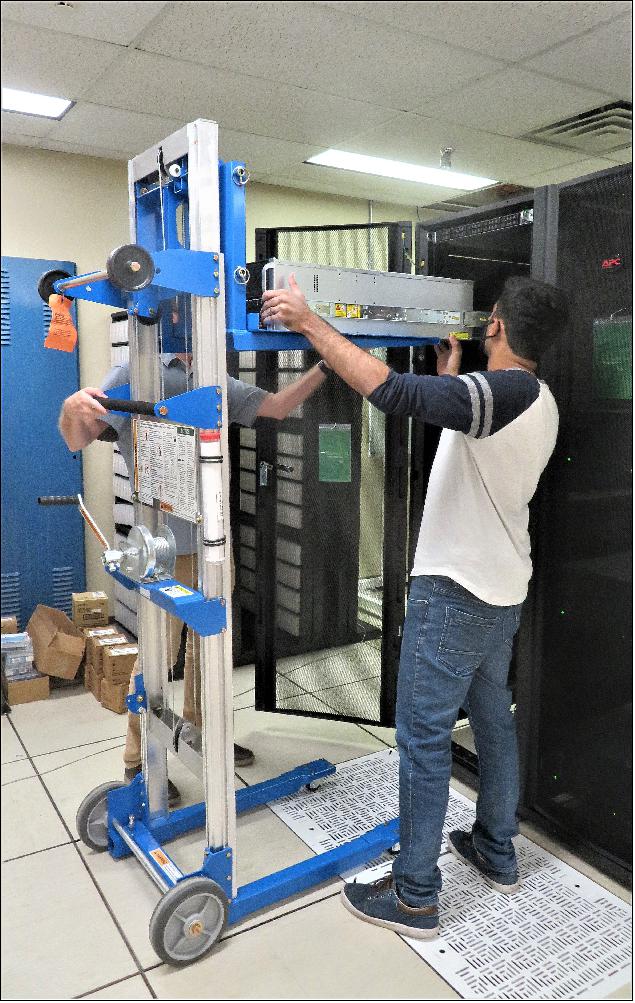
• November 4, 2021: The Astronomy and Astrophysics Decadal Survey (Astro2020) of the U.S. National Academy of Sciences has published its report and the Next Generation Very Large Array (ngVLA) received high priority for new ground-based observatories to be constructed during the coming decade. The report, in which ngVLA shared second ranking among ground-based projects, was the culmination of a lengthy process aimed at developing a comprehensive research strategy and vision for a decade of transformative science at the frontiers of astronomy and astrophysics. 14)
- The ngVLA is a system of 263 dish antennas spread across the entire extent of North America and concentrated in the U.S. Southwest that will provide dramatic new scientific capabilities to the world’s astronomers. The Astro2020 report led the ground-based facility list with the U.S. Extremely Large Telescope Project (US-ELT), a plan for two large optical telescopes — the Thirty Meter Telescope and the Giant Magellan Telescope, both under different stages of construction. After US-ELT, equal priority was given for development and construction for the ngVLA and the Cosmic Microwave Background Stage-4 experiment (CMB-S4).
- “Being ranked as an important new initiative indicates that our colleagues from all specialties within astronomy and astrophysics have recognized that they need the ngVLA to meet the leading research challenges of the coming decades. We designed the ngVLA based on extensive advice from the research community and know it will be in high demand by scientists from around the world,” said NRAO Director Tony Beasley.
- With the publication of the Astro2020 report, the ngVLA next will require approval by the National Science Foundation’s National Science Board and funding by Congress. Construction could begin by 2026 with early scientific observations starting in 2029 and full scientific operations by 2035.
- “The high scientific priority given to the ngVLA reflects the breadth and depth of the science that it makes possible, from the formation of exoplanets, to testing relativity using pulsars and black holes, to the study of some of the earliest galaxies in the Universe. This high ranking is a strong endorsement, and it opens the door to the U.S. continuing its leadership in radio astronomy and thus astrophysics as a whole for decades to come,” said Alberto Bolatto, co-chair of the ngVLA Science Advisory Council and a Professor of Astronomy at the University of Maryland, College Park.
- “This Astro2020 outcome is a direct result of the close collaboration between NRAO and the greater astronomical community in developing both the broad, transformative science case and technical design of the ngVLA over the last five-plus years,” said Eric Murphy, NRAO’s Project Scientist for ngVLA. “All of the community’s hard work has clearly paid off and we now look forward to continuing this collaboration as we finalize the design and move toward achieving first light with the ngVLA,” Murphy added.
- The ngVLA is designed to have sensitivity to detect faint objects and resolving power — ability to see fine detail — more than 10 times greater than the current VLA. It can address fundamental questions in all major areas of astrophysics. The ngVLA’s capabilities will complement those of the Atacama Large Millimeter/submillimeter Array (ALMA) and other planned instruments such as the lower-frequency Square Kilometer Array. It also will complement the capabilities of the US-ELT optical telescopes and the orbiting James Webb Space Telescope, which will operate at infrared wavelengths and is scheduled for launch next month.
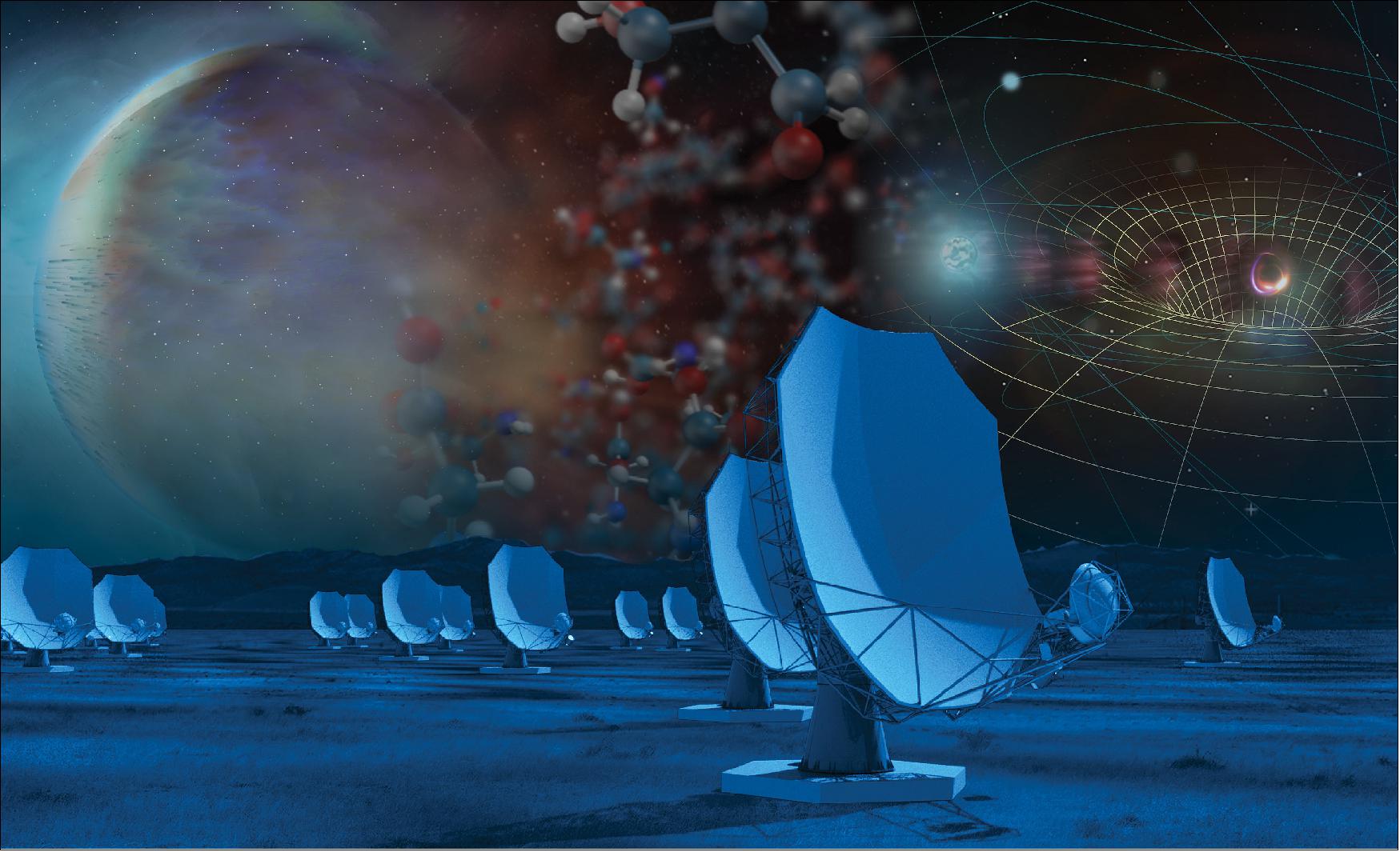
- The ngVLA is a resource for all astronomers, regardless of their institution or background. It will be accessible to all segments of the research community. Anyone will be able to submit an observing proposal to take advantage of the ngVLA’s advanced capabilities for frontier science.
- The Astro 2020 report said, “The ngVLA facility would be absolutely unique worldwide in both sensitivity and frequency coverage,” and concludes that “It is of essential importance to astronomy that the VLA and Very Long Baseline Array be replaced by an observatory that can achieve roughly an order of magnitude improvement in sensitivity compared to these facilities, with the ability to image radio sources on scales of arcminutes to fractions of a milliarcsecond.”
- “We congratulate the US-ELT and CMB-S4 teams for their strong proposals, and look forward to working alongside them, the research community and the National Science Foundation to provide astronomers with the advanced, multiwavelength suite of research tools needed to meet the challenges of 21st-Century astrophysics, as outlined in the Astro2020 report,” Beasley said. “We appreciate the tremendous amount of work that went into producing the Astro2020 report, including many members of the scientific community and particularly the tireless efforts of the chairs and the steering committees,” he added.
- The ngVLA will have a dense core of antennas and a signal processing center at the current site of the VLA on the Plains of San Agustin in New Mexico. The system will include other antennas located throughout New Mexico and in west Texas, eastern Arizona, and northern Mexico. More far-flung antennas will be located in clusters in Hawaii, Washington, California, Iowa, West Virginia, New Hampshire, Puerto Rico (at Arecibo Observatory), the U.S. Virgin Islands, and Canada. Operations will be conducted at the VLA site and in nearby Socorro, New Mexico, with additional science operations in a metropolitan area to be determined.
- The NRAO has received $23 million in funding from the National Science Foundation for design and development work on the ngVLA’s antennas, and in May, NRAO officials signed an agreement with the German firm mtex antenna technology GmbH to develop a production-ready design and produce a prototype ngVLA antenna.
- Adam Cohen, president of Associated Universities, Inc. (AUI), which operates the NRAO, said, “We are excited by this strong endorsement of ngVLA by the research community and look forward to continuing AUI’s nearly seven-decade record of developing and providing some of the world’s finest telescopes for the advancement of astronomy. We greatly appreciate the National Science Foundation’s support for the initial stages of the ngVLA and are eager to work with them to make this outstanding facility a reality.”
- Earlier this year, the Canadian Astronomy Long Range Plan 2020-2030, a report on priorities and recommendations for Canadian astronomy over the next decade, recommended that Canada support the ngVLA. That panel recommended that Canada provide $130 million toward ngVLA construction and $6 million per year for operating the facility. A plan for Japanese contribution to the ngVLA is one of the major proposals under consideration by that nation’s scientific community to become part of the Master Plan 2023 of the Science Council of Japan.
- The ngVLA’s design is the result of extensive collaboration with researchers across the landscape of astrophysics. Through a series of workshops and science meetings beginning in 2015, NRAO worked with numerous scientists and engineers to develop a design that will support a wide breadth of scientific investigations over the lifetime of the facility. Participants from around the world contributed suggestions and expertise that helped guide the design.
- The National Radio Astronomy Observatory is a facility of the National Science Foundation, operated under cooperative agreement by Associated Universities, Inc.
• November 3, 2021: Water has been detected in the most massive galaxy in the early Universe, according to new observations from the Atacama Large Millimeter/submillimeter Array (ALMA). Scientists studying SPT0311-58 found H20, along with carbon monoxide in the galaxy, which is located nearly 12.88 billion light-years from Earth. Detection of these two molecules in abundance suggests that the molecular Universe was going strong shortly after the elements were forged in early stars. The new research comprises the most detailed study of molecular gas content of a galaxy in the early Universe to date and the most distant detection of H20 in a regular star-forming galaxy. The research is published in The Astrophysical Journal. 15) 16)
- SPT0311-58 is actually made up of two galaxies and was first seen by ALMA scientists in 2017 at its location, or time, in the Epoch of Reionization. This epoch occurred at a time when the Universe was just 780 million years old—roughly 5-percent of its current age—and the first stars and galaxies were being born. Scientists believe that the two galaxies may be merging, and that their rapid star formation is not only using up their gas, or star-forming fuel but that it may eventually evolve the pair into massive elliptical galaxies like those seen in the Local Universe.
- “Using high-resolution ALMA observations of molecular gas in the pair of galaxies known collectively as SPT0311-58 we detected both water and carbon monoxide molecules in the larger of the two galaxies. Oxygen and carbon, in particular, are first-generation elements, and in the molecular forms of carbon monoxide and water, they are critical to life as we know it,” said Sreevani Jarugula, an astronomer at the University of Illinois and the principal investigator on the new research. “This galaxy is the most massive galaxy currently known at high redshift, or the time when the Universe was still very young. It has more gas and dust compared to other galaxies in the early Universe, which gives us plenty of potential opportunities to observe abundant molecules and to better understand how these life-creating elements impacted the development of the early Universe.”
- Water, in particular, is the third most abundant molecule in the Universe after molecular hydrogen and carbon monoxide. Previous studies of galaxies in the local and early Universe have correlated water emission and the far-infrared emission from dust. “The dust absorbs the ultraviolet radiation from the stars in the galaxy and re-emits it as far-infrared photons,” said Jarugula. “This further excites the water molecules, giving rise to the water emission that scientists are able to observe. In this case, it helped us to detect water emissions in this massive galaxy. This correlation could be used to develop water as a tracer of star formation, which could then be applied to galaxies on a cosmological scale.”
![Figure 14: This artist’s conception shows the dust continuum and molecular lines of carbon monoxide and water seen in the pair of galaxies known as SPT0311-58. ALMA data reveals abundant CO and H20 in the larger of the two galaxies, indicating that the molecular Universe was going strong shortly after the elements were initially forged [image credit: ALMA (ESO/NAOJ/NRAO)/S. Dagnello (NRAO)]](https://www.eoportal.org/ftp/satellite-missions/n/NRAO_270622/NRAO_Auto36.jpeg)
- Studying the first galaxies to form in the Universe helps scientists to better understand the birth, growth, and evolution of the Universe, and everything in it, including the Solar System and Earth. “Early galaxies are forming stars at a rate thousands of times that of the Milky Way, said Jarugula. “Studying the gas and dust content of these early galaxies informs us of their properties, such as how many stars are being formed, the rate at which gas is converted into stars, how galaxies interact with each other and with the interstellar medium, and more.”
- According to Jarugula, there’s plenty left to learn about SPT0311-58 and the galaxies of the early Universe. “This study not only provides answers about where, and how far away, water can exist in the Universe but also has given rise to a big question: How has so much gas and dust assembled to form stars and galaxies so early in the Universe? The answer requires further study of these and similar star-forming galaxies to get a better understanding of the structural formation and evolution of the early Universe.”
- “This exciting result, which shows the power of ALMA, adds to a growing collection of observations of the early Universe,” said Joe Pesce, astrophysicist and ALMA Program Director at the National Science Foundation. “These molecules, important to life on Earth, are forming as soon as they can, and their observation is giving us insight into the fundamental processes of a Universe very much different from today’s.”
• September 21, 2021: The National Science Foundation’s Green Bank Observatory (GBO) and National Radio Astronomy Observatory (NRAO), and Raytheon Intelligence & Space (RI&S) have released a new high-resolution image of the Moon, the highest-ever taken from the ground using new radar technology on the Green Bank Telescope (GBT). 17)
- The resolution of the new Tycho Crater image is close to five meters by five meters and contains approximately 1.4 billion pixels. The image covers an area of 200 km x 175 km, ensuring that involved scientists and engineers captured the entire crater, which measures 86 km in diameter. “This is the largest SAR (Synthetic Aperture Radar) image we have produced to date with the help of our partners at Raytheon,” said Dr. Tony Beasley, Director of the National Radio Astronomy Observatory, and vice president for Radio Astronomy at Associated Universities, Inc. (AUI). “While more work lies ahead to improve these images, we’re excited to share this incredible image with the public, and look forward to sharing more images from this project in the near future.”
- The GBT— the world’s largest fully steerable radio telescope—was outfitted in late 2020 with new technology developed by Raytheon Intelligence & Space and GBO, allowing it to transmit a radar signal into space. Using the GBT and antennas from the Very Long Baseline Array (VLBA), several tests have been conducted since that time, focusing on the surface of the Moon, including the Tycho Crater and NASA Apollo landing sites.
- How is this low-powered radar signal translated into images we can see? “It’s done with a process called Synthetic Aperture Radar, or SAR,” explained Galen Watts, a GBO engineer. “As each pulse is transmitted by the GBT, it’s reflected off the target, the surface of the moon in this case, and it’s received and stored. The stored pulses are compared to each other and analyzed to produce an image. The transmitter, the target, and the receivers are all constantly moving as we move through space. While you might think this could make producing an image more difficult, it actually yields more important data.”
- This movement causes slight differences from radar pulse to pulse. These differences are examined and used to compute an image resolution higher than what is possible with stationary observations, as well as to increase the resolution of the distance to the target, how fast the target is moving toward or away from the receiver, and how the target is moving across the field of view. “Radar data like this has never been recorded before at this distance or resolution,” said Watts. “This has been done before at distances of a few hundred km, but not on the hundreds of thousands of kilometers scales of this project, and not with the high resolutions of a meter or so at these distances. It all takes a lot of computing hours. Ten or so years ago it would have taken months of computing to get one of the images from one receiver, and maybe a year or more from more than one.”
- These promising early results have garnered support for the project from the scientific community and in late September the collaboration received $4.5 million in funding from the National Science Foundation for designing ways the project could be extended (Mid-scale Research Infrastructure-1 design award AST-2131866). “After those designs, if we can attract full funding support, we will be able to build a system hundreds of times more powerful than the current one and use it to explore the Solar System,” said Beasley. “Such a new system would open a window into the Universe, allowing us to see our neighboring planets and celestial objects in a whole new way.”
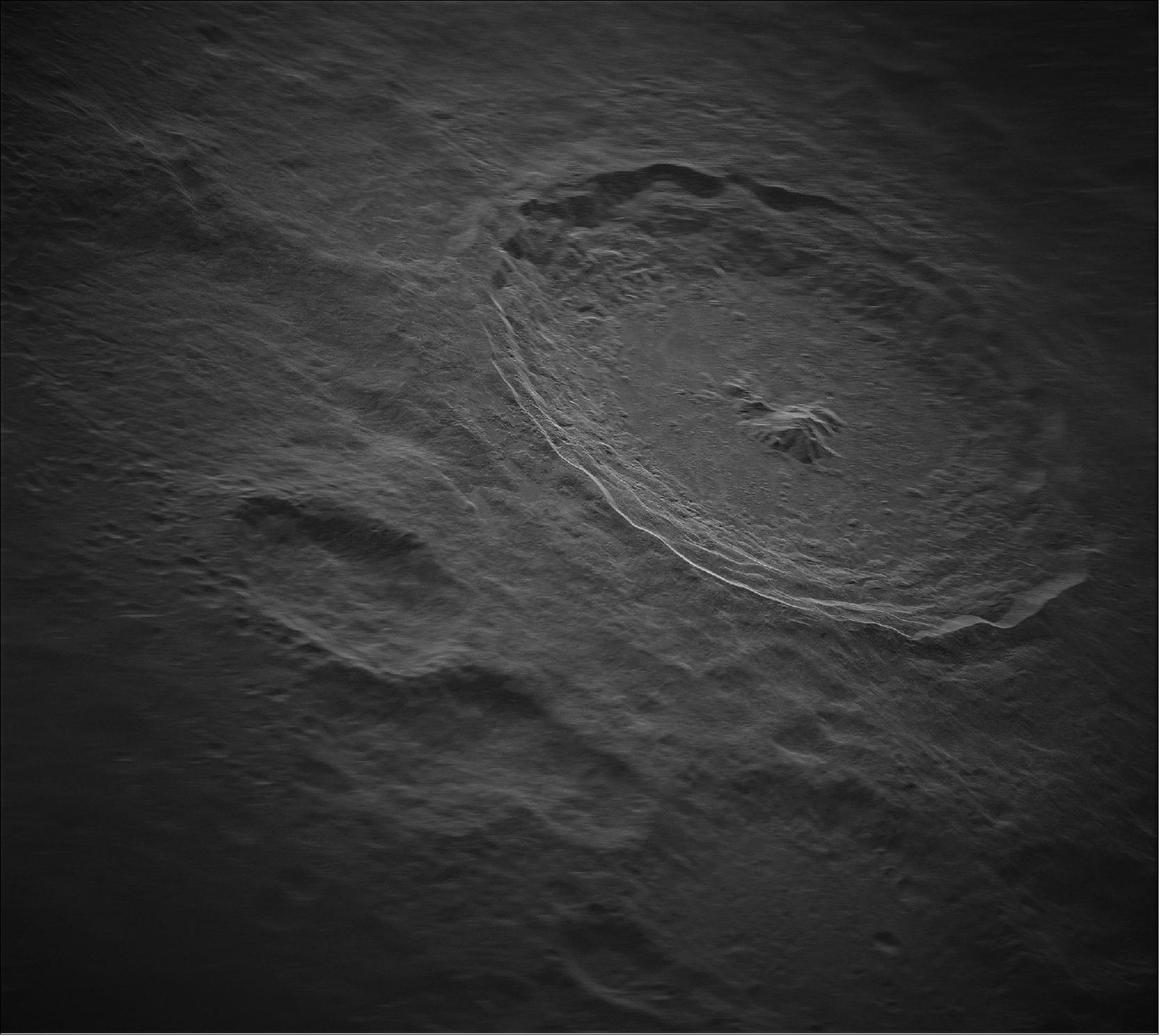
- West Virginia has a long history of facilities that have made significant contributions to expanding our scientific knowledge of the Universe. West Virginia Senator Joe Manchin III shared, “The new images and details of the Tycho Crater on the Moon found using radar technology on the Green Bank Telescope show that incredible advances in science are being made right here in West Virginia. For more than two decades, the GBT has helped researchers explore and better understand the Universe. Through my seat on the Commerce, Justice and Science Appropriations Subcommittee, I have been strongly supportive of these technological advances at GBT, which will now allow the GBT to transmit radar signals to space and ensure its critical role in astronomy research for years to come. I look forward to seeing more incredible images and future discoveries of our Solar System, and I will continue to work with the National Science Foundation to advocate for funding to support projects at the Green Bank Observatory.
- This technology has been years in the making, part of a cooperative research and development agreement between NRAO, GBO, and RI&S. A future high-power radar system combined with the sky coverage of the GBT will image objects in the Solar System with unprecedented detail and sensitivity. Expect more exciting images to come this fall, as processing these early data with tens of billions of pixels of information is worth the wait.
- The National Radio Astronomy Observatory and the Green Bank Observatory are facilities of the National Science Foundation, operated under cooperative agreement by Associated Universities, Inc.
• September 15, 2021: An international collaboration of scientists using ALMA ( Atacama Large Millimeter/submillimeter Array) has completed the most extensive chemical composition mapping of the protoplanetary disks around five nearby young stars at high resolution, producing images that capture the molecular composition associated with planetary births, and a roadmap for future studies of the makeup of planet- and comet-forming regions. The new study unlocks clues about the role of molecules in planetary system formation, and whether these young planetary systems in the making have what it takes to host life. The results of the program, appropriately called MAPS (Molecules with ALMA at Planet-forming Scales), will appear in an upcoming 20-paper special edition of The Astrophysical Journal Supplement Series. 18)
- Planets form in the disks of dust and gas—also called protoplanetary disks—surrounding young stars. The chemical makeup of—or molecules contained within—these disks may have an impact on the planets themselves, including how and where planetary formation occurs, the chemical composition of the planets, and whether those planets have the organic composition necessary to support life. MAPS specifically looked at the protoplanetary disks surrounding the young stars IM Lup, GM Aur, AS 209, HD 163296, and MWC 480, where evidence of ongoing planet formation has already been detected. The project led to multiple exciting discoveries, including a link between dust and chemical substructures and the presence of large reservoirs of organic molecules in the inner disk regions of the stars.
- “With ALMA we were able to see how molecules are distributed where exoplanets are currently assembling,” said Karin Öberg, an astronomer at the Center for Astrophysics | Harvard & Smithsonian (CfA) and the Principal Investigator for MAPS. “One of the really exciting things we saw is that the planet-forming disks around these five young stars are factories of a special class of organic molecules, so-called nitriles, which are implicated in the origins of life here on Earth.”
- Simple organic molecules like HCN, C2H, and H2CO were observed throughout the project in unprecedented detail, thanks to the sensitivity and resolving power of ALMA’s Band 3 and Band 6 receivers. “In particular, we were able to observe the amount of small organic molecules in the inner regions of disks, where rocky planets are likely assembling,” said Viviana V. Guzmán, an astronomer at Pontificia Universidad Católica de Chile’s Instituto de Astrofísica, lead author on MAPS VI and a MAPS co-Principal Investigator. “We’re finding that our own Solar System is not particularly unique, and that other planetary systems around other stars have enough of the basic ingredients to form the building blocks of life.”
- Scientists also observed more complex organic molecules like HC3N, CH3CN, and c-C3H2—notably those containing carbon, and therefore most likely to act as the feedstock of larger, prebiotic molecules. Although these molecules have been detected in protoplanetary disks before, MAPS is the first systematic study across multiple disks at very high spatial resolution and sensitivity, and the first study to find the molecules at small scales and in such significant quantities. “We found more of the large organic molecules than expected, a factor of 10 to 100 more, located in the inner disks on scales of the Solar System, and their chemistry appears similar to that of Solar System comets,” said John Ilee, an astronomer at the University of Leeds and the lead author of MAPS IX. “The presence of these large organic molecules is significant because they are the stepping-stones between simpler carbon-based molecules such as carbon monoxide, which is found in abundance in space, and the more complex molecules that are required to create and sustain life.”
![*Figure 16: This composite image of ALMA data from the young star HD 163296 shows hydrogen cyanide e*mission laid over a starfield. The MAPS project zoomed in on hydrogen cyanide and other organic and inorganic compounds in planet-forming disks to gain a better understanding of the compositions of young planets and how the compositions link to where planets form in a protoplanetary disk [image credit: ALMA (ESO/NAOJ/NRAO)/D. Berry (NRAO), K. Öberg et al. (MAPS)]](https://www.eoportal.org/ftp/satellite-missions/n/NRAO_270622/NRAO_Auto34.jpeg)
- Molecules are not distributed uniformly across planet-forming disks, however, as evidenced in MAPS III and IV, which revealed that while the general disk compositions appear to be similar to the Solar System, zooming in at high resolution reveals some diversity in composition that could result in planet-to-planet differences. “Molecular gas in protoplanetary disks is often found in sets of distinct rings and gaps,” said Charles Law, CfA astronomer and lead author on MAPS III and IV. “But the same disk observed in different molecular emission lines often looks completely different, with each disk having multiple molecular faces. This also means that planets in different disks or even in the same disk at different locations may form in radically different chemical environments.” This means that some planets form with the necessary tools for building and sustaining life while other nearby planets may not.
- One of those radically different environments occurs in the space surrounding Jupiter-like planets, where scientists found the gas to be poor in carbon, oxygen, and heavier elements, while rich in hydrocarbons, such as methane. “The chemistry that is seen in protoplanetary disks should be inherited by forming planets,” said Arthur Bosman, an astronomer at the University of Michigan and lead author of MAPS VII. “Our findings suggest that many gas giants may form with extremely oxygen-poor (carbon-rich) atmospheres, challenging current expectations of planet compositions.”
- Taken all together, MAPS is providing exactly that: a map for scientists to follow, connecting the dots between the gas and dust in a protoplanetary disk and the planets that eventually form from them to create a planetary system. “A planet’s composition is a record of the location in the disk in which it was formed,” said Bosman. “Connecting planet and disk composition enables us to peer into the history of a planet and helps us to understand the forces that formed it.”
- Joe Pesce, astronomer and ALMA program officer at the National Science Foundation (NSF) notes, “Whether life exists beyond Earth is one of humanity’s fundamental questions. We now know planets are found everywhere, and the next step is to determine if they have the conditions necessary for life as we know it (and how common that situation might be). The MAPS program will help us better answer these questions. ALMA’s search for precursors to life far from Earth complements studies conducted in laboratories, and in places like hydrothermal vents on Earth.”
- Öberg added, “MAPS is the culmination of decades of work on the chemistry of planet-forming disks by scientists using ALMA and its precursors. Although MAPS has surveyed just five disks at this time, we had no idea how chemically complex and visually stunning these disks really were until now. MAPS has first answered questions we could not have imagined asking decades ago, and also presented us with many more questions to answer.” 19) 20)
• August 9, 2021: The NSF (National Science Foundation) has awarded the National Radio Astronomy Observatory (NRAO) $23 million for design and development work on the Next Generation Very Large Array (ngVLA), including producing a prototype antenna. The ngVLA, a powerful radio telescope with 263 dish antennas distributed across North America, is proposed as one of the next generation of cutting-edge astronomical observatories (see Figure 22). 21)
- “The ngVLA will be a key tool for answering the important scientific questions facing astronomers in the coming decades. We welcome this vital support for the next step — building the first antenna — toward making this exciting research facility a reality,” said NRAO Director Tony Beasley.
- The ngVLA will include 244 antennas that are 18 m (59 feet) in diameter, with an additional 19, 6 m (20-foot) dishes at the center of the system.
- The ngVLA project currently is under review by the Astronomy and Astrophysics Decadal Survey (Astro2020) of the U.S. National Academy of Sciences. That report is expected soon. Following that report, the project will need approval by the National Science Foundation’s National Science Board and funding by Congress. Construction could begin by 2026 with early scientific observations starting in 2029 and full scientific operations by 2035.
- “This exciting project marks the beginning of a new era, and major milestone, in antenna technology,” said Joseph Pesce, NRAO Program Officer at the NSF. “While we look forward to the results from the Astro2020 Decadal Survey in regard to ngVLA, we expect this is the antenna of the future and will be used well beyond any one project,” he added.
- On May 27, NRAO officials signed an agreement with the firm mtex antenna technology Gmbh of Germany to develop a production-ready design and produce the prototype 18-meter antenna. Once built, the 18-meter prototype will be installed at the site of NSF’s Karl G. Jansky Very Large Array (VLA) in west-central New Mexico, where it will undergo extensive testing.
- Building on the scientific and technical legacies of the VLA and the Atacama Large Millimeter/submillimeter Array (ALMA), the ngVLA will have sensitivity to detect faint objects and resolving power — ability to see fine detail — more than 10 times greater than the current VLA. It is being designed to address fundamental questions in all major areas of astrophysics and provide a major leap forward in our understanding of phenomena such as planets, galaxies, black holes, and the dynamic sky. The ngVLA’s capabilities will complement those of ALMA and other planned instruments such as the lower-frequency Square Kilometer Array.
- “The ngVLA will fit neatly into a suite of current and planned observatories that will operate over the next decades, offering the entire astronomical community vital capabilities unmatched by any other telescope system,” said Mark McKinnon, ngVLA Project Director.
- “Strengthening New Mexico’s leadership in radio astronomy is going to take an ambitious vision. I am so pleased to see this funding positioned to help jumpstart the Next Generation Very Large Array project so that the National Radio Astronomy Observatory, with offices present at New Mexico Tech, can begin their work to enhance America’s world-renowned scientific research infrastructure across the U.S. – and right here in New Mexico. I will continue fighting for similar funding that creates career opportunities within New Mexico’s science community and keeps our state at the cutting edge of space research and technology,” said U.S. Senator Martin Heinrich (D-NM).
- “New Mexico is a national leader in innovation and scientific discovery, and I’m pleased to see the National Science Foundation supporting the design and development of NRAO’s Next Generation Very Large Array, a project that will foster further discoveries. As a new member of the Senate Committee on Commerce, Science, and Transportation, I’ll continue working to secure strong investments that shore up our state’s science and technology economy,” said U.S Senator Ben Ray Luján (D-NM).
- “I am excited to see the National Science Foundation has awarded funding to develop the Next Generation Very Large Array,” said Congresswoman Yvette Herrell (R-NM). “This new radio telescope, parts of which will be located right here in New Mexico, will be instrumental in gaining a better understanding of our universe. I am proud New Mexico will be at the forefront of this innovative advancement in the field of astronomy.”
- The ngVLA will have a dense core of antennas and a signal processing center at the current site of the VLA on the Plains of San Agustin in New Mexico. The system will include other antennas located throughout New Mexico and in west Texas, eastern Arizona, and northern Mexico. More far-flung antennas will be located in clusters in Hawaii, Washington, California, Iowa, West Virginia, New Hampshire, Puerto Rico (at Arecibo Observatory), the U.S. Virgin Islands, and Canada. Operations will be conducted at the VLA site and in nearby Socorro, New Mexico, with additional science operations in a metropolitan area to be determined.
- The ngVLA’s design is the result of extensive collaboration with researchers across the landscape of astrophysics. Through a series of workshops and science meetings beginning in 2015, NRAO worked with numerous scientists and engineers to develop a design that will support a wide breadth of scientific investigations over the lifetime of the facility. Participants from around the world contributed suggestions and expertise that helped guide the design.
- “We heard from many of our scientific colleagues about how they want to use such a next-generation radio telescope, and worked hard to build a consensus on its capabilities to support their needs. We continue to get valuable advice and support from those who serve on our ngVLA science and technical councils,” said Eric Murphy, NRAO’s Project Scientist for ngVLA.
- The National Radio Astronomy Observatory is a facility of the National Science Foundation, operated under cooperative agreement by Associated Universities, Inc.
• July 22, 2021: Astronomers using two of the world’s most powerful radio telescopes have made a detailed and sensitive survey of a large segment of our home galaxy — the Milky Way — detecting previously unseen tracers of massive star formation, a process that dominates galactic ecosystems. The scientists combined the capabilities of the National Science Foundation’s Karl G. Jansky Very Large Array (VLA) and the 100-meter Effelsberg Telescope in Germany to produce high-quality data that will serve researchers for years to come. 22) 23)
- Stars with more than about ten times the mass of our Sun are important components of the Galaxy and strongly affect their surroundings. However, understanding how these massive stars are formed has proved challenging for astronomers. In recent years, this problem has been tackled by studying the Milky Way at a variety of wavelengths, including radio and infrared. This new survey, called GLOSTAR (Global view of the Star formation in the Milky Way), was designed to take advantage of the vastly improved capabilities that an upgrade project completed in 2012 gave the VLA to produce previously unobtainable data.
- GLOSTAR has excited astronomers with new data on the birth and death processes of massive stars, as well on the tenuous material between the stars. The GLOSTAR team of researchers has published a series of papers in the journal Astronomy & Astrophysics reporting initial results of their work, including detailed studies of several individual objects. Observations continue and more results will be published later. 24) 25) 26) 27)
- The survey detected telltale tracers of the early stages of massive star formation, including compact regions of hydrogen gas ionized by the powerful radiation from young stars, and radio emission from methanol (wood alcohol) molecules that can pinpoint the location of very young stars still deeply shrouded by the clouds of gas and dust in which they are forming.
- The survey also found many new remnants of supernova explosions — the dramatic deaths of massive stars. Previous studies had found fewer than a third of the expected number of supernova remnants in the Milky Way. In the region it studied, GLOSTAR more than doubled the number found using the VLA data alone, with more expected to appear in the Effelsberg data.
- “This is an important step to solve this longstanding mystery of the missing supernova remnants,” said Rohit Dokara, a Ph.D student at the Max Planck Institute for Radioastronomy (MPIfR) and lead author on a paper about the remnants.
- The GLOSTAR team combined data from the VLA and the Effelsberg telescope to obtain a complete view of the region they studied. The multi-antenna VLA — an interferometer — combines the signals from widely-separated antennas to make images with very high resolution that show small details. However, such a system often cannot also detect large-scale structures. The 100-meter-diameter Effelsberg telescope provided the data on structures larger than those the VLA could detect, making the image complete.
- “This clearly demonstrates that the Effelsberg telescope is still very crucial, even after 50 years of operation,” said Andreas Brunthaler of MPIfR, project leader and first author of the survey’s overview paper.
- Visible light is strongly absorbed by dust, which radio waves can readily penetrate. Radio telescopes are essential to revealing the dust-shrouded regions in which young stars form.

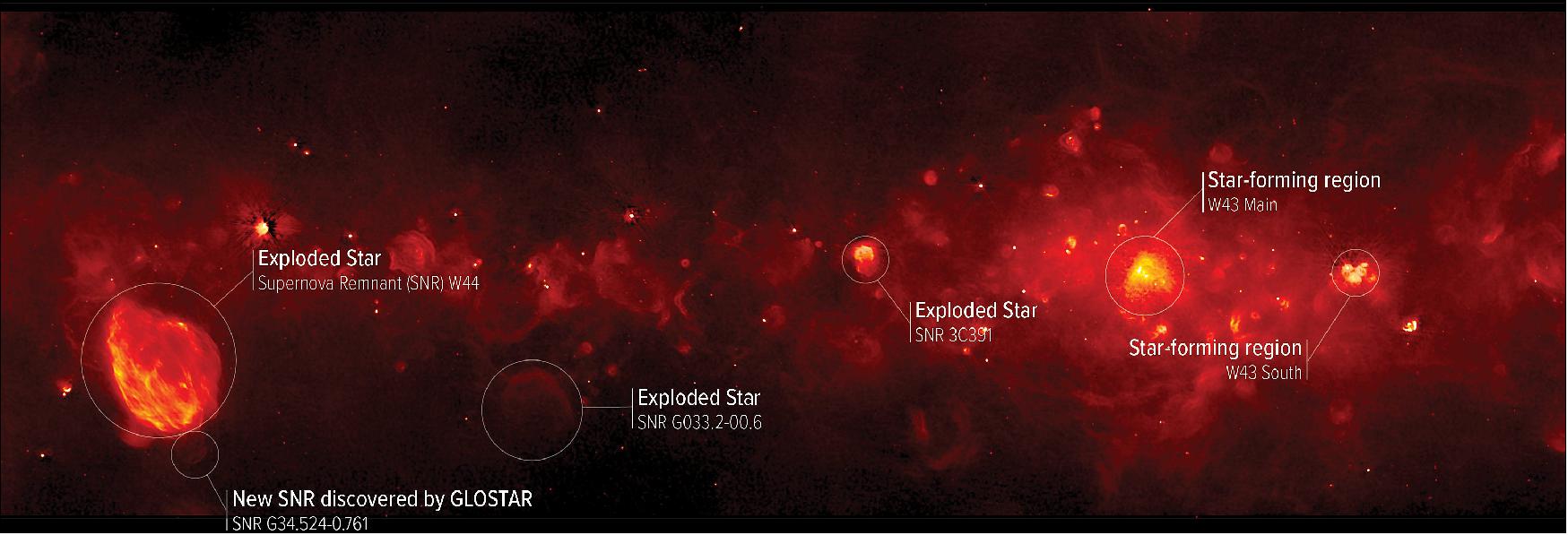
- The results from GLOSTAR, combined with other radio and infrared surveys, “offers astronomers a nearly complete census of massive star-forming clusters at various stages of formation, and this will have lasting value for future studies,” said team member William Cotton, of the National Radio Astronomy Observatory (NRAO), who is an expert in combining interferometer and single-telescope data.
- “GLOSTAR is the first map of the Galactic Plane at radio wavelengths that detects many of the important star formation tracers at high spatial resolution. The detection of atomic and molecular spectral lines is critical to determine the location of star formation and to better understand the structure of the Galaxy,” said Dana Balser, also of NRAO.
- The initiator of GLOSTAR, the MPIfR’s Karl Menten, added, “It’s great to see the beautiful science resulting from two of our favorite radio telescopes joining forces.”
- The National Radio Astronomy Observatory is a facility of the National Science Foundation, operated under cooperative agreement by Associated Universities, Inc.
• June 25, 2021: A giant comet has been discovered by two astronomers following a comprehensive search of data from Dark Energy Survey (DES). The comet, which is estimated to be 100–200 km across, or about 10 times the diameter of most comets, is an icy relic flung out of the Solar System by the migrating giant planets in the early history of the Solar System. This comet is quite unlike any other seen before and the huge size estimate is based on how much sunlight it reflects. 28)
- Pedro Bernardinelli and Gary Bernstein, of the University of Pennsylvania, found the comet — named Comet Bernardinelli-Bernstein (with the designation C/2014 UN271) — hidden among data collected by the 570-megapixel Dark Energy Camera (DECam) mounted on the Víctor M. Blanco 4-meter Telescope at Cerro Tololo Inter-American Observatory (CTIO) in Chile. The analysis of data from the Dark Energy Survey is supported by the Department of Energy (DOE) and the National Science Foundation (NSF), and the DECam science archive is curated by the Community Science and Data Center (CSDC) at NSF’s NOIRLab. CTIO and CSDC are Programs of NOIRLab.
- One of the highest-performance, wide-field CCD imagers in the world, DECam was designed specifically for the DES and operated by the DOE and NSF between 2013 and 2019. DECam was funded by the DOE and was built and tested at DOE's Fermilab. At present DECam is used for programs covering a huge range of science.
- DES was tasked with mapping 300 million galaxies across a 5000-square-degree area of the night sky, but during its six years of observations it also observed many comets and trans-Neptunian objects passing through the surveyed field. A trans-Neptunian object, or TNO, is an icy body that resides in our Solar System beyond the orbit of Neptune.
- Bernardinelli and Bernstein used 15–20 million CPU hours at the National Center for Supercomputing Applications and Fermilab, employing sophisticated identification and tracking algorithms to identify over 800 individual TNOs from among the more than 16 billion individual sources detected in 80,000 exposures taken as part of the DES. Thirty-two of those detections belonged to one object in particular — C/2014 UN271.
- Comets are icy bodies that evaporate as they approach the warmth of the Sun, growing their coma and tails. The DES images of the object in 2014–2018 did not show a typical comet tail, but within a day of the announcement of its discovery via the Minor Planet Center, astronomers using the Las Cumbres Observatory network took fresh images of Comet Bernardinelli-Bernstein which revealed that it has grown a coma in the past 3 years, making it officially a comet.
- Its current inward journey began at a distance of over 40,000 astronomical units (au) from the Sun — in other words 40,000 times farther from the Sun than Earth is, or 6 trillion kilometers away (3.7 trillion miles or 0.6 light-years — 1/7 of the distance to the nearest star). For comparison, Pluto is 39 au from the Sun, on average. This means that Comet Bernardinelli-Bernstein originated in the Oort Cloud of objects, ejected during early history of the Solar System. It could be the largest member of the Oort Cloud ever detected, and it is the first comet on an incoming path to be detected so far away.
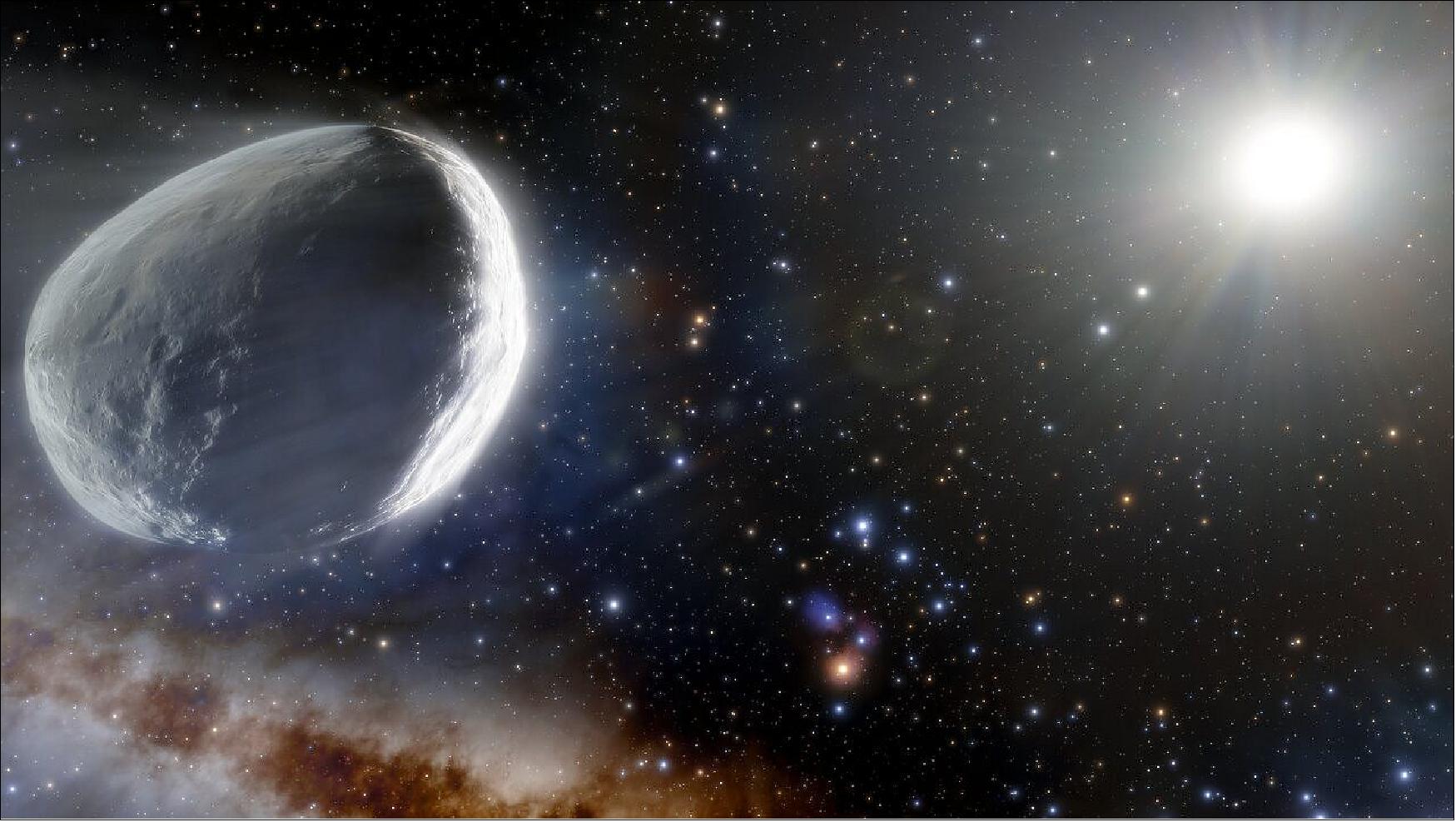
- Comet Bernardinelli-Bernstein is currently much closer to the Sun. It was first seen by DES in 2014 at a distance of 29 au (4 billion kilometers or 2.5 billion miles, roughly the distance of Neptune), and as of June 2021, it was 20 au (3 billion kilometers or 1.8 billion miles, the distance of Uranus) from the Sun and currently shines at magnitude 20. The comet's orbit is perpendicular to the plane of the Solar System and it will reach its closest point to the Sun (known as perihelion) in 2031, when it will be around 11 au away (a bit more than Saturn’s distance from the Sun) — but it will get no closer. Despite the comet’s size, it is currently predicted that skywatchers will require a large amateur telescope to see it, even at its brightest.
- "We have the privilege of having discovered perhaps the largest comet ever seen — or at least larger than any well-studied one — and caught it early enough for people to watch it evolve as it approaches and warms up," said Gary Bernstein. "It has not visited the Solar System in more than 3 million years."
- Comet Bernardinelli-Bernstein will be followed intensively by the astronomical community, including with NOIRLab facilities, to understand the composition and origin of this massive relic from the birth of our own planet. Astronomers suspect that there may be many more undiscovered comets of this size waiting in the Oort Cloud far beyond Pluto and the Kuiper Belt. These giant comets are thought to have been scattered to the far reaches of the Solar System by the migration of Jupiter, Saturn, Uranus and Neptune early in their history.
- “This is a much needed anchor on the unknown population of large objects in the Oort Cloud and their connection with early migration of the ice/gas giants soon after the Solar System was formed,” said NOIRLab astronomer Tod Lauer.
- “These observations demonstrate the value of long-duration survey observations on national facilities like the Blanco telescope,” says Chris Davis, National Science Foundation Program Director for NOIRLab. “Finding huge objects like Comet Bernardinelli-Bernstein is crucial to our understanding of the early history of our Solar System.”
- It is not yet known how active and bright it will become when it reaches perihelion. However, Bernardinelli says that Vera C. Rubin Observatory, a future Program of NOIRLab, “will continuously measure Comet Bernardinelli-Bernstein all the way to its perihelion in 2031, and probably find many, many others like it,” allowing astronomers to characterize objects from the Oort Cloud in much greater detail.
• June 17, 2021: A team of scientists using the Atacama Large Millimeter/submillimeter Array (ALMA) to study the young star Elias 2-27 have confirmed that gravitational instabilities play a key role in planet formation, and have for the first time directly measured the mass of protoplanetary disks using gas velocity data, potentially unlocking one of the mysteries of planet formation. The results of the research are published today in two papers in The Astrophysical Journal. 29)
- Protoplanetary disks—planet-forming disks made of gas and dust that surround newly formed young stars—are known to scientists as the birthplace of planets. The exact process of planet formation, however, has remained a mystery. The new research, led by Teresa Paneque-Carreño—a recent graduate of the Universidad de Chile and PhD student at the University of Leiden and the European Southern Observatory, and the primary author on the first of the two papers—focuses on unlocking the mystery of planet formation.
- During observations, scientists confirmed that the Elias 2-27 star system—a young star located less than 400 light-years away from Earth in the constellation Ophiuchus—was exhibiting evidence of gravitational instabilities which occur when planet-forming disks carry a large fraction of the system’s stellar mass. “How exactly planets form is one of the main questions in our field. However, there are some key mechanisms that we believe can accelerate the process of planet formation,” said Paneque-Carreño. “We found direct evidence for gravitational instabilities in Elias 2-27, which is very exciting because this is the first time that we can show kinematic and multi-wavelength proof of a system being gravitationally unstable. Elias 2-27 is the first system that checks all of the boxes.”
- Elias 2-27’s unique characteristics have made it popular with ALMA scientists for more than half a decade. In 2016, a team of scientists using ALMA discovered a pinwheel of dust swirling around the young star. The spirals were believed to be the result of density waves, commonly known to produce the recognizable arms of spiral galaxies—like the Milky Way Galaxy—but at the time, had never before been seen around individual stars.
- “We discovered in 2016 that the Elias 2-27 disk had a different structure from other already studied systems, something not observed in a protoplanetary disk before: two large-scale spiral arms. Gravitational instabilities were a strong possibility, but the origin of these structures remained a mystery and we needed further observations,” said Laura Pérez, Assistant Professor at the Universidad de Chile and the principal investigator on the 2016 study. Together with collaborators, she proposed further observations in multiple ALMA bands that were analyzed with Paneque-Carreño as a part of her M.Sc. thesis at Universidad de Chile.
- In addition to confirming gravitational instabilities, scientists found perturbations—or disturbances—in the star system above and beyond theoretical expectations. “There may still be new material from the surrounding molecular cloud falling onto the disk, which makes everything more chaotic,” said Paneque-Carreño, adding that this chaos has contributed to interesting phenomena that have never been observed before, and for which scientists have no clear explanation. “The Elias 2-27 star system is highly asymmetric in the gas structure. This was completely unexpected, and it is the first time we’ve observed such vertical asymmetry in a protoplanetary disk.”
![Figure 20: New observations of young stellar object Elias 2-27 confirm gravitational instabilities and planet-forming disk mass as key to formation of giant planets. Using gas velocity data, scientists observing Elias 2-27 were able to directly measure the mass of the young star’s protoplanetary disk and also trace dynamical perturbations in the star system. Visible in this paneled composite are the dust continuum 0.87mm emission data (blue), along with emissions from gases C18O (yellow) and 13CO (red). [image credit: ALMA (ESO/NAOJ/NRAO)/T. Paneque-Carreño (Universidad de Chile), B. Saxton (NRAO)]](https://www.eoportal.org/ftp/satellite-missions/n/NRAO_270622/NRAO_Auto30.jpeg)
- Cassandra Hall, Assistant Professor of Computational Astrophysics at the University of Georgia, and a co-author on the research, added that the confirmation of both vertical asymmetry and velocity perturbations—the first large-scale perturbations linked to spiral structure in a protoplanetary disk—could have significant implications for planet formation theory. “This could be a ‘smoking gun’ of gravitational instability, which may accelerate some of the earliest stages of planet formation. We first predicted this signature in 2020, and from a computational astrophysics point of view, it’s exciting to be right.”
- Paneque-Carreño added that while the new research has confirmed some theories, it has also raised new questions. “While gravitational instabilities can now be confirmed to explain the spiral structures in the dust continuum surrounding the star, there is also an inner gap, or missing material in the disk, for which we do not have a clear explanation.”
- One of the barriers to understanding planet formation was the lack of direct measurement of the mass of planet-forming disks, a problem addressed in the new research. The high sensitivity of ALMA Band 6, paired with Bands 3 and 7, allowed the team to more closely study the dynamical processes, density, and even the mass of the disk. “Previous measurements of protoplanetary disk mass were indirect and based only on dust or rare isotopologues. With this new study, we are now sensitive to the entire mass of the disk,” said Benedetta Veronesi—a graduate student at the University of Milan and postdoctoral researcher at École normale supérieure de Lyon, and the lead author on the second paper. “This finding lays the foundation for the development of a method to measure disk mass that will allow us to break down one of the biggest and most pressing barriers in the field of planet formation. Knowing the amount of mass present in planet-forming disks allows us to determine the amount of material available for the formation of planetary systems, and to better understand the process by which they form.”
- Although the team has answered a number of key questions about the role of gravitational instability and disk mass in planet formation, the work is not yet done. “Studying how planets form is difficult because it takes millions of years to form planets. This is a very short time-scale for stars, which live thousands of millions of years, but a very long process for us,” said Paneque-Carreño. “What we can do is observe young stars, with disks of gas and dust around them, and try to explain why these disks of material look the way they do. It’s like looking at a crime scene and trying to guess what happened. Our observational analysis paired with future in-depth analysis of Elias 2-27 will allow us to characterize exactly how gravitational instabilities act in planet-forming disks, and gain more insight into how planets are formed.” 30)
![Figure 21: Elias 2-27 is a young star located just 378 light-years from Earth. The star is host to a massive protoplanetary disk of gas and dust, one of the key elements to planet formation. In this graphic illustration, dust is distributed along a spiral-shaped morphology first discovered in Elias 2-27 in 2016. The larger dust grains are found along the spiral arms while the smaller dust grains are distributed all around the protoplanetary disk. Asymmetric inflows of gas were also detected during the study, indicating that there may still be material infalling into the disk. Scientists believe that Elias 2-27 may eventually evolve into a planetary system, with gravitational instabilities causing the formation of giant planets. Because this process takes millions of years to occur, scientists can only observe the beginning stages [image credit: ALMA (ESO/NAOJ/NRAO)/T. Paneque-Carreño (Universidad de Chile), B. Saxton (NRAO)]](https://www.eoportal.org/ftp/satellite-missions/n/NRAO_270622/NRAO_Auto2F.jpeg)
• June 1, 2021: The NRAO has selected a contractor to develop a production-ready design and produce a prototype antenna for the Next Generation Very Large Array (ngVLA). NRAO officials signed an agreement with mtex antenna technology GmbH of Germany on May 27. 31)
- The ngVLA, a powerful radio telescope with a total of 263 dish antennas distributed across North America, is proposed as one of the next generation of cutting-edge astronomical observatories.
- “Our observatory’s mission is to provide the tools needed to answer the challenging scientific questions facing astronomers, and the ngVLA is a key to meeting that need in the coming decades. Finalizing the design and building the first antenna is a big step toward that goal,” said NRAO Director Tony Beasley.
- Under the contract, mtex will prepare a production-ready antenna design based on NRAO specifications and an earlier reference design presented in 2019 to the U.S. Decadal Survey on Astronomy and Astrophysics 2020 (Astro2020). The design will be for the 244 ngVLA dish antennas that will be 18 meters (59 feet) in diameter. An additional 19, 6-meter (20-foot) dishes, not part of this contract, are planned for the center of the system.
- The work under the new contract is planned in four phases. A baseline phase starts immediately to work on the preliminary design. Later options include completing the preliminary design and building a prototype antenna that will be installed at the site of the National Science Foundation’s (NSF) Karl G. Jansky Very Large Array (VLA) in west-central New Mexico, where it will undergo extensive testing. A final phase will refine the design to optimize manufacture of the additional antennas. A separate contract will be awarded for the mass production.
- The ngVLA project currently is under review by Astro2020, a committee of the U.S. National Academy of Sciences. Their report is expected soon. Following that report, the project will need approval by the NSF’s National Science Board and funding by Congress. Full construction could begin by 2025 with early scientific observations starting in 2028 and full scientific operations by 2035.
- “Part of our presentation to Astro2020 included estimates of the cost of ngVLA antennas. We now have a contract with professional estimates of those costs that are at or below those we presented to Astro2020. This is clear confirmation that we understand the costs and that the risk is low for this major portion of the ngVLA,” said Adam Cohen, President of Associated Universities, Inc.
- “Many of us at NRAO have been working hard on plans for the ngVLA, and we look forward to working with mtex to make this important part of the future of radio astronomy a reality,” said Mark McKinnon, ngVLA Project Director.
- “The ngVLA will be a cutting edge observatory of the next decade. Our team in Germany and the USA has worked on the pre-study intensively together with the experts from NRAO on a telescope design that fulfills all demanding requirements and also is as cost efficient as possible for up to 244, 18-meter ngVLA dish antennas. We are very honored that NRAO has selected our design and we are excited that we can continue our work to support them on the realization of the ngVLA observatory,” said Lutz Stenvers, CEO and Managing Shareholder of mtex antenna technology.
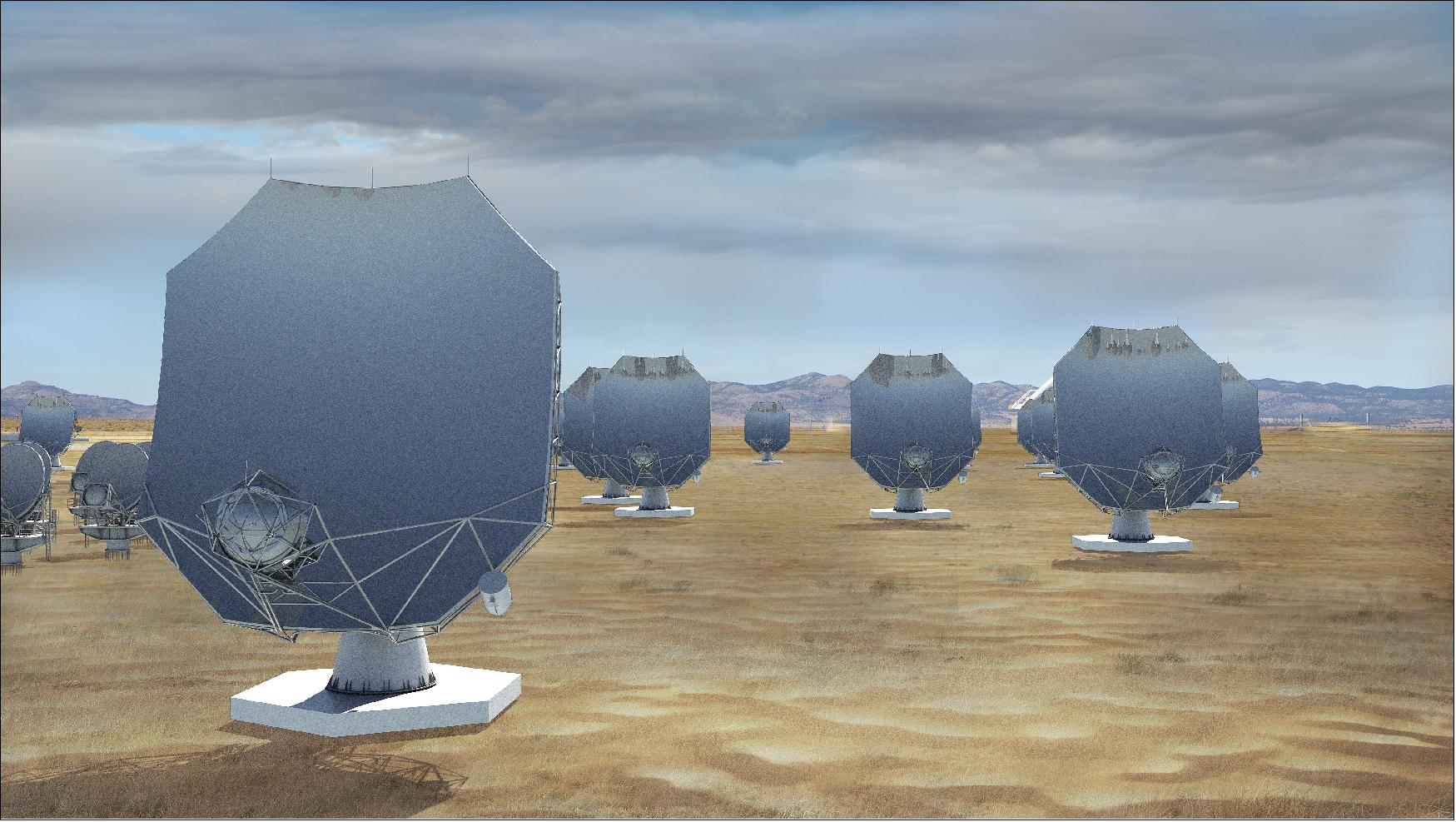
- The ngVLA will have a dense core of antennas and a signal processing center at the current site of the VLA on the Plains of San Agustin in New Mexico. The system will include other antennas located throughout New Mexico and in west Texas, eastern Arizona, and northern Mexico. More far-flung antennas will be located in clusters in Hawaii, Washington, California, Iowa, West Virginia, New Hampshire, Puerto Rico (at Arecibo Observatory), the U.S. Virgin Islands, and Canada. Operations will be conducted at the VLA site and in nearby Socorro, New Mexico, with additional science operations in a metropolitan area to be determined.
- The National Radio Astronomy Observatory is a facility of the National Science Foundation, operated under cooperative agreement by Associated Universities, Inc.
- mtex antenna technology gmbh, located in Wiesbaden, Germany, develops and manufactures telescopes for astronomy and geodesy, as well as special antennas for demanding applications. It also supplies antenna systems and ground stations for satellites or communication with spacecraft for business, research, ministries and government agencies. In addition to these product areas, this includes comprehensive services such as engineering services, installation, maintenance, upgrades, and after-sales services.
• May 04, 2021: This overlay shows radio (orange) and infrared images of a giant molecular cloud called W49A, where new stars are being formed. A team of astronomers led by Chris DePree of Agnes Scott College used the National Science Foundation’s Karl G. Jansky Very Large Array (VLA) to make new, high-resolution radio images of this cluster of still-forming, massive stars. W49A, 36,000 light-years from Earth, has been studied for many decades, and the new radio images revealed some tantalizing changes that have occurred since an earlier set of VLA observations in 1994 and 1995. 32)
- The VLA radio images show the shape and movement of giant clouds of ionized hydrogen gas formed by the intense ultraviolet radiation from young stars. Comparing old and new VLA images of these ionized regions has shown changes indicating new activity in some of the regions. This new activity includes a narrow, fast-moving jet in one region, supersonic gas motions in three others, and an unexpected reduction in the radio brightness in another.
- The astronomers, who reported their findings in the Astronomical Journal, plan to continue observing this region regularly to track changes that will reveal new details about the complex processes of star formation and interactions of the outflows from young stars. 33)
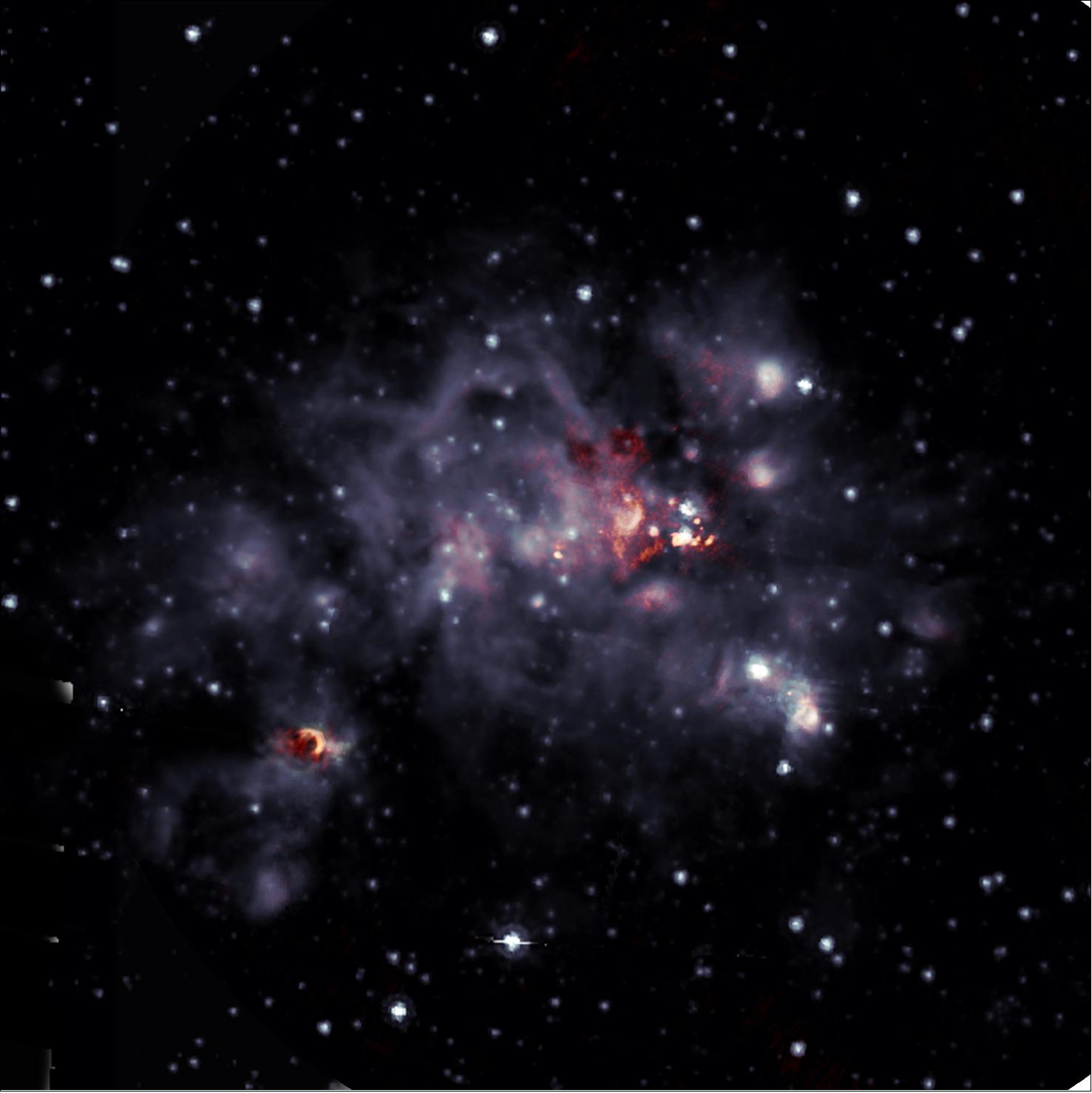
• April 21, 2021: Astronomers using the Atacama Large Millimeter/submillimeter Array (ALMA) have spotted a flare from Earth’s nearest neighboring star, Proxima Centauri, that is 100 times more powerful than any similar flare seen from the Sun. The flare, which is the largest ever recorded from the star, has revealed the inner workings of such events to astronomers, and could help to shape the hunt for life beyond the Solar System. 34)
- Stellar flares occur when the release of magnetic energy in stellar spots explodes in an intense burst of electromagnetic radiation that can be observed across the entire electromagnetic spectrum, from radio waves to gamma rays. This is the first time that a single stellar flare, other than those that occur on the Sun, has been observed with such complete wavelength coverage. The study was precipitated by the serendipitous discovery of a flare from Proxima Centauri in 2018 ALMA archival data.
- “We had never seen an M dwarf flare at millimeter wavelengths before 2018, so it was not known whether there was corresponding emission at other wavelengths,” said Meredith MacGregor, an assistant professor at the Center for Astrophysics and Space Astronomy (CASA) and Department of Astrophysical and Planetary Sciences (APS) at CU Boulder, and the lead author on the study.
- To better understand the flares on Proxima Centauri— a red dwarf star located roughly four light-years or 20 trillion miles from Earth— a team of astronomers observed the star for 40 hours over the course of several months in 2019 using nine telescopes on the ground and in space.
- In May 2019, Proxima Centauri ejected a violent flare that lasted just seven seconds, but generated a surge in both ultraviolet and millimeter wavelengths. The flare was characterized by a strong, impulsive spike never before seen at these wavelengths. The event was recorded by five of the nine telescopes involved in the study, including the Hubble Space Telescope (HST) in ultraviolet, and ALMA in millimeter wavelengths.
- “The star went from normal to 14,000 times brighter when seen in ultraviolet wavelengths over the span of a few seconds,” said MacGregor, adding that similar behavior was captured in millimeter wavelengths by ALMA at the same time.
- “In the past, we didn’t know that stars could flare in the millimeter range, so this is the first time we have gone looking for millimeter flares,” said MacGregor, adding that the new observations could help researchers gather more information about how stars generate flares, which can have an impact on nearby life.
- Powerful flares from our Sun are uncommon, occurring only a few times in a solar cycle. According to MacGregor, that’s not the case on Proxima Centauri. “Proxima Centauri’s planets are getting hit by something like this not once in a century, but at least once a day, if not several times a day,” said MacGregor.
- The star is prominent in discussions surrounding the prospect for life around red dwarf stars because of its proximity to Earth, and because it is host to Proxima Centauri b, a planet that resides in the star’s habitable zone.
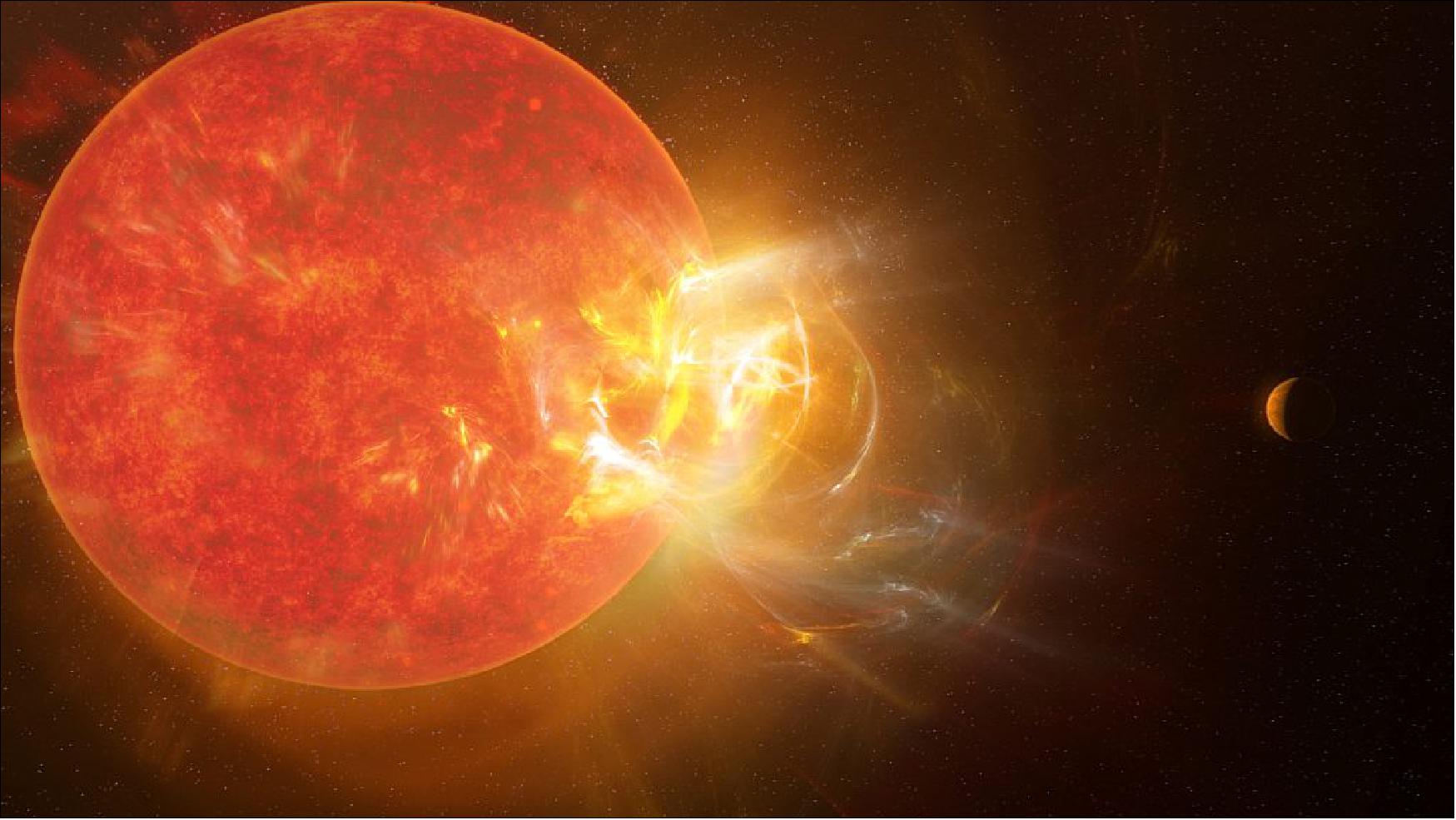
- “If there was life on the planet nearest to Proxima Centauri, it would have to look very different than anything on Earth,” MacGregor said. “A human being on this planet would have a bad time.”
- Future observations will focus on unveiling the many secrets behind Proxima Centauri’s flares in the hopes of uncovering the internal mechanisms that cause such powerful outbursts.
- “We want to see what surprises this star has in store for us to help us understand the physics of stellar flaring,” said MacGregor.
- The results of the study are reported today in The Astrophysical Journal Letters. 35)
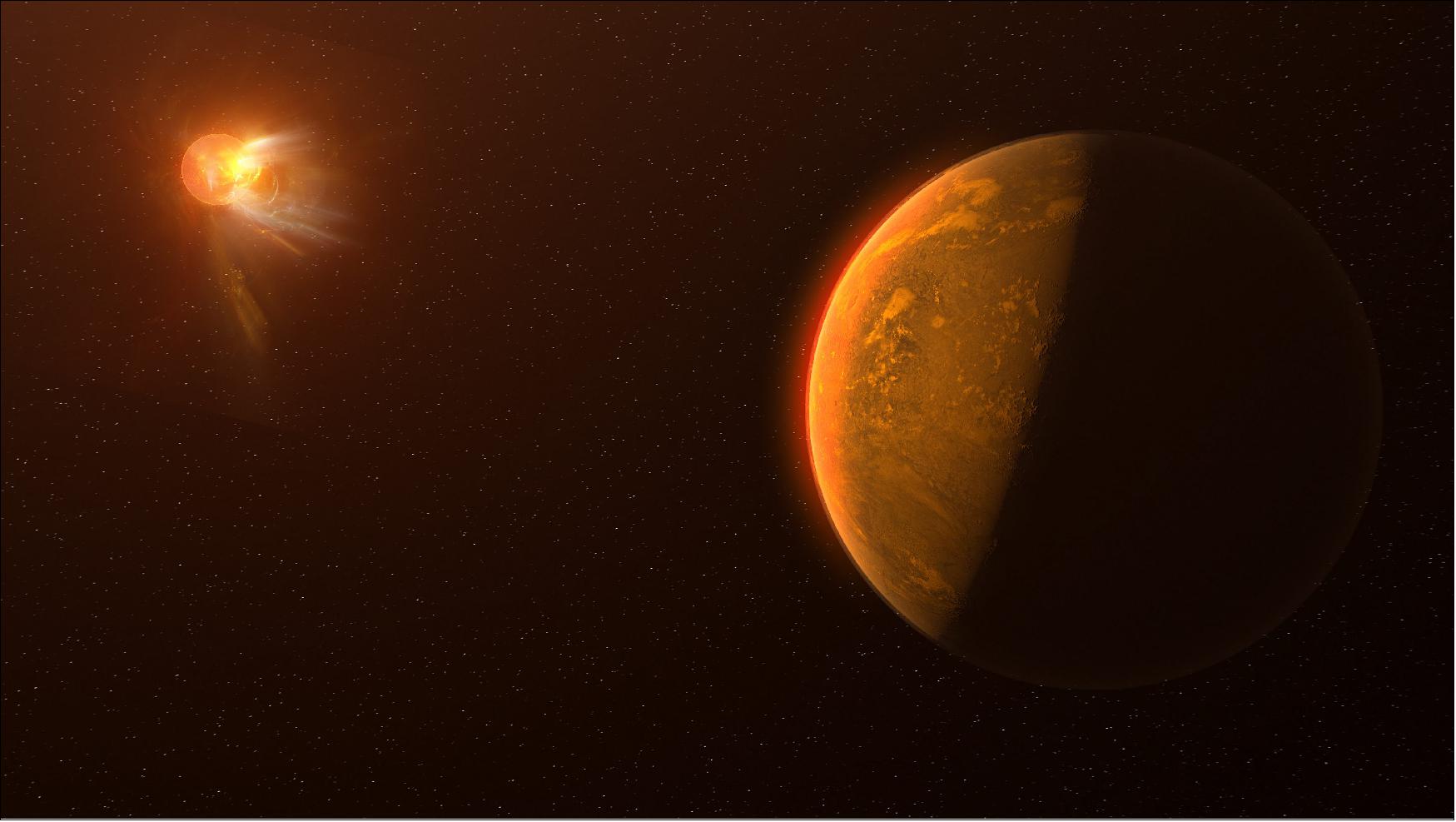
• March 18, 2021: Scientists at the CfA (Center for Astrophysics) | Harvard& Smithsonian have discovered a vast, previously unknown reservoir of new aromatic material in a cold, dark molecular cloud by detecting individual polycyclic aromatic hydrocarbon molecules in the interstellar medium for the first time, and in doing so are beginning to answer a three-decades-old scientific mystery: how and where are these molecules formed in space? 36)
- "We had always thought polycyclic aromatic hydrocarbons were primarily formed in the atmospheres of dying stars," said Brett McGuire, Assistant Professor of Chemistry at the Massachusetts Institute of Technology, and the Project Principal Investigator for GOTHAM, or Green Bank Telescope (GBT) Observations of TMC-1: Hunting Aromatic Molecules. "In this study, we found them in cold, dark clouds where stars haven’t even started forming yet."
- Aromatic molecules, and PAHs (Polycyclic Aromatic Hydrocarbons) — are well known to scientists. Aromatic molecules exist in the chemical makeup of human beings and other animals, and are found in food and medicines. As well, PAHs are pollutants formed from the burning of many fossil fuels and are even amongst the carcinogens formed when vegetables and meat are charred at high temperatures. "Polycyclic aromatic hydrocarbons are thought to contain as much as 25-percent of the carbon in the universe," said McGuire, who is also a research associate at the Center for Astrophysics | Harvard & Smithsonian (CfA). "Now, for the first time, we have a direct window into their chemistry that will let us study in detail how this massive reservoir of carbon reacts and evolves through the process of forming stars and planets."
- Scientists have suspected the presence of PAHs in space since the 1980s but the new research, detailed in nine papers published over the past seven months, provides the first definitive proof of their existence in molecular clouds. To search out the elusive molecules, the team focused the 100m behemoth radio astronomy GBT on the TMC-1 (Taurus Molecular Cloud) — a large, pre-stellar cloud of dust and gas located roughly 450 light-years from Earth that will someday collapse in on itself to form stars—and what they found was astonishing: not only were the accepted scientific models incorrect, but there was a lot more going on in TMC-1 than the team could have imagined.
- "From decades of previous modeling, we believed that we had a fairly good understanding of the chemistry of molecular clouds," said Michael McCarthy, an astrochemist and Acting Deputy Director of CfA, whose research group made the precise laboratory measurements that enabled many of these astronomical detections to be established with confidence. "What these new astronomical observations show is these molecules are not only present in molecular clouds, but at quantities which are orders of magnitude higher than standard models predict."
- McGuire added that previous studies revealed only that there were PAH molecules out there, but not which specific ones. "For the last 30 years or so, scientists have been observing the bulk signature of these molecules in our galaxy and other galaxies in the infrared, but we couldn't see which individual molecules made up that mass. With the addition of radio astronomy, instead of seeing this large mass that we can't distinguish, we’re seeing individual molecules."
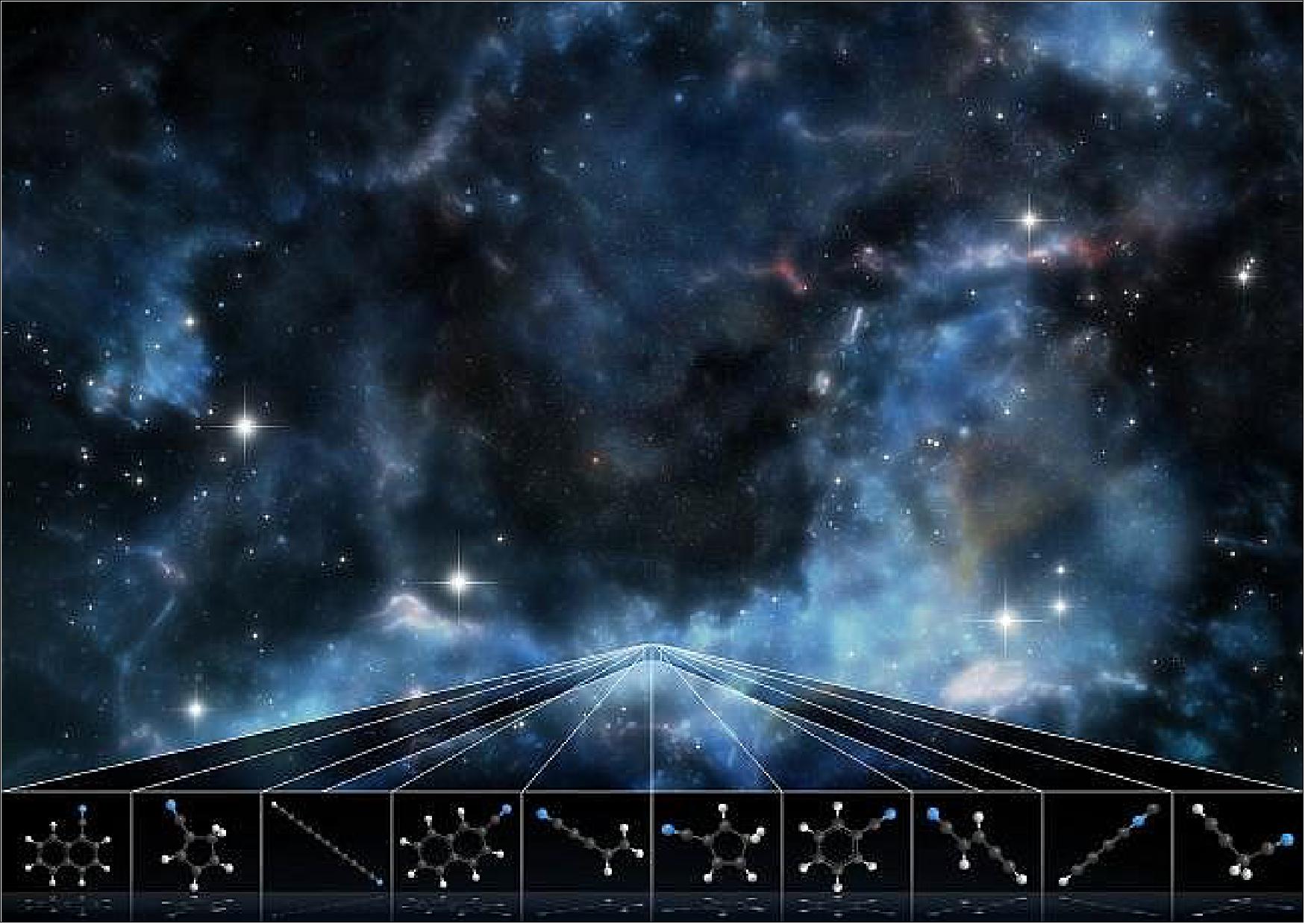
- Much to their surprise, the team didn’t discover just one new molecule hiding out in TMC-1. Detailed in multiple papers, the team observed 1-cyanonaphthalene, 1-cyano-cyclopentadiene, HC11N, 2-cyanonaphthalene, vinylcyanoacetylene, 2-cyano-cyclopentadiene, benzonitrile, trans-(E)-cyanovinylacetylene, HC4NC, and propargylcyanide, among others. "It's like going into a boutique shop and just browsing the inventory on the front-end without ever knowing there was a back room. We've been collecting little molecules for 50 years or so and now we have discovered there's a back door. When we opened that door and looked in, we found this giant warehouse of molecules and chemistry that we did not expect," said McGuire. "There it was, all the time, lurking just beyond where we had looked before."
- McGuire and other scientists at the GOTHAM project have been "hunting" for molecules in TMC-1 for more than two years, following McGuire's initial detection of benzonitrile in 2018. The results of the project's latest observations may have ramifications in astrophysics for years to come. "We've stumbled onto a whole new set of molecules unlike anything we've previously been able to detect, and that is going to completely change our understanding of how these molecules interact with each other. It has downstream ramifications," said McGuire, adding that eventually these molecules grow large enough that they begin to aggregate into the seeds of interstellar dust. "When these molecules get big enough that they're the seeds of interstellar dust, these have the possibility then to affect the composition of asteroids, comets, and planets, the surfaces on which ices form, and perhaps in turn even the locations where planets form within star systems."
- The discovery of new molecules in TMC-1 also has implications for astrochemistry, and while the team doesn’t yet have all of the answers, the ramifications here, too, will last for decades. "We've gone from one-dimensional carbon chemistry, which is very easy to detect, to real organic chemistry in space in the sense that the newly discovered molecules are ones that a chemist knows and recognizes, and can produce on Earth," said McCarthy. "And this is just the tip of the iceberg. Whether these organic molecules were synthesized there or transported there, they exist, and that knowledge alone is a fundamental advance in the field."
- Before the launch of GOTHAM in 2018, scientists had cataloged roughly 200 individual molecules in the Milky Way's interstellar medium. These new discoveries have prompted the team to wonder, and rightly so, what's out there. "The amazing thing about these observations, about this discovery, and about these molecules, is that no one had looked, or looked hard enough," said McCarthy. "It makes you wonder what else is out there that we just haven’t looked for."
- This new aromatic chemistry that scientists are finding isn't isolated to TMC-1. A companion survey to GOTHAM, known as ARKHAM—A Rigorous K/Ka-Band Survey Hunting for Aromatic Molecules—recently found benzonitrile in multiple additional objects. "Incredibly, we found benzonitrile in every single one of the first four objects observed by ARKHAM," said Andrew Burkhardt, a Submillimeter Array Postdoctoral Fellow at the CfA and a co-principal investigator for GOTHAM. "This is important because while GOTHAM is pushing the limit of what chemistry we thought is possible in space, these discoveries imply that the things we learn in TMC-1 about aromatic molecules could be applied broadly to dark clouds anywhere. These dark clouds are the initial birthplaces of stars and planets. So, these previously invisible aromatic molecules will also need to be thought about at each later step along the way to the creation of stars, planets, and solar systems like our own."
- In addition to McGuire, McCarthy, and Burkhardt, the following researchers contributed to and led research for this project: Kin Long Kelvin Lee of MIT; Ryan Loomis, Anthony Remijan, and Emmanuel Momjian of the National Radio Astronomy Observatory; Christopher N. Shingledecker of Benedictine College; Steven B. Charnley and Martin A. Cordiner of NASA Goddard; Eric Herbst, Eric R. Willis, Ci Xue, and Mark Siebert of the University of Virginia; and, Sergei Kalenskii of the Lebedev Physical Institute. The project also received research support from the University of Stuttgart, Max Planck Institute, and The Catholic University of America. 37) 38) 39)
• March 16, 2021: Radio telescopes are the world’s most sensitive radio receivers, capable of finding extremely faint wisps of radio emission coming from objects at the farthest reaches of the universe. Recently, a team of astronomers used the National Science Foundation’s Karl G. Jansky Very Large Array (VLA) to take advantage of a helping hand from nature to detect a distant galaxy that likely is the faintest radio-emitting object yet found. 40)
- The discovery was part of the VLA Frontier Fields Legacy Survey, led by NRAO Astronomer Eric Murphy, which used distant clusters of galaxies as natural lenses to study objects even farther away. The clusters served as gravitational lenses, using the gravitational pull of the galaxies in the clusters to bend and magnify light and radio waves coming from the more-distant objects.
- In this composite, a VLA radio image is superimposed on a visible-light image from the Hubble Space Telescope. The prominent red-orange objects are radio relics — large structures possibly caused by shock waves — inside the foreground galaxy cluster, called MACSJ0717.5+3745, which is more than 5 billion light-years from Earth.
- Detailed VLA observations showed that many of the galaxies in this image are emitting radio waves in addition to visible light. The VLA data revealed that one of these galaxies, shown in the pullout, is more than 8 billion light-years distant. Its light and radio waves have been bent by the intervening cluster’s gravitational-lensing effect.
- The radio image of this distant galaxy, called VLAHFF-J071736.66+374506.4, has been magnified more than 6 times by the gravitational lens, the astronomers said. That magnification is what allowed the VLA to detect it.
- “This probably is the faintest radio-emitting object ever detected,” said Ian Heywood, of Oxford University in the UK. “This is exactly why we want to use these galaxy clusters as powerful cosmic lenses to learn more about the objects behind them.”
- “The magnification provided by the gravitational lens, combined with extremely sensitive VLA imaging, gave us an unprecedented look at the structure of a galaxy 300 times less massive than our Milky Way at a time when the universe was less than half its current age. This is giving us valuable insights on star formation in such low-mass galaxies at that time and how they eventually assembled into more massive galaxies,” said Eric Jimenez-Andrade, of NRAO.
- The scientists are reporting their work in a pair of papers in the Astrophysical Journal. 41) 42)
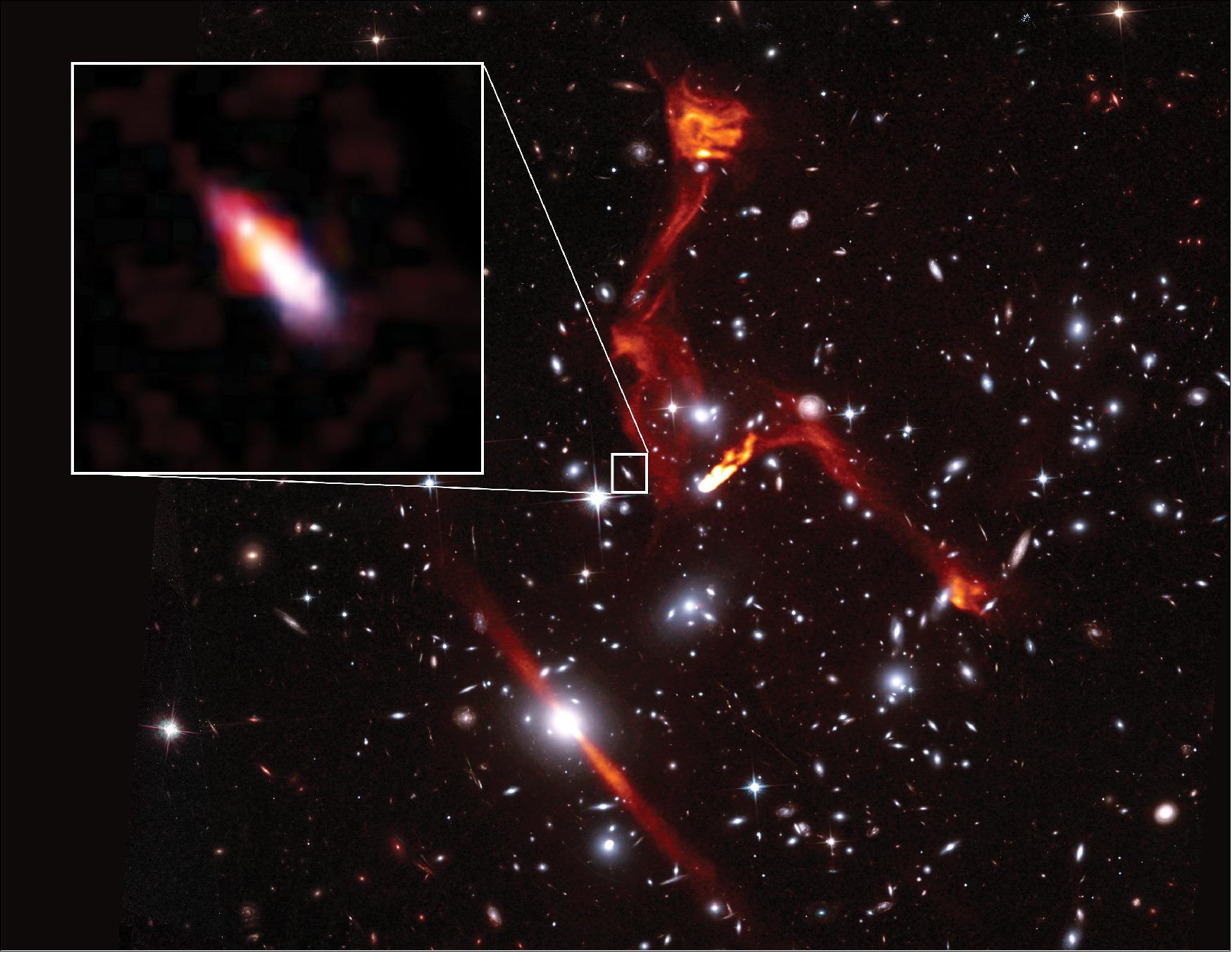
• February 22, 2021: Black holes that are millions or billions of times more massive than the Sun lurk at the cores of large galaxies and can have profound effects on their surroundings. One of the more exciting of those effects comes when a star ventures too close to the black hole and falls victim to that monster’s powerful gravitational pull. The star is shredded by tidal forces in a process colorfully termed spaghettification. 43)
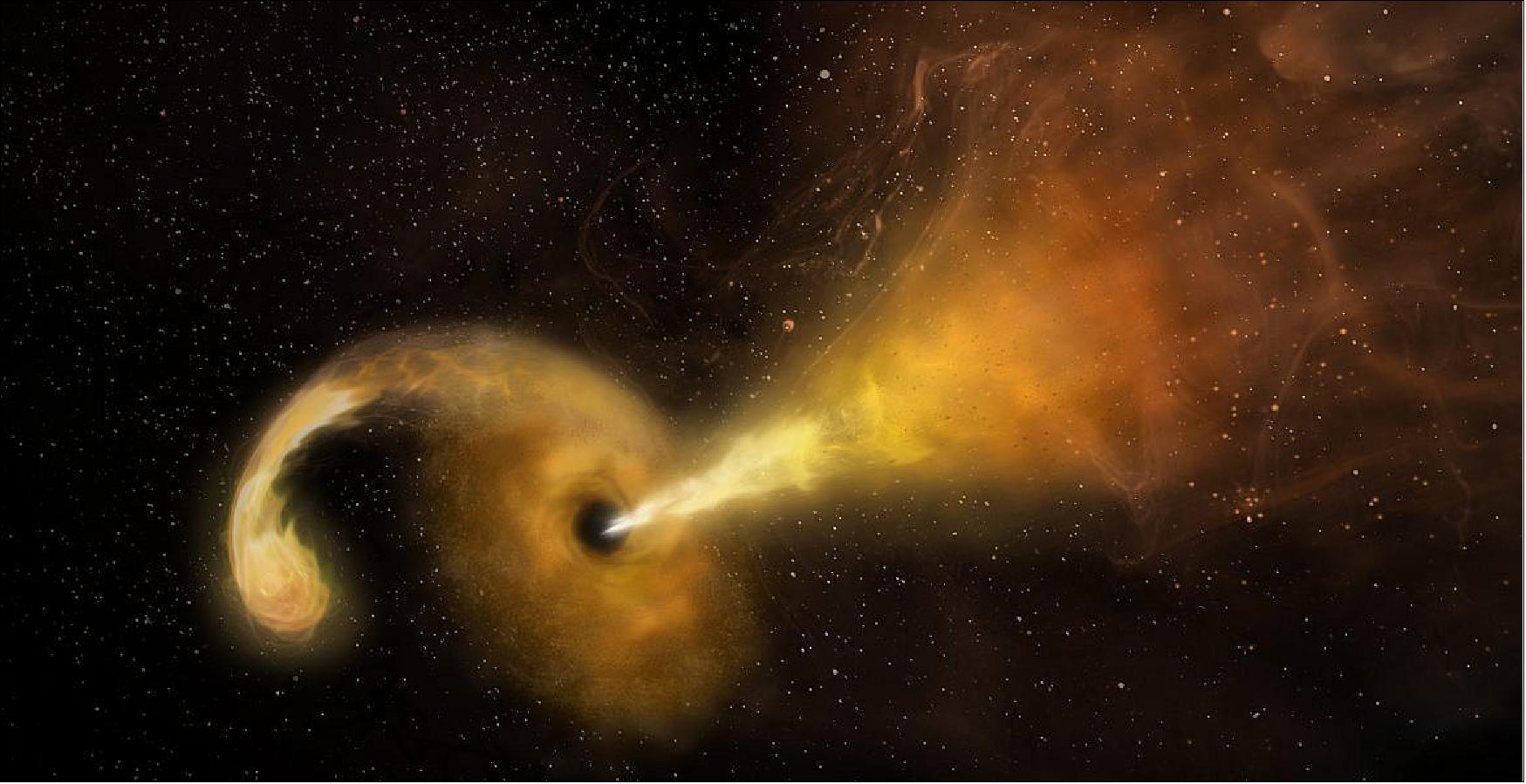
- When that happens, some of the star’s material is pulled into a disk that orbits the black hole, heating rapidly and launching jets of fast-moving particles outward in two opposite directions. This produces an outburst that can be observed with a variety of telescopes, including radio, visible, ultraviolet, and X-ray instruments.
- Over the past couple of decades, astronomers have seen a number of outbursts that they have concluded are either the star-shredding Tidal Disruption Events (TDEs) or candidates for such events. In 2018, astronomers used the National Science Foundation’s Very Long Baseline Array (VLBA) to directly image the formation and expansion of a jet coming from a TDE.
- The 22 February edition of Nature Astronomy includes reports on observations of two different TDEs, each of which adds to our knowledge of these phenomena but also raises new questions for scientists to tackle. 44) 45) The NSF’s Karl G. Jansky Very Large Array (VLA) was used to study both of these events, occurring in 2015 and 2019, respectively.
- One of these star-shredding events is the first known to produce a high-energy neutrino — an elusive subatomic particle moving at nearly the speed of light. The other is the first seen to emit flares of radio waves long after the initial event. Both discoveries are forcing astronomers to rethink their explanations for some of the processes involved in TDEs.
- The neutrino-producing TDE, called AT2019dsg, was discovered on 9 April 2019 by the Zwicky Transient Facility (ZTF), a robotic optical telescope at the Palomar Observatory in California. Astronomers subsequently observed it with the VLA, NASA’s Neil Geherels Swift Observatory, and the European Space Agency’s XMM-Newton. They found that it occurred in a galaxy called 2MASX J20570298+1412165, more than 690 million light-years from Earth in the constellation Delphinus.
- On 1 October, 2019, the NSF’s IceCube Neutrino Observatory in Antarctica detected a high-energy neutrino that came from the same region of sky as the April TDE. Neutrinos are pervasive throughout the universe but are extremely difficult to detect because they very rarely interact with other matter. In fact, this is only the second high-energy neutrino to be linked to an object outside our Milky Way galaxy. The detection was surprising because astronomers had expected that if TDEs produced such neutrinos it would happen relatively soon after the start of the event.
- “Astrophysicists have long theorized that tidal disruptions could produce high-energy neutrinos, but this is the first time we’ve actually been able to connect them with observational evidence,” said Robert Stein, a doctoral student at the German Electron-Synchrotron (DESY) research center in Zeuthen, Germany, and Humboldt University in Berlin. “But it seems like this particular event, called AT2019dsg, didn’t generate the neutrino when or how we expected. It’s helping us better understand how these phenomena work.”
- The other TDE, called ASASSN-15oi, was discovered at visible-light wavelengths by the All-Sky Automated Survey for SuperNovae (ASASSN) on 14 August 2015, in a galaxy more than 700 million light-years from Earth. Astronomers began observing it with the VLA eight days after its discovery, expecting to detect radio emission in the early stages of the event. Instead, they saw no radio emission from the object until six months later, in February of 2016.
- In addition, they later learned that the ongoing VLA Sky Survey observed the region in July of 2019 and found evidence of another radio flare then, nearly four years after the initial event. The astronomers called the two delayed flares “a new puzzling phenomenon in TDEs.”
- “Flares with such delays have not been observed before. Moreover, the delayed flares exhibit peculiar properties currently not supported by theories of TDE radio emission,” said Assaf Horesh, of the Hebrew University of Jerusalem.
- In both cases, the researchers look forward to studying future TDEs for clues that can help resolve the new mysteries their work has unveiled. These dramatic events are an excellent example of how we can advance our understanding of the universe through multimessenger astronomy — studies that use electromagnetic radiation (visible light, radio waves, ultraviolet, etc.), particles such as neutrinos, and even gravitational waves — ripples in spacetime — to learn how cosmic objects work.
• February 3, 2021: The Canadian Astronomy Long Range Plan 2020-2030, a report on priorities and recommendations for Canadian astronomy over the next decade, has recommended that Canada support the National Radio Astronomy Observatory’s (NRAO) proposed Next Generation Very Large Array (ngVLA), saying the new facility will enable transformational science across many areas of astrophysics. 46)
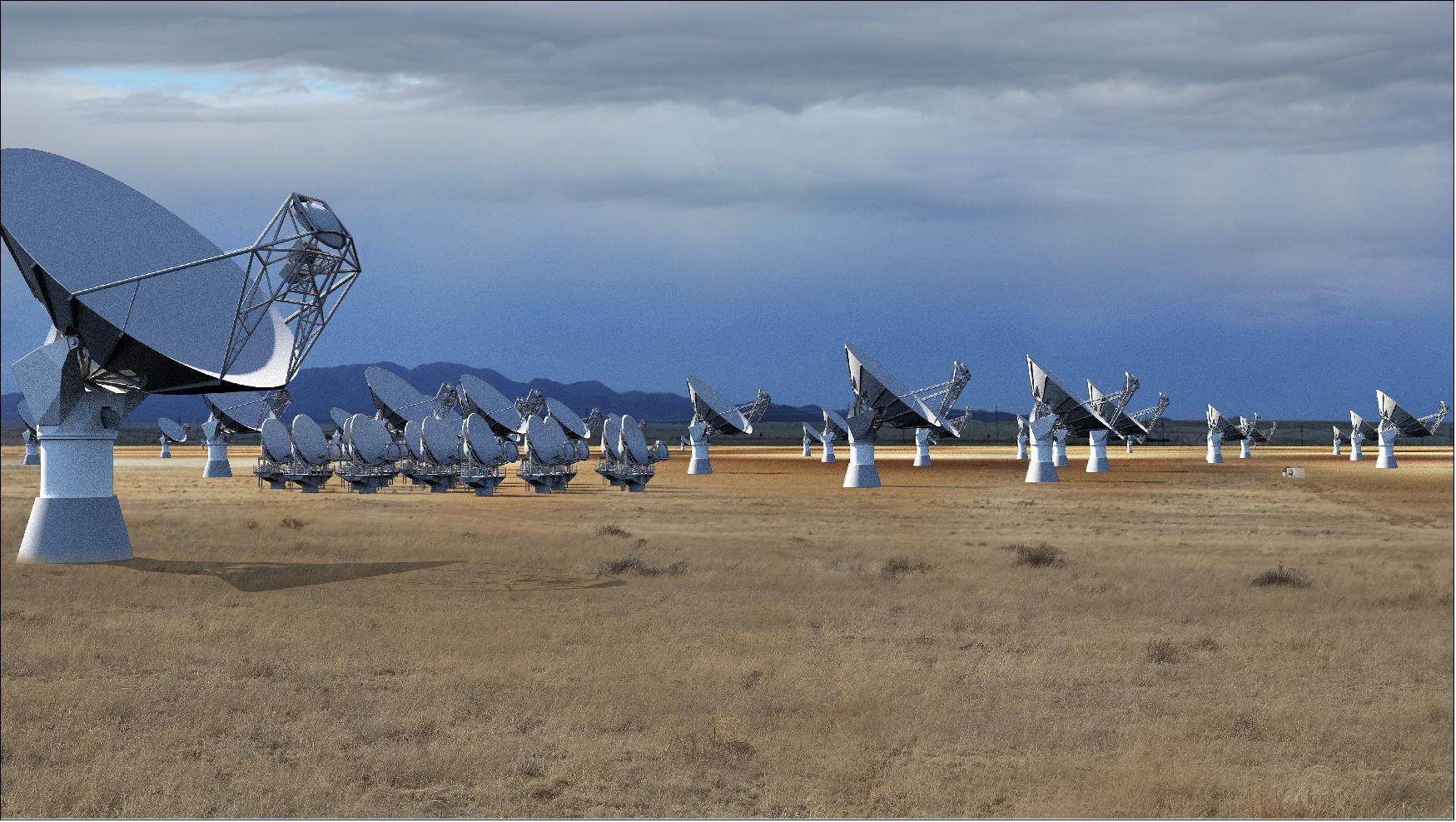
- The ngVLA will be an array of 263 dish antennas reaching across North America. Both its sensitivity to faint objects and its resolving power — ability to see fine detail — will be 10 times greater than the current VLA. Building on the scientific and technical legacies of the VLA and the Atacama Large Millimeter/submillimeter Array (ALMA), the ngVLA is being designed to provide the next major leap forward in our understanding of planets, galaxies, black holes, and the dynamic sky. The ngVLA’s capabilities will complement those of ALMA and the SKA (Square Kilometer Array).
- ”This welcome and important recommendation promises to continue a longstanding tradition of productive collaboration with our Canadian colleagues,” said NRAO Director Tony Beasley. “Canada’s contributions to the VLA over the years have been quite valuable, and we look forward to an exciting partnership in the coming decades,” Beasley added.
- The panel recommended that Canada provide $130 million toward ngVLA construction and $6 million per year for operating the facility.
- “Like many of my colleagues across the Canadian university community, I am excited to see the recommendation for engagement in the ngVLA. This opportunity builds upon our long partnership with NRAO in radio astronomy. My students and I rely on the diverse capabilities of the Canadian-built correlator system for the current VLA to study the evolution of galaxies. Our scientists and engineers have a lot of new ideas to contribute to the design, construction, and use of the ngVLA, and I look forward to conducting science enabled by their ingenuity,” said Erik Rosolowsky of the University of Alberta.
- The ngVLA project currently is under review by the Astronomy and Astrophysics Decadal Survey (Astro2020) of the U.S. National Academy of Sciences. That report is expected in the Spring of 2021. Following that report, the project will need approval by the National Science Foundation’s National Science Board and funding by Congress. Construction could begin by 2025 with early scientific observations starting in 2028 and full scientific operations by 2035.
- “Canadians have been valuable partners in developing the scientific and technical approaches of the ngVLA project from the beginning,” said Eric Murphy, NRAO’s Project Scientist for the ngVLA. “They serve on our advisory councils, and we expect that their expertise and leadership will help ensure that the ngVLA will be one of the 21st Century’s primary tools for advancing our knowledge of the universe,” he added.
- The National Radio Astronomy Observatory is a facility of the National Science Foundation, operated under cooperative agreement by Associated Universities, Inc.
• January 28, 2021: The National Science Foundation’s Green Bank Observatory (GBO) and National Radio Astronomy Observatory (NRAO), and Raytheon Intelligence & Space conducted a test in November to prove that a new radio telescope system can capture high-resolution images in near-Earth space. 47)
- GBO’s Green Bank Telescope (GBT) in West Virginia — the world’s largest fully steerable radio telescope — was outfitted with a new transmitter developed by Raytheon Intelligence & Space, allowing it to transmit a radar signal into space. The NRAO’s continent-wide Very Long Baseline Array (VLBA) received the reflected signal and produced images of the Apollo 15 moon landing site.
- The proof-of-concept test, culminating a two-year effort, paves the way for designing a more powerful transmitter for the telescope. More power will allow enhanced detection and imaging of small objects passing by the Earth, moons orbiting around other planets and other debris in the Solar System.
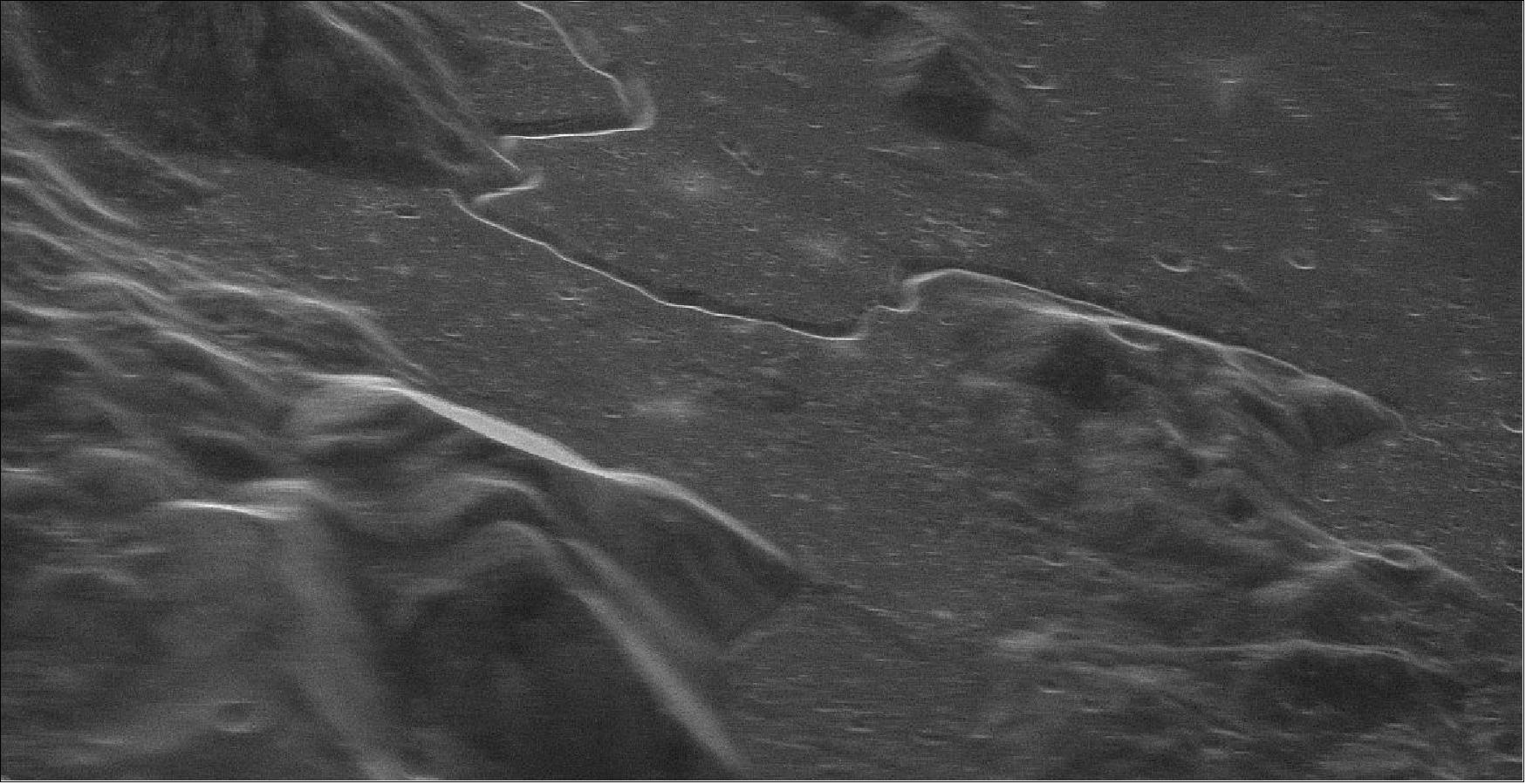
- The technology was developed as part of a cooperative research and development agreement between NRAO, GBO, and Raytheon.
- “This project opens a whole new range of capabilities for both NRAO and GBO,” said Tony Beasley, director of the National Radio Astronomy Observatory and vice president for Radio Astronomy at Associated Universities, Inc. (AUI). “We’ve participated before in important radar studies of the Solar System, but turning the GBT into a steerable planetary radar transmitter will greatly expand our ability to pursue intriguing new lines of research.”
- Using the information collected with this latest test, the participants will finalize a plan to develop a 500 kW, high-power radar system that can image objects in the Solar System with unprecedented detail and sensitivity. The increased performance also will allow astronomers to use radar signals as far away as the orbits of Uranus and Neptune, increasing our understanding of the Solar System.
- “The planned system will be a leap forward in radar science, allowing access to never before seen features of the Solar System from right here on Earth,” said Karen O’Neil, the Green Bank Observatory site director.
- “Raytheon’s radar techniques could ultimately improve our ability to explore the Solar System,” said Steven Wilkinson, Principal Engineering Fellow at Raytheon Intelligence & Space. “Working with the astronomy community allows us to apply decades of radar know-how to a project that provides high-resolution images of near-Earth objects.”
- “We are excited to be partnering with Raytheon and applying their radar expertise to transform our observatories’ telescopes in new science areas,” said AUI President Adam Cohen.
- The National Radio Astronomy Observatory and the Green Bank Observatory are facilities of the National Science Foundation, operated under cooperative agreement by Associated Universities, Inc.
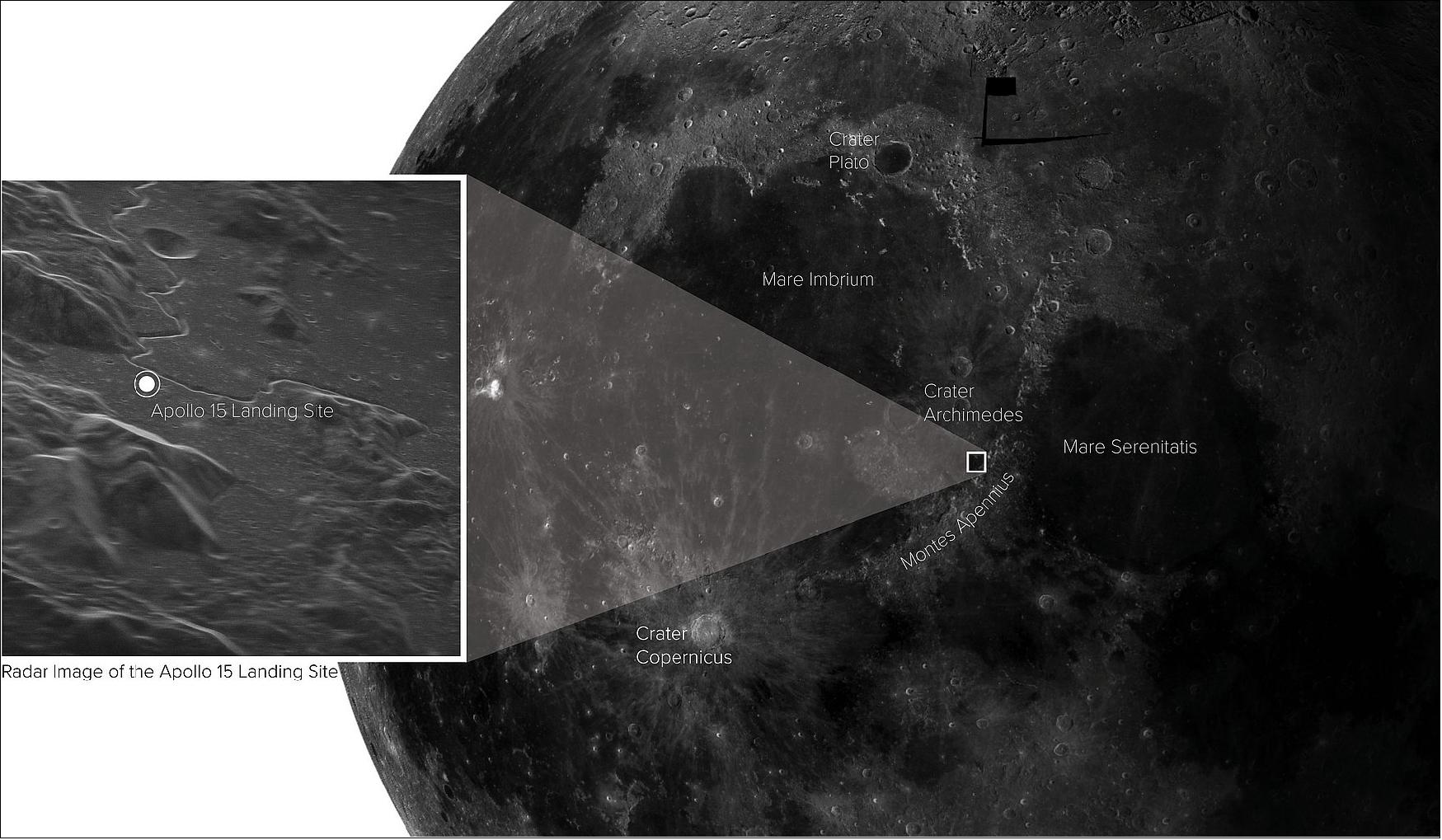
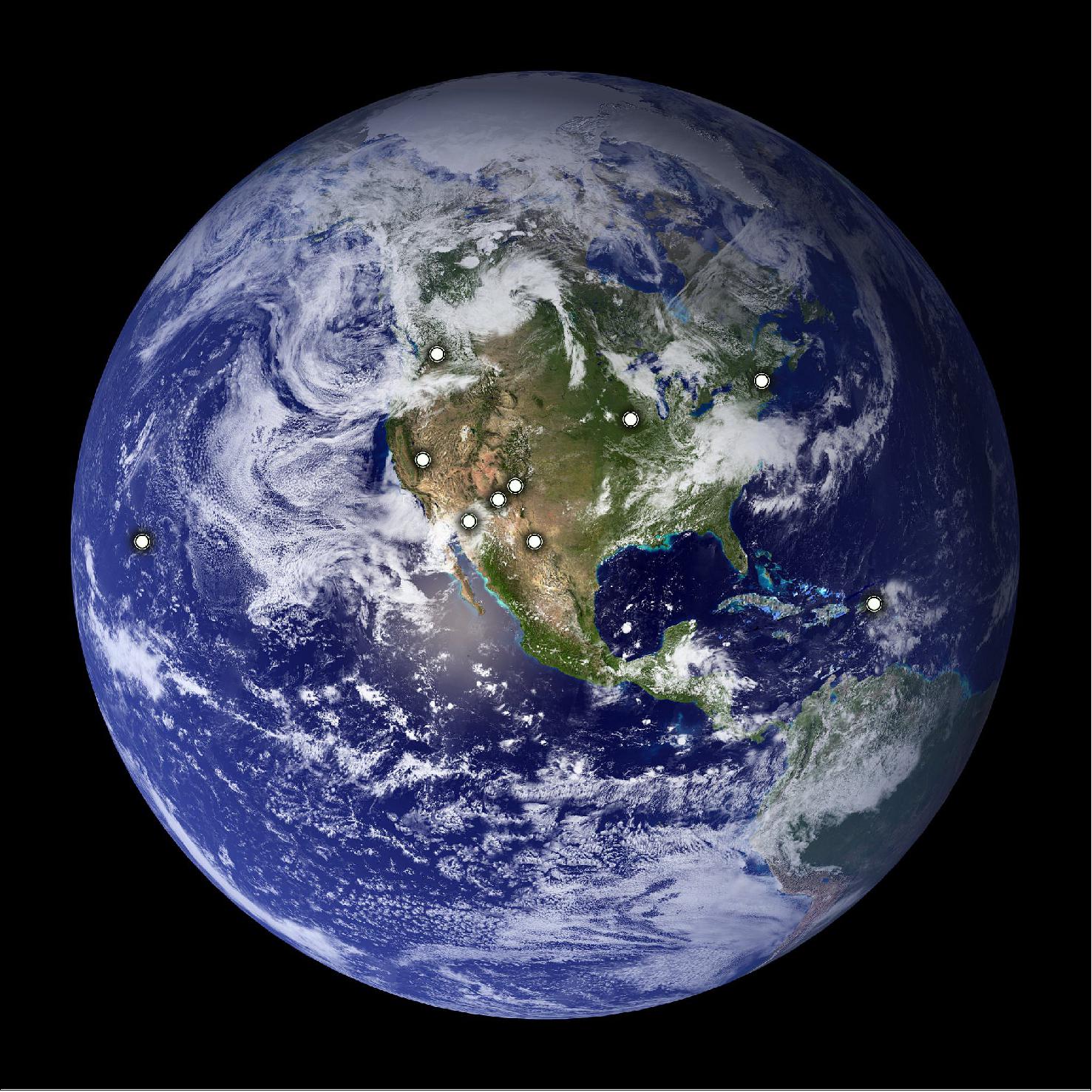
• January 12, 2021: An international team of astronomers has discovered the most distant quasar yet found — a cosmic monster more than 13 billion light-years from Earth powered by a supermassive black hole more than 1.6 billion times more massive than the Sun and more than 1,000 times brighter than our entire Milky Way Galaxy. 48)
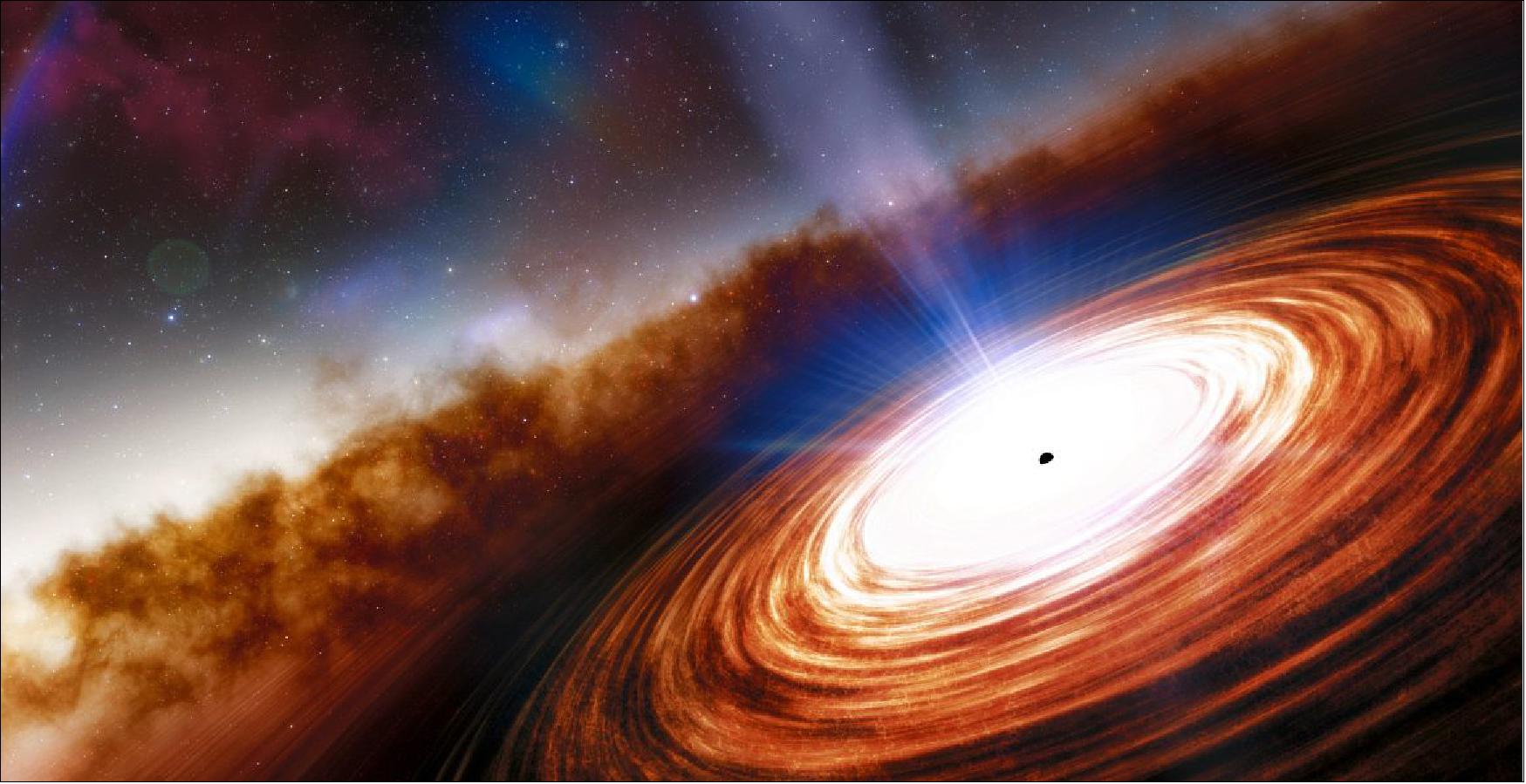
- The scientists presented their findings to the American Astronomical Society’s meeting, now underway virtually, and in a paper accepted to the Astrophysical Journal Letters. 49)
- Quasars occur when the powerful gravity of a supermassive black hole at a galaxy’s core draws in surrounding material that forms an orbiting disk of superheated material around the black hole. The process releases tremendous amounts of energy, making the quasar extremely bright, often outshining the rest of the galaxy.
- The black hole at the core of J0313–1806 is twice as massive as that of the previous record holder and that fact provides astronomers with a valuable clue about such black holes and their affect on their host galaxies.
- “This is the earliest evidence of how a supermassive black hole is affecting the galaxy around it,” said Feige Wang, a Hubble Fellow at the University of Arizona’s Steward Observatory and leader of the research team. “From observations of less distant galaxies, we know that this has to happen, but we have never seen it happening so early in the Universe.”
- The huge mass of J0313–1806’s black hole at such an early time in the Universe’s history rules out two theoretical models for how such objects formed, the astronomers said. In the first of these models, individual massive stars explode as supernovae and collapse into black holes that then coalesce into larger black holes. In the second, dense clusters of stars collapse into a massive black hole. In both cases, however, the process takes too long to produce a black hole as massive as the one in J0313-1806 by the age at which we see it.
- “This tells you that no matter what you do, the seed of this black hole must have formed by a different mechanism,” said Xiaohui Fan, also of the University of Arizona. “In this case, it’s a mechanism that involves vast quantities of primordial, cold hydrogen gas directly collapsing into a seed black hole.”
- The ALMA observations of J0313–1806 provided tantalizing details about the quasar host galaxy, which is forming new stars at a rate 200 times that of our Milky Way. “This is a relatively high star formation rate in galaxies of similar age, and it indicates that the quasar host galaxy is growing very fast,” said Jinyi Yang, the second author of the report, who is a Peter A. Strittmatter Fellow at the University of Arizona.
- The quasar’s brightness indicates that the black hole is swallowing the equivalent of 25 Suns every year. The energy released by that rapid feeding, the astronomers said, probably is powering a powerful outflow of ionized gas seen moving at about 20 percent of the speed of light.
- Such outflows are thought to be what ultimately stops star formation in the galaxy.
- “We think those supermassive black holes were the reason why many of the big galaxies stopped forming stars at some point,” Fan said. “We observe this ‘quenching’ at later times, but until now, we didn’t know how early this process began in the history of the Universe. This quasar is the earliest evidence that quenching may have been happening at very early times.”
- This process also will leave the black hole with nothing left to eat and halt its growth, Fan pointed out.
- In addition to ALMA, the astronomers used the 6.5-meter Magellan Baade telescope, the Gemini North telescope and W. M. Keck Observatory in Hawaii, and the Gemini South telescope in Chile.
- The astronomers plan to continue studying J0313-1806 and other quasars with ground-based and space-based telescopes.
- The National Radio Astronomy Observatory is a facility of the National Science Foundation, operated under cooperative agreement by Associated Universities, Inc.
• January 11, 2021: An international team of scientists may be close to detecting faint ripples in space-time that fill the universe. Pairs of black holes billions of times more massive than the Sun may be circling one another, generating ripples in space itself. The North American Nanohertz Observatory for Gravitational Waves (NANOGrav) has spent more than a decade using ground-based radio telescopes to look for evidence of these space-time ripples created by behemoth black holes. This week, the project announced the detection of a signal that may be attributable to gravitational waves, though members aren't quite ready to claim success. 50)
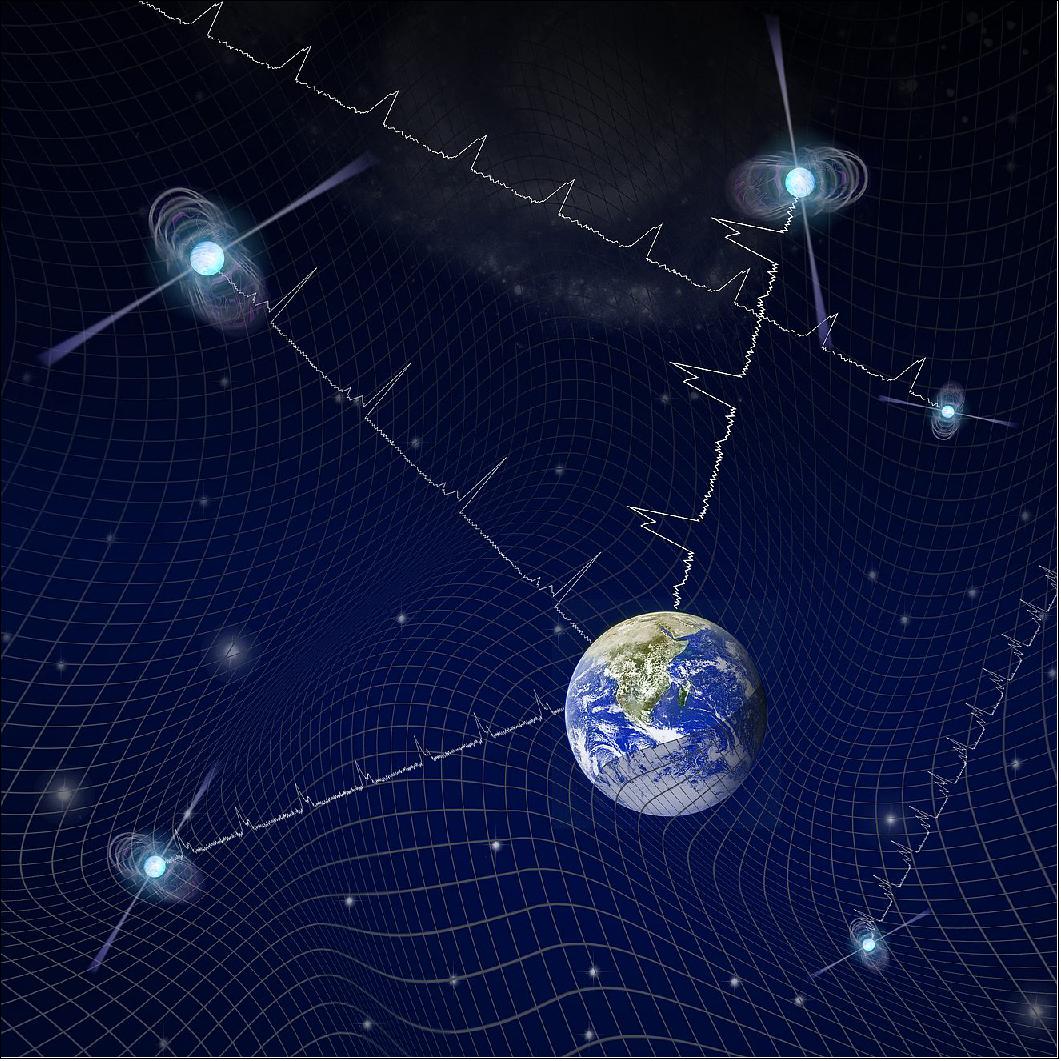
- Gravitational waves were first theorized by Albert Einstein in 1916, but they weren't directly detected until nearly a century later. Einstein showed that rather than being a rigid backdrop for the universe, space is a flexible fabric that is warped and curved by massive objects and inextricably linked with time. In 2015, a collaboration between the U.S.-based Laser Interferometer Gravitational-wave Observatory (LIGO) and the Virgo interferometer in Europe announced the first direct detection of gravitational waves: They were emanating from two black holes - each with a mass about 30 times greater than the Sun - circling one another and merging.
- In a new paper published in the January 2021 issue of the Astrophysical Journal Supplements, the NANOGrav project reports the detection of unexplained fluctuations, consistent with the effects of gravitational waves, in the timing of 45 pulsars spread across the sky and measured over a span of 12 1/2 years. 51)
- Pulsars are dense nuggets of material left over after a star explodes as a supernova. As seen from Earth, pulsars appear to blink on and off. In reality, the light comes from two steady beams emanating from opposite sides of the pulsar as it spins, like a lighthouse. If gravitational waves pass between a pulsar and Earth, the subtle stretching and squeezing of space-time would appear to introduce a small deviation in the pulsar's otherwise regular timing. But this effect is subtle, and more than a dozen other factors are known to influence pulsar timing as well. A major part of the work done by NANOGrav is to subtract those factors from the timing data for each pulsar before looking for signs of gravitational waves.
- LIGO and Virgo detect gravitational waves from individual pairs of black holes (or other dense objects called neutron stars). By contrast, NANOGrav is looking for a persistent gravitational wave "background," or the noiselike combination of waves created over billions of years by countless pairs of supermassive black holes orbiting one another across the universe. These objects produce gravitational waves with much longer wave lengths than those detected by LIGO and Virgo - so long that it might take years for a single wave to pass by a stationary detector. So while LIGO and Virgo can detect thousands of waves per second, NANOGrav's quest requires years of data.
- As tantalizing as the latest finding is, the NANOGrav team isn't ready to claim they've found evidence of a gravitational wave background. Why the hesitation? In order to confirm direct detection of a signature from gravitational waves, NANOGrav's researchers will have to find a distinctive pattern in the signals between individual pulsars. According to Einstein's theory of general relativity, the effect of the gravitational wave background should influence the timing of the pulsars slightly differently based on their positions relative to one another.
- At this point, the signal is too weak for such a pattern to be distinguishable. Boosting the signal will require NANOGrav to expand its dataset to include more pulsars studied for even longer lengths of time, which will increase the array's sensitivity. NANOGrav is also pooling its data with those from other pulsar timing array experiments in a joint effort by the International Pulsar Timing Array, a collaboration of researchers using the world's largest radio telescopes.
- "Trying to detect gravitational waves with a pulsar timing array requires patience," said Scott Ransom with the National Radio Astronomy Observatory and the current chairperson of NANOGrav. "We're currently analyzing over a dozen years of data, but a definitive detection will likely take a couple more. It's great that these new results are exactly what we would expect to see as we creep closer to a detection."
- The NANOGrav team discussed their findings at a press conference on Jan. 11 at the 237th meeting of the American Astronomical Society, held virtually from Jan. 10 to 15. Michele Vallisneri and Joseph Lazio, both astrophysicists at NASA's Jet Propulsion Laboratory in Southern California, and Zaven Arzoumanian at NASA's Goddard Space Flight Center in Maryland are co-authors of the paper. Joseph Simon, a researcher at University of Colorado Boulder and the paper's lead author, conducted much of the analysis for the paper as a postdoctoral researcher at JPL. Multiple NASA postdoctoral fellows have participated in the NANOGrav research while at JPL. NANOGrav is a collaboration of U.S. and Canadian astrophysicists. The data in the new study was collected using the Green Bank antenna in West Virginia and the Arecibo dish in Puerto Rico before its recent collapse.
• January 5, 2021: Astronomers refer to observations as “deep” when they are taken with very long exposure times. Just as with photography, this gathers more light, revealing distant, fainter objects. Deeper exposures let astronomers look deeper into the Universe — hence the name. This particular deep image was taken with a 70-minute exposure with the Nicholas U. Mayall 4-meter Telescope at Kitt Peak National Observatory, a Program of NSF’s NOIRLab, and captures the spiral galaxy NGC 1003. 52)
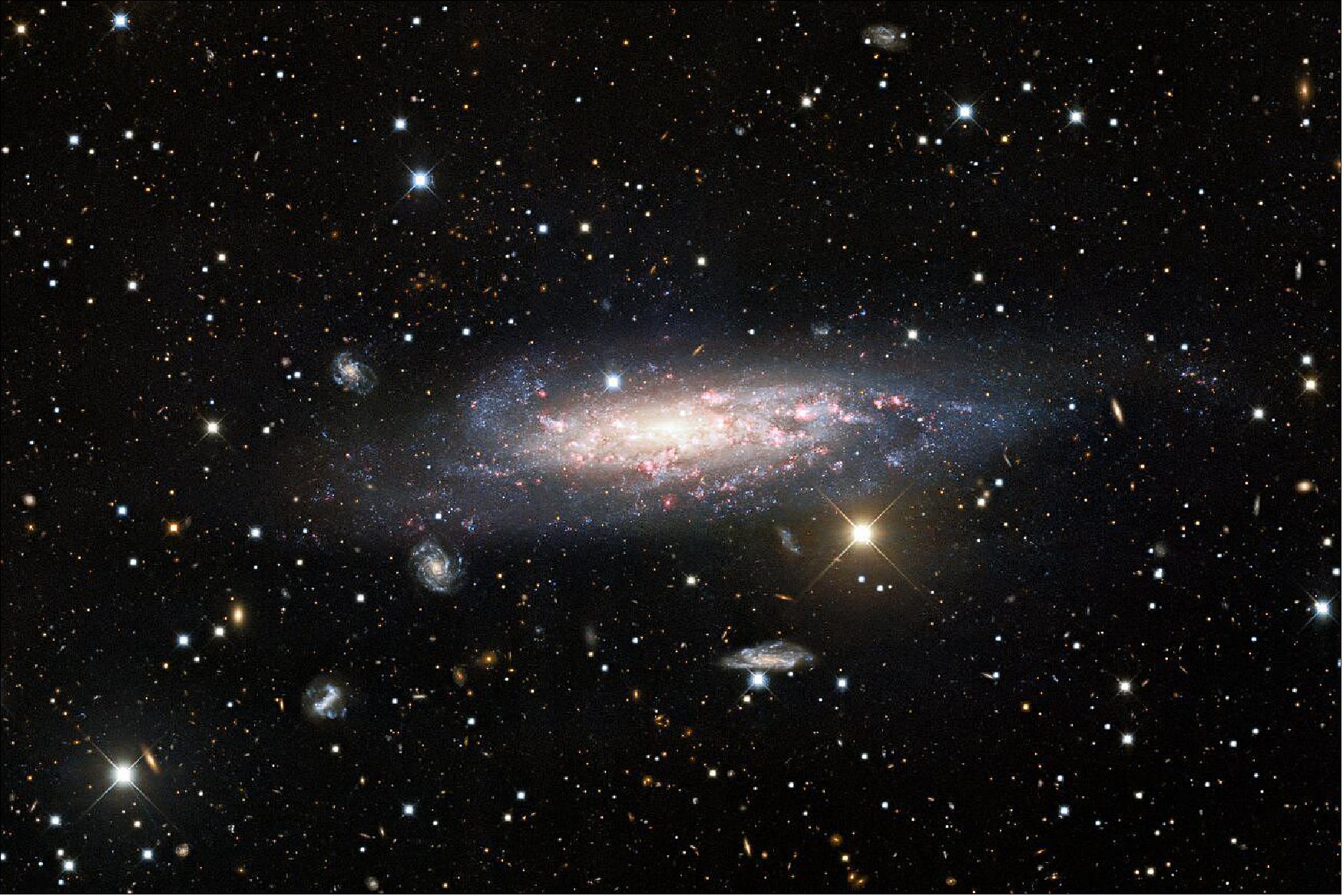
- NGC 1003 lies over 30 million light-years from Earth in the direction of the constellation Perseus. While it makes for a spectacular sight, it is only one of many galaxies captured in this image. Upon closer inspection, other galaxies can also be seen strewn throughout the image, with everything from delicate spiral galaxies to hundreds of fuzzy, red elliptical galaxies lurking in the background. The long exposure time of this deep observation — arguably the deepest image of NGC 1003 ever captured — allowed these usually overlooked background cluster galaxies to be captured in breathtaking detail.
- Deep images such as this one have had an important role in shaping our understanding of the Universe. In 1995, the Hubble Space Telescope famously observed a tiny, nondescript patch of sky for 10 days to create the Hubble Deep Field. The observations revealed thousands of distinct galaxies, showing that our Universe is a surprisingly crowded place.
- While the Hubble team deliberately avoided bright galaxies for their observation, this ground-based observation is littered with galaxies of all shapes and sizes — a spectacular backdrop for this portrait of NGC 1003. As well as revealing the host of background galaxies, the long exposure time of this observation allowed the researchers to capture the faint outer reaches of NGC 1003, which are threaded through with bright tendrils of stars. Equally eye-catching is the bright heart of the galaxy, which is surrounded by clouds of dense dust.
- NGC 1003 resides in front of a galaxy cluster — a vast collection of galaxies bound together by gravity. These structures are among the most massive in the known Universe, and outweigh the Sun by a factor of a thousand trillion. Just as stars can be grouped into clusters, and these star clusters into galaxies, galaxies themselves form clusters and even superclusters — building up the large-scale structure of our Universe.
• December 22, 2020: The supersharp radio “vision” of the National Science Foundation’s Very Long Baseline Array (VLBA) has revealed previously unseen details in a jet of material ejected at three-quarters the speed of light from the core of a galaxy some 12.8 billion light-years from Earth. The galaxy, dubbed PSO J0309+27, is a blazar, with its jet pointed toward Earth, and is the brightest radio-emitting blazar yet seen at such a distance. It also is the second-brightest X-ray emitting blazar at such a distance. 53)
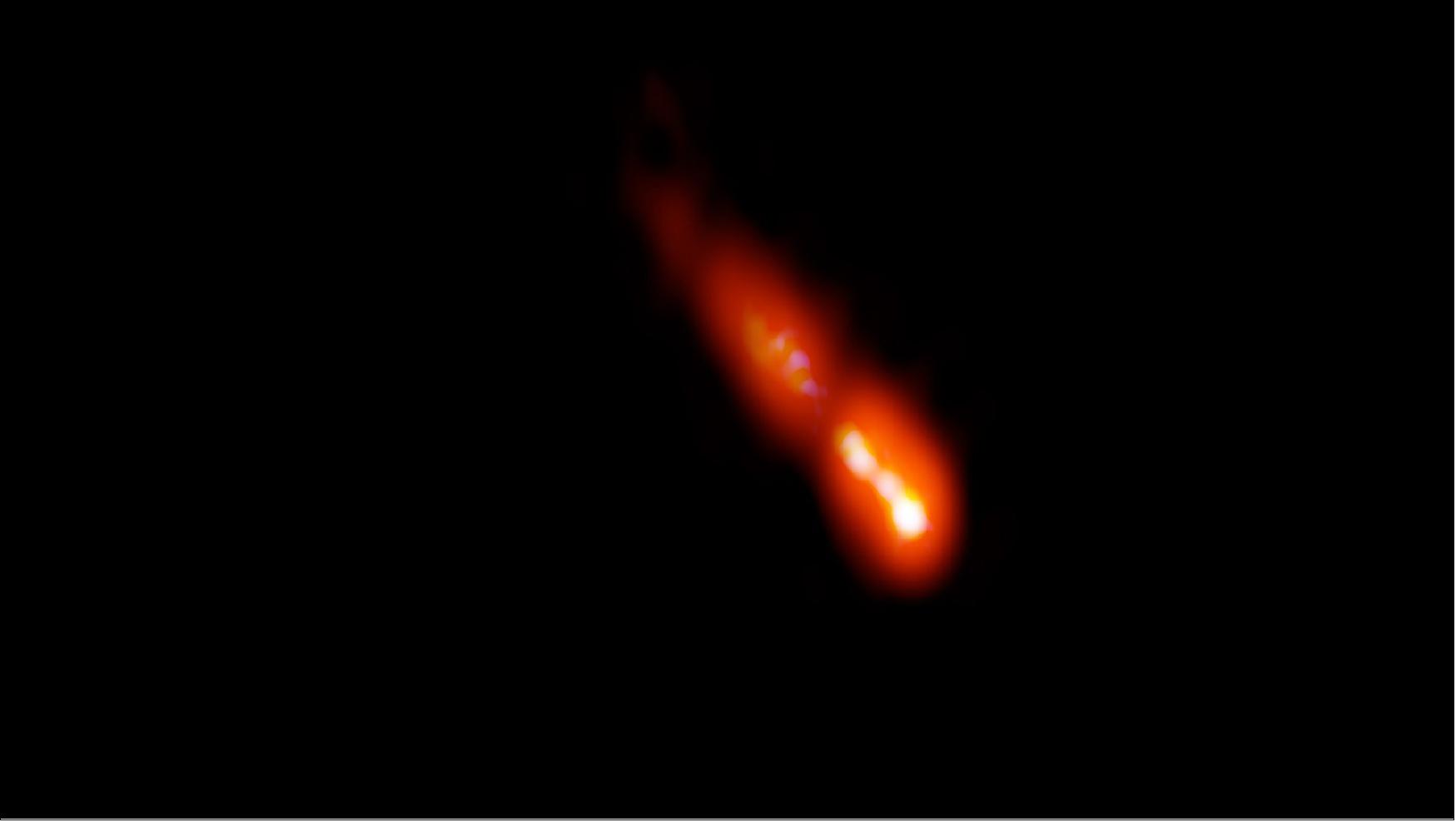
- In this image, the brightest radio emission comes from the galaxy’s core, at bottom right. The jet is propelled by the gravitational energy of a supermassive black hole at the core, and moves outward, toward the upper left. The jet seen here extends some 1,600 light-years, and shows structure within it.
- At this distance, PSO J0309+27 is seen as it was when the universe was less than a billion years old, or just over 7 percent of its current age.
- An international team of astronomers led by Cristiana Spingola of the University of Bologna in Italy, observed the galaxy in April and May of 2020. Their analysis of the object’s properties provides support for some theoretical models for why blazars are rare in the early universe. The researchers reported their results in the journal Astronomy & Astrophysics. 54)
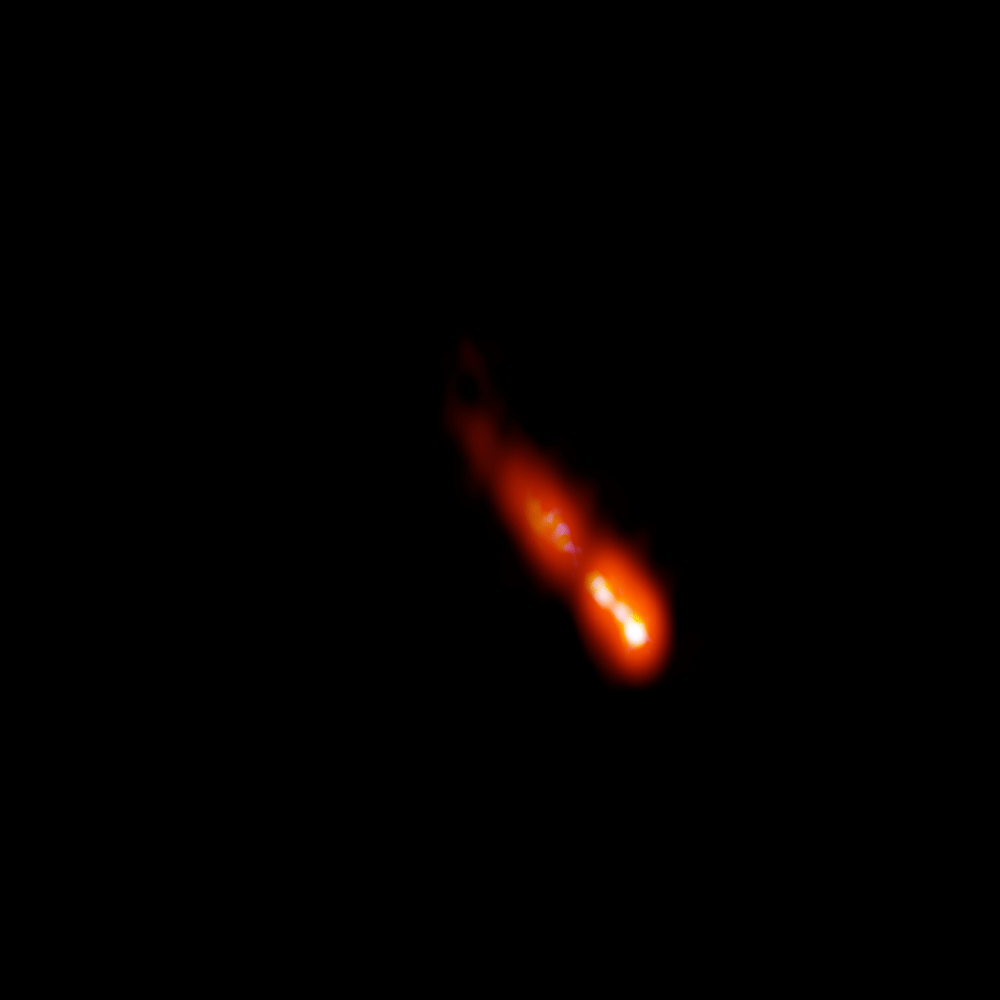
• December 3, 2020: Completed in 1963 and stewarded by U.S. National Science Foundation since the 1970s, Arecibo Observatory has contributed to many important scientific discoveries, including the demonstration of gravitational waves from a binary pulsar, the first discovery of an extrasolar planet, composition of the ionosphere, and the characterization of the properties and orbits of a number of potentially hazardous asteroids. 55)
The video footage of the collapse of the Arecibo Observatory is documented in two videos under ”Multimedia Resources” in Ref. 55).
This video was taken from the vantage point of the Arecibo operations building (Building 1), where the Arecibo telescope operators conduct telescope operations. At the center of the video is the telescope platform, including the Gregorian dome. The catwalk, used to walk from the ground up to the top of the platform, is seen to extend from the left side of the frame to the top of the platform. Tower 4, the location of the August 10th auxiliary cable failure and the failure of Main Cable M4-2, followed by M4-1 and M4-3 and the remaining Tower 4 auxiliary cable. The auxiliary cables were added in the 1990's to support the added weight of the Gregorian dome. With support no longer provided by Tower 4 cables, one second later, the corner of the platform begins to drop. With the Tower 12 cables, off the frame to the left, and Tower 8 cables, off the frame to the right, still connected to the platform, the platform swings down toward a point mid-way between the two towers. Next the support cables from Tower 12, off the frame to the left, slice through the middle of the catwalk, which comes crashing down into the dish. After that, the 328 ft long bow-shaped azimuth arm and Gregorian dome begin to separate from the platform. Next the seven Tower 4 backstay cables that connect the top of Tower 4 to the ground begin to pull the top section of Tower 4 to the ground. The fate of the top section of Tower 12, off the frame to the left, is similar to that of Tower 4. The top section of Tower 12 is seen entering the top left corner of the frame and then, tumbling down the hill, to rest in front of the operations building. Trees in the left of the frame suffer considerable damage as they are sliced by the falling Tower 12 top section and cables. (video footage of the collapse of the Arecibo Observatory) — Video 2: This video, that starts with a view of the top of Tower 4, was taken from the vantage point of an Arecibo Observatory drone, utilized for monitoring the condition of Tower 4 support cables. Four cables are seen in the center of this video. The top cable does not support the telescope platform, but instead supports the catwalk described in the narrative for the previous video. The three lower cables are, from left to right, M4-1, M4-2, and M4-3. Note that a number of individual wire strands of the M4-1 and M4-2 cables are noticeably broken at the beginning of this video. The M4-3 cable does not appear to have any broken wires at the beginning of this video. The first indication of the coming failure is the breaking of another M4-2 wire, accompanied by a puff of "smoke" and chips of paint flying away from the surface of the cable. Four seconds later the entire M4-2 cable appears to disintegrate. The failure of M4-2 is followed a fraction of a second later by the failure of M4-1, followed a fraction of a second later by the failure of M4-3. The drone operator then swings the drone around to view the reflector dish and fallen platform, azimuth arm, Gregorian dome, and the falling cables and catwalk. The top section of Tower 12, near the Visitor Center, can be seen tumbling down the hill to the left of the operations building. The Tower 12 backstay cables that connect the top of Tower 12 to the ground cause damage behind Tower 12, well away from the edge of the telescope dish.
• November 19, 2020: Astronomers using data from the ongoing VLA Sky Survey (VLASS) have found a number of distant galaxies with supermassive black holes at their cores that have launched powerful, radio-emitting jets of material within the past two decades or so. The scientists compared data from VLASS with data from an earlier survey that also used the National Science Foundation’s Karl G. Jansky Very Large Array (VLA) to reach their conclusion. 56)
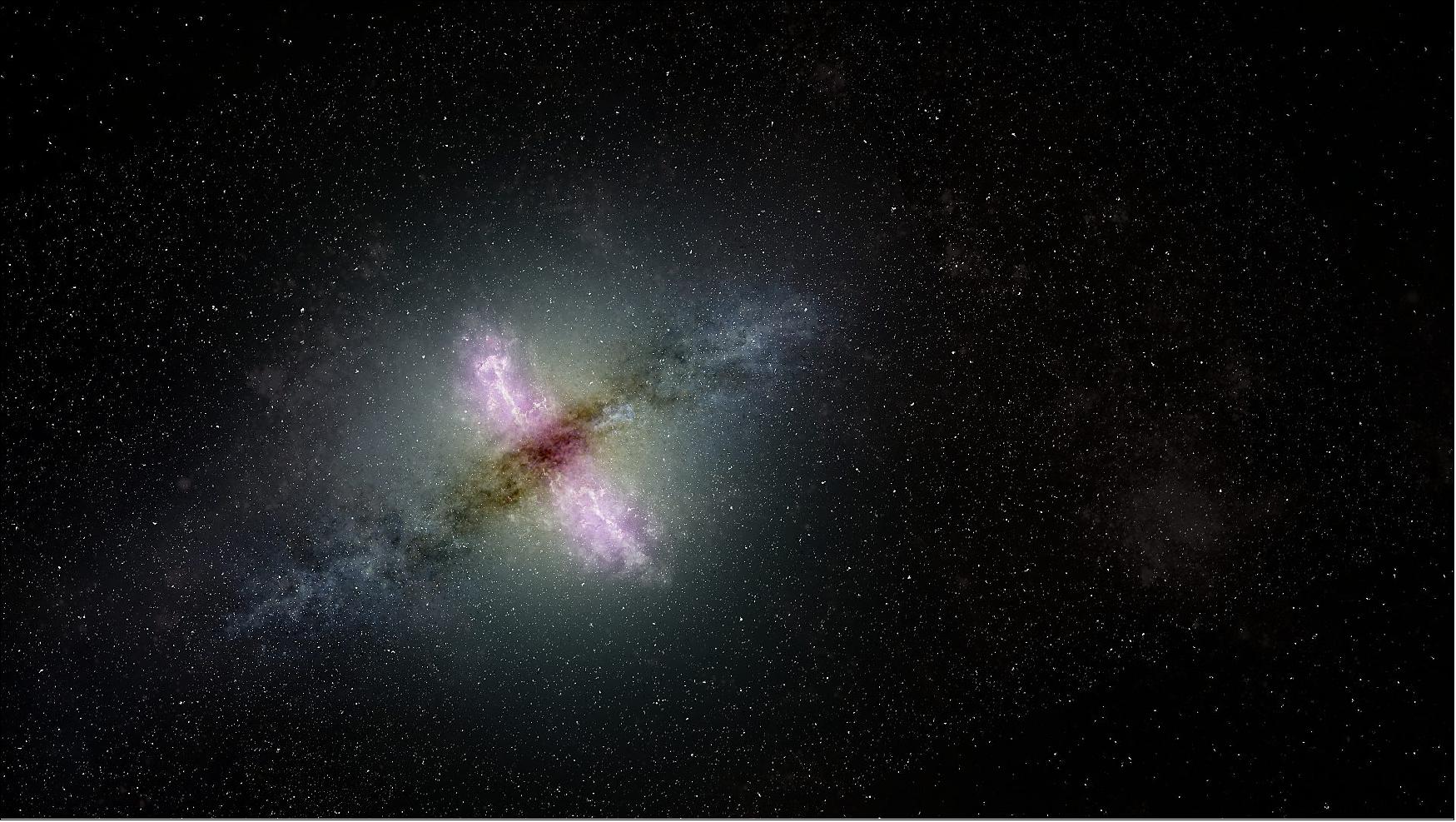
- “We found galaxies that showed no evidence of jets before but now show clear indications of having young, compact jets,” said Dr. Kristina Nyland, who is an NRC postdoctoral fellow in residence at the Naval Research Laboratory.
- “Jets like these can strongly affect the growth and evolution of their galaxies, but we still don’t understand all of the details. Catching newborn jets with surveys like VLASS provides a measure of the role of powerful radio jets in shaping the lives of the galaxies over billions of years,” Nyland said.
- VLASS is a project that will survey the sky visible from the VLA — about 80 percent of the entire sky — three times over seven years. The observations began in 2017 and the first of the three scans now is complete. Nyland and her colleagues compared data from this scan with data from the FIRST (Faint Images of the Radio Sky at Twenty cm) Survey that used the VLA to observe a smaller portion of the sky between 1993 and 2011.
- They found about 2,000 objects that appear in the VLASS images, but were not detected in the earlier FIRST survey. From these, they selected 26 objects that previously were categorized as galaxies with active nuclei — powered by supermassive black holes — by optical and infrared observations. The FIRST observations of the 26 objects had been made between 1994 and 2001. The VLASS observations were made in 2019. The intervals between observations of the objects thus ranged from 18 to 25 years.
- They chose 14 of these galaxies for more detailed observations with the VLA. These observations provided higher-resolution images and also were done at multiple radio frequencies to get a more complete understanding of the objects’ characteristics.
- “The data from these detailed observations tell us that the most likely cause of the difference in radio brightness between the FIRST and the VLASS observations is that the ‘engines’ at the cores of these galaxies have launched new jets since the FIRST observations were made,” explained Dillon Dong, from Caltech.
- The black holes at the cores of galaxies are known to interact with the galaxies themselves, and the two evolve together. The jets launched from the regions near the black holes can affect the amount of star formation within the galaxy.
- “Radio jets provide natural laboratories for learning about the extreme physics of supermassive black holes, whose formation and growth are believed to be intrinsically linked to that of the galaxy centers in which they reside,” said Pallavi Patil, of the University of Virginia.
- “Jets as young as the ones discovered in our study can provide us with a rare opportunity to gain new insights on how these interactions between the jets and their surroundings work,” Nyland said.
- “VLASS has proven to be a key tool for discovering such jets, and we eagerly await the results of its next two observing epochs,” said Mark Lacy, of the National Radio Astronomy Observatory.
- Nyland and her colleagues plan further studies of the galaxies using the Very Long Baseline Array (VLBA), the Chandra X-Ray Observatory, and visible-light and infrared telescopes. They are reporting their results in the Astrophysical Journal. 57)
• November 19, 2020: The National Radio Astronomy Observatory (NRAO) and the Green Bank Observatory (GBO) are saddened by the announcement of the decommissioning of the Arecibo Telescope in Puerto Rico due to recent and devastating structural damage. 58)
- The 305-meter Arecibo radio telescope has a long and distinguished history of landmark contributions to astronomy and planetary science and often has been a valued partner with NRAO telescopes and the Green Bank Telescope in research projects. Its loss will be a blow to science.
- The staff and facilities of NRAO and GBO stand ready to assist in filling the gap that this loss will create, and offer our best wishes to our colleagues who are affected by this development.
![Figure 40: Photo of the 305-meter Radio Telescope of the Arecibo Observatory in Puerto Rico [image credit: UCF (University of Central Florida)]](https://www.eoportal.org/ftp/satellite-missions/n/NRAO_270622/NRAO_Auto1E.jpeg)
- Following a review of engineering assessments that found damage to the Arecibo Observatory cannot be stabilized without risk to construction workers and staff at the facility, the U.S. National Science Foundation will begin plans to decommission the 305-meter telescope, which for 57 years has served as a world-class resource for radio astronomy, planetary, solar system and geospace research. 59)
- The decision comes after NSF evaluated multiple assessments by independent engineering companies that found the telescope structure is in danger of a catastrophic failure and its cables may no longer be capable of carrying the loads they were designed to support. Furthermore, several assessments stated that any attempts at repairs could put workers in potentially life-threatening danger. Even in the event of repairs going forward, engineers found that the structure would likely present long-term stability issues.
- "NSF prioritizes the safety of workers, Arecibo Observatory’s staff and visitors, which makes this decision necessary, although unfortunate," said NSF Director Sethuraman Panchanathan. "For nearly six decades, the Arecibo Observatory has served as a beacon for breakthrough science and what a partnership with a community can look like. While this is a profound change, we will be looking for ways to assist the scientific community and maintain that strong relationship with the people of Puerto Rico."
- Engineers have been examining the Arecibo Observatory 305-meter telescope since August, when one of its support cables detached. NSF authorized the University of Central Florida, which manages Arecibo, to take all reasonable steps and use available funds to address the situation while ensuring safety remained the highest priority. UCF acted quickly, and the evaluation process was following its expected timeline, considering the age of the facility, the complexity of the design and the potential risk to workers.
- The engineering teams had designed and were ready to implement emergency structural stabilization of the auxiliary cable system. While the observatory was arranging for delivery of two replacement auxiliary cables, as well as two temporary cables, a main cable broke on the same tower Nov. 6. Based on the stresses on the second broken cable — which should have been well within its ability to function without breaking — engineers concluded that the remaining cables are likely weaker than originally projected.
- "Leadership at Arecibo Observatory and UCF did a commendable job addressing this situation, acting quickly and pursuing every possible option to save this incredible instrument," said Ralph Gaume, director of NSF's Division of Astronomical Sciences. "Until these assessments came in, our question was not if the observatory should be repaired but how. But in the end, a preponderance of data showed that we simply could not do this safely. And that is a line we cannot cross."
- The scope of NSF's decommissioning plan would focus only on the 305-meter telescope and is intended to safely preserve other parts of the observatory that could be damaged or destroyed in the event of an unplanned, catastrophic collapse. The plan aims to retain as much as possible of the remaining infrastructure of Arecibo Observatory, so that it remains available for future research and educational missions.
- The decommissioning process involves developing a technical execution plan and ensuring compliance with a series of legal, environmental, safety and cultural requirements over the coming weeks. NSF has authorized a high-resolution photographic survey using drones, and is considering options for forensic evaluation of the broken cable — if such action could be done safely — to see if any new evidence could inform the ongoing plans. This work has already begun and will continue throughout the decommissioning planning. Equipment and other materials will be temporarily moved to buildings outside the danger zone. When all necessary preparations have been made, the telescope would be subject to a controlled disassembly.
- After the telescope decommissioning, NSF would intend to restore operations at assets such as the Arecibo Observatory LIDAR facility — a valuable geospace research tool — as well as at the visitor center and offsite Culebra facility, which analyzes cloud cover and precipitation data. NSF would also seek to explore possibilities for expanding the educational capacities of the learning center. Safety precautions due to the COVID-19 pandemic will remain in place as appropriate.
- Some Arecibo operations involving the analysis and cataloging of archived data collected by the telescope would continue. UCF secured enhanced cloud storage and analytics capabilities in 2019 through an agreement with Microsoft, and the observatory is working to migrate on-site data to servers outside of the affected area.
- Areas of the observatory that could be affected by an uncontrolled collapse have been evacuated since the November cable break and will remain closed to unauthorized personnel during the decommissioning. NSF and UCF will work to minimize risk in the area in the event of an unexpected collapse. NSF has prioritized a swift, thorough process with the intent of avoiding such an event.
- NSF recognizes the cultural and economic significance of Arecibo Observatory to Puerto Rico, and how the telescope serves as an inspiration for Puerto Ricans considering education and employment in STEM. NSF's goal is to work with the Puerto Rican government and other stakeholders and partners to explore the possibility of applying resources from Arecibo Observatory for educational purposes.
- "Over its lifetime, Arecibo Observatory has helped transform our understanding of the ionosphere, showing us how density, composition and other factors interact to shape this critical region where Earth’s atmosphere meets space," said Michael Wiltberger, head of NSF's Geospace Section. "While I am disappointed by the loss of investigative capabilities, I believe this process is a necessary step to preserve the research community's ability to use Arecibo Observatory's other assets and hopefully ensure that important work can continue at the facility."
Engineering Summary
- Arecibo Observatory’s telescope consists of a radio dish 1,000 feet (305 meters) wide in diameter with a 900-ton instrument platform hanging 450 feet above. The platform is suspended by cables connected to three towers.
- On Aug. 10, 2020, an auxiliary cable failed, slipping from its socket in one of the towers and leaving a 100-foot gash in the dish below. NSF authorized Arecibo Observatory to take all reasonable steps and use available funds, which amounted to millions of dollars, to secure the analysis and equipment needed to address the situation. Engineers were working to determine how to repair the damage and determine the integrity of the structure when a main cable connected to the same tower broke Nov. 6.
- The second broken cable was unexpected -- engineering assessments following the auxiliary cable failure indicated the structure was stable and the planning process to restore the telescope to operation was underway. Engineers subsequently found this 3-inch main cable snapped at about 60% of what should have been its minimum breaking strength during a period of calm weather, raising the possibility of other cables being weaker than expected.
- Inspections of the other cables revealed new wire breaks on some of the main cables, which were original to the structure, and evidence of significant slippage at several sockets holding the remaining auxiliary cables, which were added during a refit in the 1990s that added weight to the instrument platform.
- Thornton Tomasetti, the engineering firm of record hired by UCF to assess the structure, found that given the likelihood of another cable failing, repair work on the telescope — including mitigation measures to stabilize it for additional work — would be unsafe. Stress tests to capture a more accurate measure of the remaining cables' strength could collapse the structure, Thornton Tomasetti found. The firm recommended a controlled demolition to eliminate the danger of an unexpected collapse.
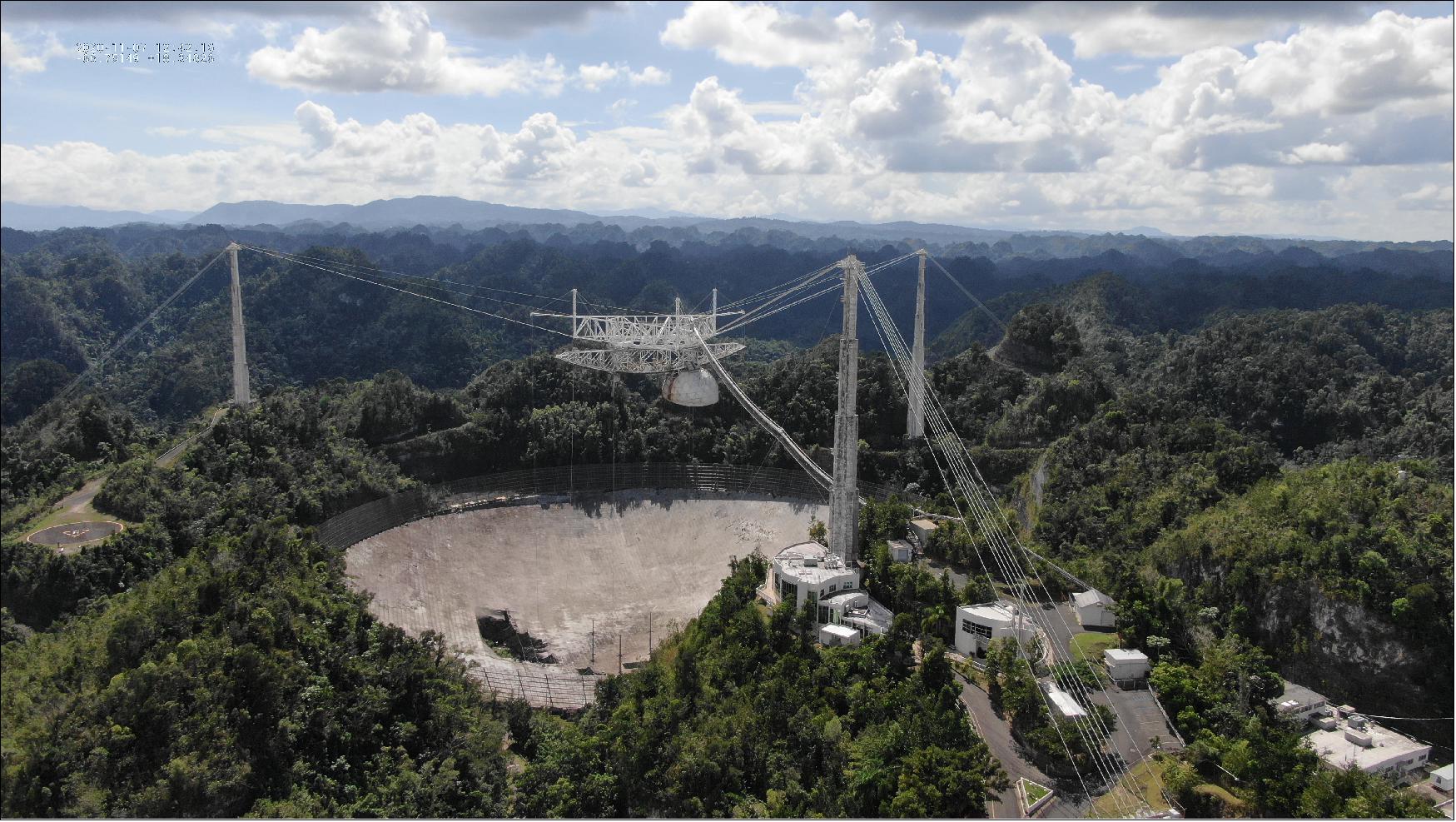
- "Although it saddens us to make this recommendation, we believe the structure should be demolished in a controlled way as soon as pragmatically possible, " said the recommendation for action letter submitted by Thornton Tomasetti. "It is therefore our recommendation to expeditiously plan for decommissioning of the observatory and execute a controlled demolition of the telescope."
- UCF also hired two other engineering firms to provide assessments of the situation. One recommended immediate stabilization action. The other, after reviewing Thornton Tomasetti's model, concurred that there is no course of action that could safely verify the structure's stability and advised against allowing personnel on the telescope's platforms or towers.
- “Critical work remains to be done in the area of atmospheric sciences, planetary sciences, radio astronomy and radar astronomy,” UCF President Alexander N. Cartwright said. “UCF stands ready to utilize its experience with the observatory to join other stakeholders in pursuing the kind of commitment and funding needed to continue and build on Arecibo’s contributions to science.”
- After receiving the contracted assessments, NSF brought in an independent engineering firm and the Army Corps of Engineers to review the findings. The firm NSF hired concurred with the recommendations of Thornton Tomasetti and expressed concern about significant danger from uncontrolled collapse. The Army Corps of Engineers recommended gathering additional photographic evidence of the facility and a complete forensic evaluation of the broken cable.
- Given the fact that any stabilization or repair scenario would require workers to be on or near the telescope structure, the degree of uncertainty about the cables' strength and the extreme forces at work, NSF accepted the recommendation to prepare for controlled decommissioning of the 305-meter telescope.
• November 12, 2020: For galaxies, as for people, living in a crowd is different from living alone. Recently, astronomers used the National Science Foundation’s Karl G. Jansky Very Large Array (VLA) to learn how a crowded environment affects galaxies in the Perseus Cluster, a collection of thousands of galaxies some 240 million light-years from Earth. 60)

- Such images can help astronomers better understand the complex environment of galaxy clusters, which are the largest gravitationally-bound structures in the universe, and which harbor a variety of still poorly-understood phenomena.
- “These images show us previously-unseen structures and details and that helps our effort to determine the nature of these objects,” said Marie-Lou Gendron-Marsolais, an ESO/ALMA Fellow in Santiago, Chile. She and a number of international collaborators are announcing their results in the Monthly Notices of the Royal Astronomical Society. 61)
• October 10, 2020 marked 40 years, since the National Science Foundation’s Karl G. Jansky Very Large Array (VLA) was dedicated in a ceremony attended by hundreds in the high desert of New Mexico. In the four decades since, the VLA has become not only the world’s most famous radio telescope, but also the most scientifically-productive ground-based telescope in the history of astronomy. A premier tool for researchers from around the world, it has enabled landmark discoveries across the entire range of astronomical specialties and its many contributions are found throughout today’s astronomy textbooks. 62)
- In 1980, the VLA provided unprecedented new research capabilities to the world’s astronomers and from that time it has remained at the forefront of astrophysical science. Scientists have used the VLA to study everything from the nearby planets of our own Solar System to galaxies many billions of light-years away, and everything in between.
- In 2012, the National Radio Astronomy Observatory completed a decade-long project that incorporated state-of-the-art technology to transform the VLA into a new and vastly more powerful scientific tool. With its research capabilities multiplied far beyond those of the original system, the VLA once again provided astronomers with an unmatched tool for discovery.
- In addition to its research contributions, the VLA’s iconic nature has made it a valuable resource for education, both formal and informal. The VLA Visitor Center provides enriching experiences for tourists, families, and school groups, and its programs augment the K-12 science curriculum. College undergraduates and graduate students pursue research using the VLA, and data from the VLA has formed the basis for more than 500 Ph.D dissertations.
- From grade schoolers to graduate students, from Nobel laureates to the general public, the VLA has spurred interest in the fascinating Universe in which we live. The VLA also has captured the imagination of filmmakers, photographers, artists, and writers. Images of the VLA’s giant dish antennas regularly appear in feature films, documentaries, commercials, magazines, newspapers, and advertisements around the globe.
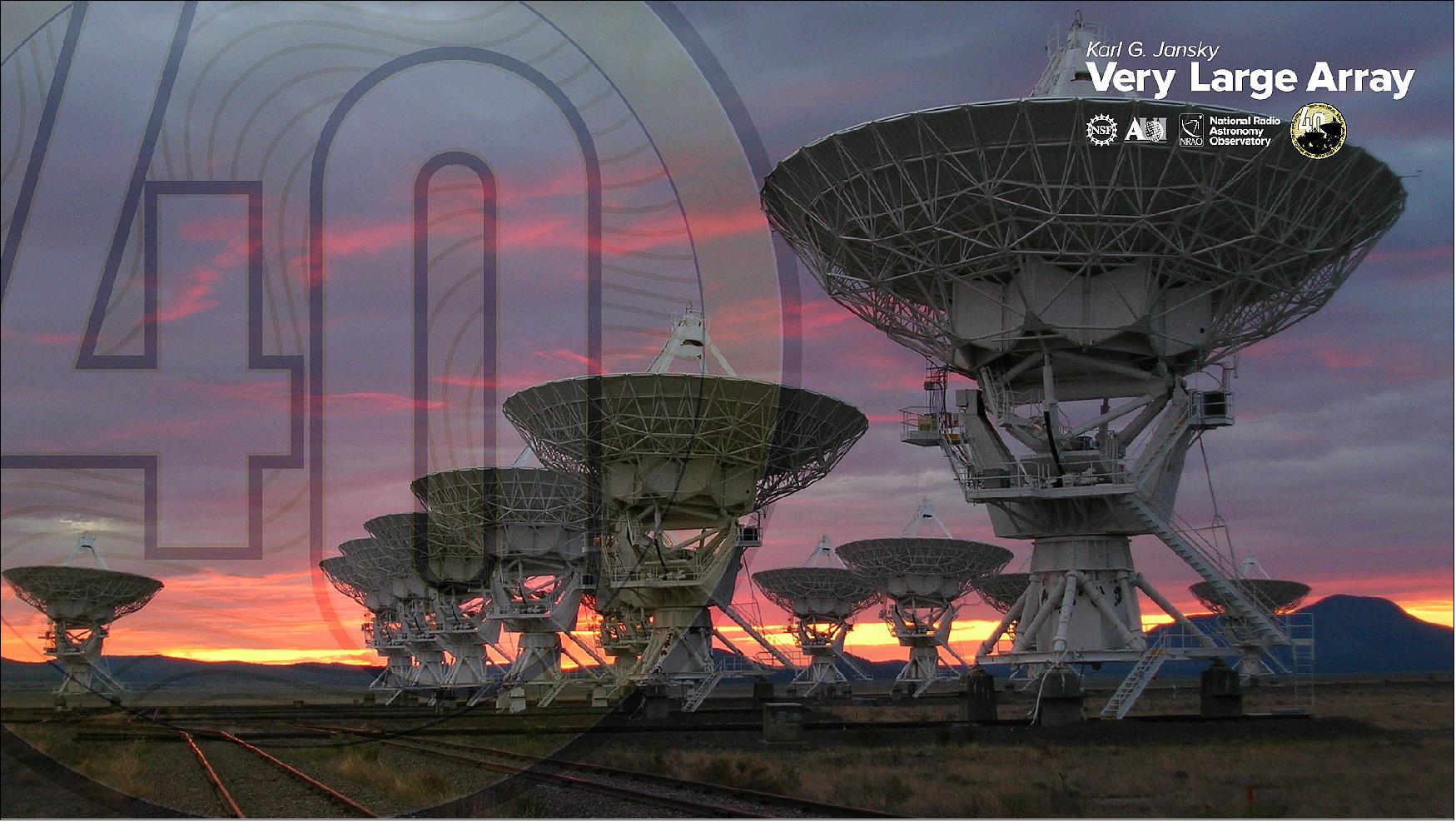
• September 18, 2020: Astronomers using the National Science Foundation’s Very Long Baseline Array (VLBA) have made the first direct geometric measurement of the distance to a magnetar within our Milky Way Galaxy — a measurement that could help determine if magnetars are the sources of the long-mysterious Fast Radio Bursts (FRBs). 63)
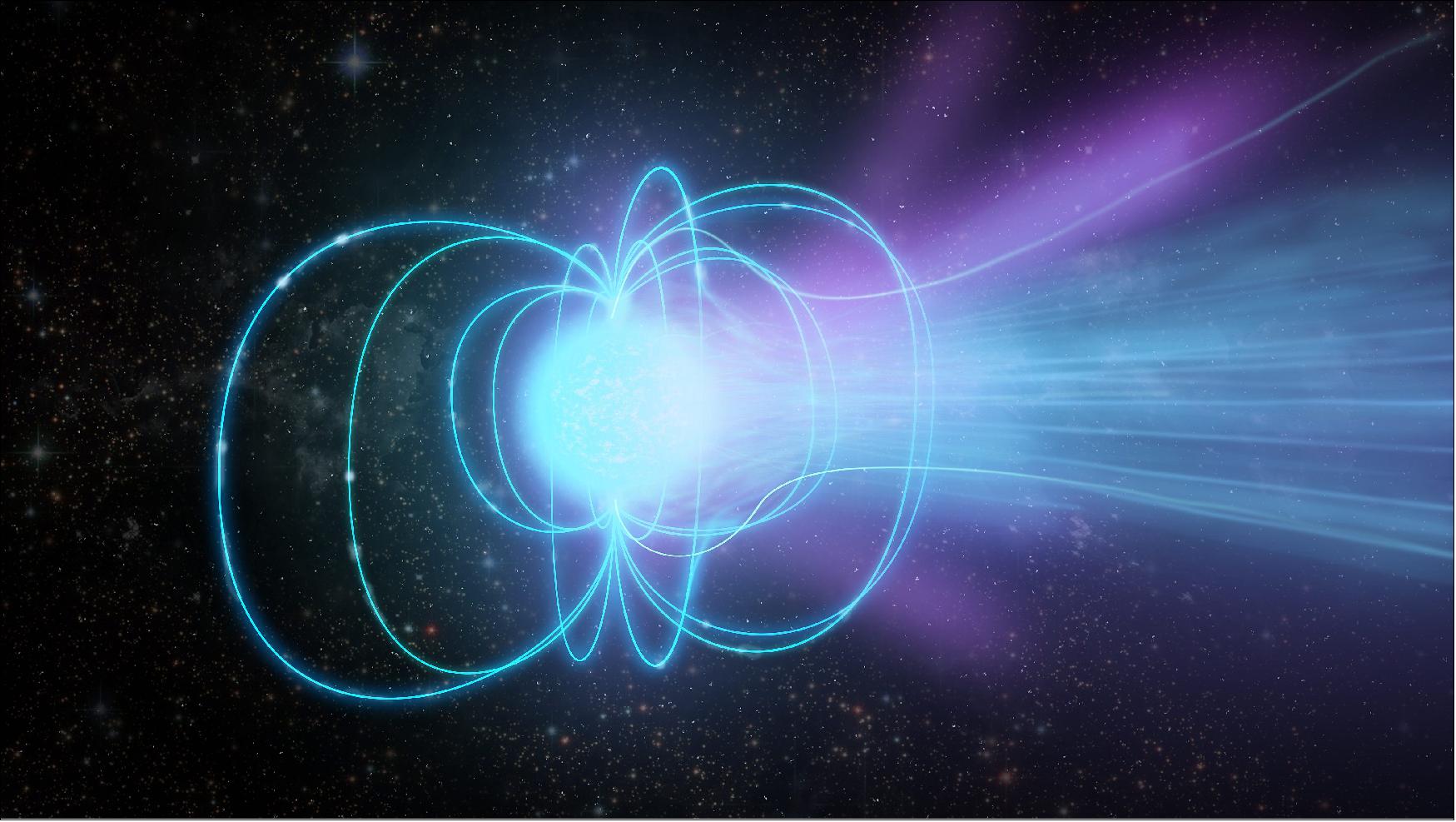
- Magnetars are a variety of neutron stars — the superdense remains of massive stars that exploded as supernovae — with extremely strong magnetic fields. A typical magnetar magnetic field is a trillion times stronger than the Earth’s magnetic field, making magnetars the most magnetic objects in the Universe. They can emit strong bursts of X-rays and gamma rays, and recently have become a leading candidate for the sources of FRBs.
- A magnetar called XTE J1810-197, discovered in 2003, was the first of only six such objects found to emit radio pulses. It did so from 2003 to 2008, then ceased for a decade. In December of 2018, it resumed emitting bright radio pulses.
- A team of astronomers used the VLBA to regularly observe XTE J1810-197 from January to November of 2019, then again during March and April of 2020. By viewing the magnetar from opposite sides of the Earth’s orbit around the Sun, they were able to detect a slight shift in its apparent position with respect to background objects much more distant. This effect, called parallax, allows astronomers to use geometry to directly calculate the object’s distance.
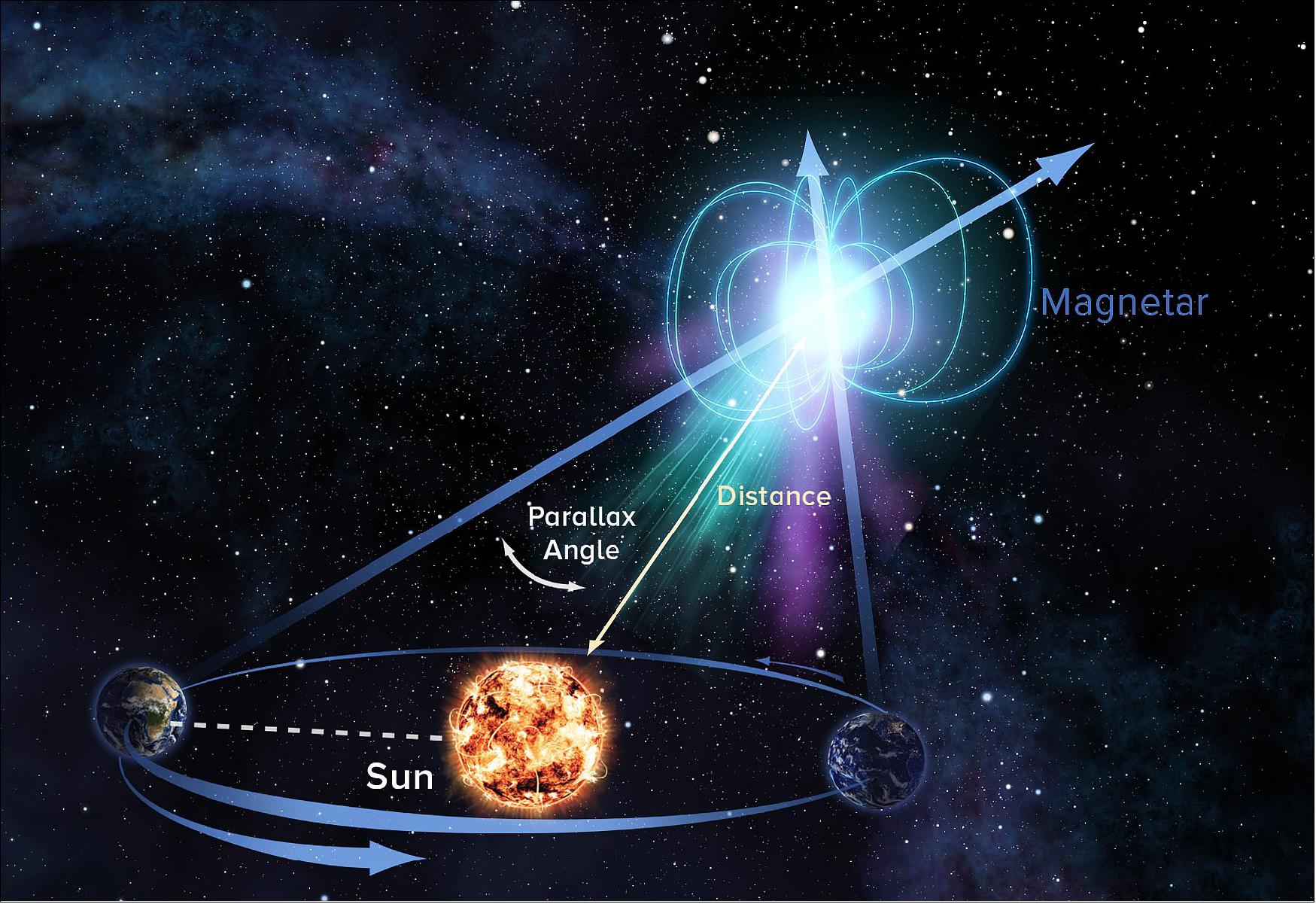
- “This is the first parallax measurement for a magnetar, and shows that it is among the closest magnetars known — at about 8100 light-years — making it a prime target for future study,” said Hao Ding, a graduate student at the Swinburne University of Technology in Australia.
- On April 28, a different magnetar, called SGR 1935+2154, emitted a brief radio burst that was the strongest ever recorded from within the Milky Way. While not as strong as FRBs coming from other galaxies, this burst suggested to astronomers that magnetars could generate FRBs.
- Fast radio bursts were first discovered in 2007. They are very energetic, and last at most a few milliseconds. Most have come from outside the Milky Way. Their origin remains unknown, but their characteristics have indicated that the extreme environment of a magnetar could generate them.
- “Having a precise distance to this magnetar means that we can accurately calculate the strength of the radio pulses coming from it. If it emits something similar to an FRB, we will know how strong that pulse is,” said Adam Deller, also of Swinburne University. “FRBs vary in their strength, so we would like to know if a magnetar pulse comes close or overlaps with the strength of known FRBs,” he added.
- “A key to answering this question will be to get more distances to magnetars, so we can expand our sample and obtain more data. The VLBA is the ideal tool for doing this,” said Walter Brisken, of the National Radio Astronomy Observatory.
- In addition, “We know that pulsars, such as the one in the famous Crab Nebula, emit ‘giant pulses,’ much stronger than their usual ones. Determining the distances to magnetars will help us understand this phenomenon, and learn if maybe FRBs are the most extreme example of giant pulses,” Ding said.
- The ultimate goal is to determine the exact mechanism that produces FRBs, the scientists said. 64)
• August 25, 2020: In this image, made with the National Science Foundation’s Very Long Baseline Array (VLBA), young, radio-emitting jets of material emerge from the core of an elliptical galaxy some 500 million light-years from Earth. After NASA’s Fermi Gamma-ray Space Telescope detected high-energy gamma rays coming from the object, scientists used the VLBA to make high-resolution images of the galaxy, dubbed TXS 0128+554. 65)
- This image (Figure 46) is a composite of six VLBA images made at observing frequencies ranging from 2.2 to 22.2 GHz. The broad lobes on either side of the bright core are the result of jet activity that began roughly 80 years ago. The gap between these lobes and the central region indicates, the scientists said, that the jet activity stopped sometime after that, then resumed about 10 years ago.
- ”These are among the youngest known jets in such systems, and only a handful are known to emit gamma-rays,” said Matthew Lister, of Purdue University.
- The bright edges of the lobes are where the ejected material, moving at about a third the speed of light, impacted material within the galaxy. The bright emitting areas total about 35 light-years across, and are at the core of the galaxy, where a supermassive black hole about one million times the mass of the Sun resides.
- Lister and his colleagues are reporting their findings in the Astrophysical Journal. 66)
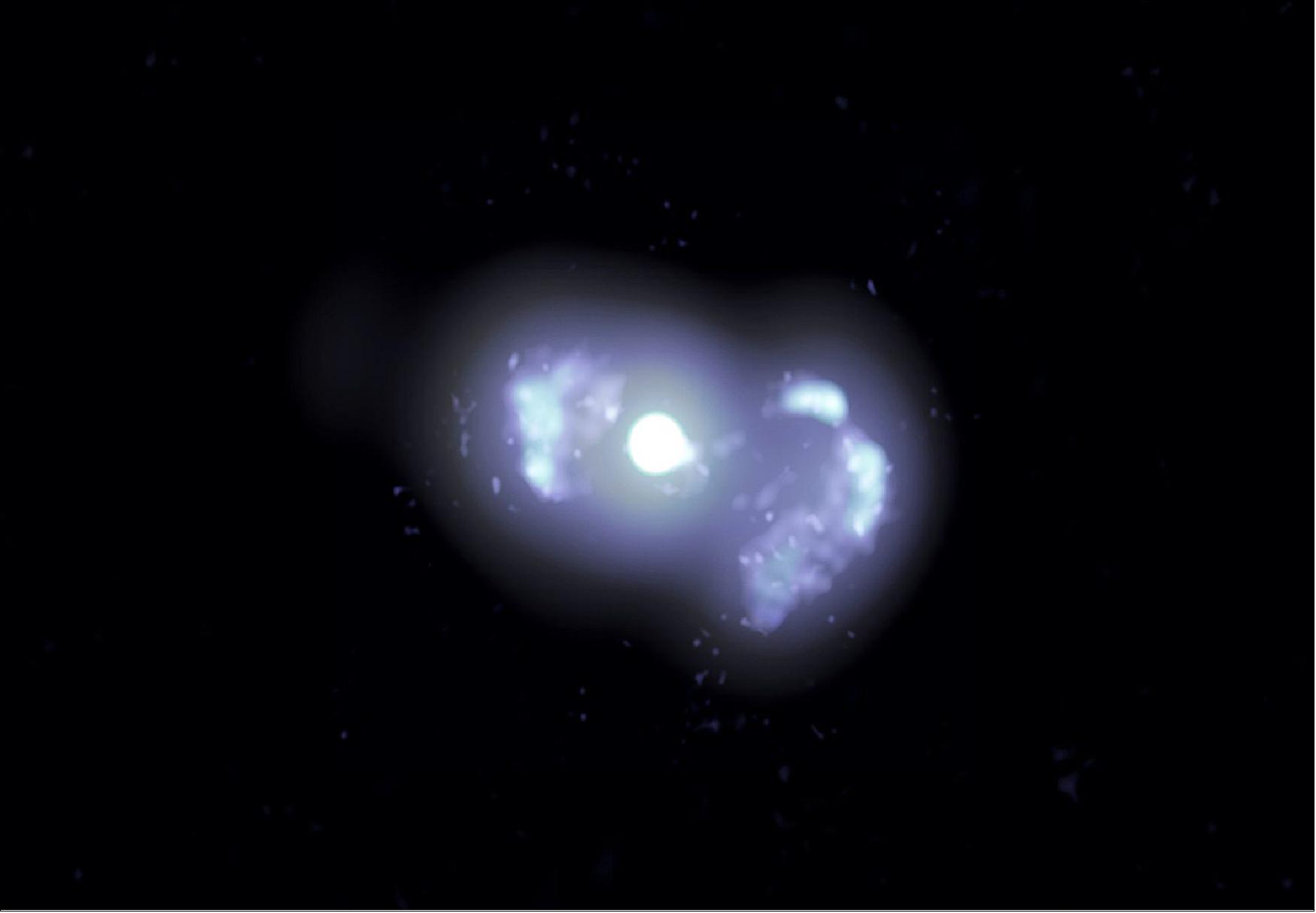

• August 4, 2020: Using the supersharp radio “vision” of the National Science Foundation’s continent-wide Very Long Baseline Array (VLBA), astronomers have discovered a Saturn-sized planet closely orbiting a small, cool star 35 light-years from Earth. This is the first discovery of an extrasolar planet with a radio telescope using a technique that requires extremely precise measurements of a star’s position in the sky, and only the second planet discovery for that technique and for radio telescopes. 67)
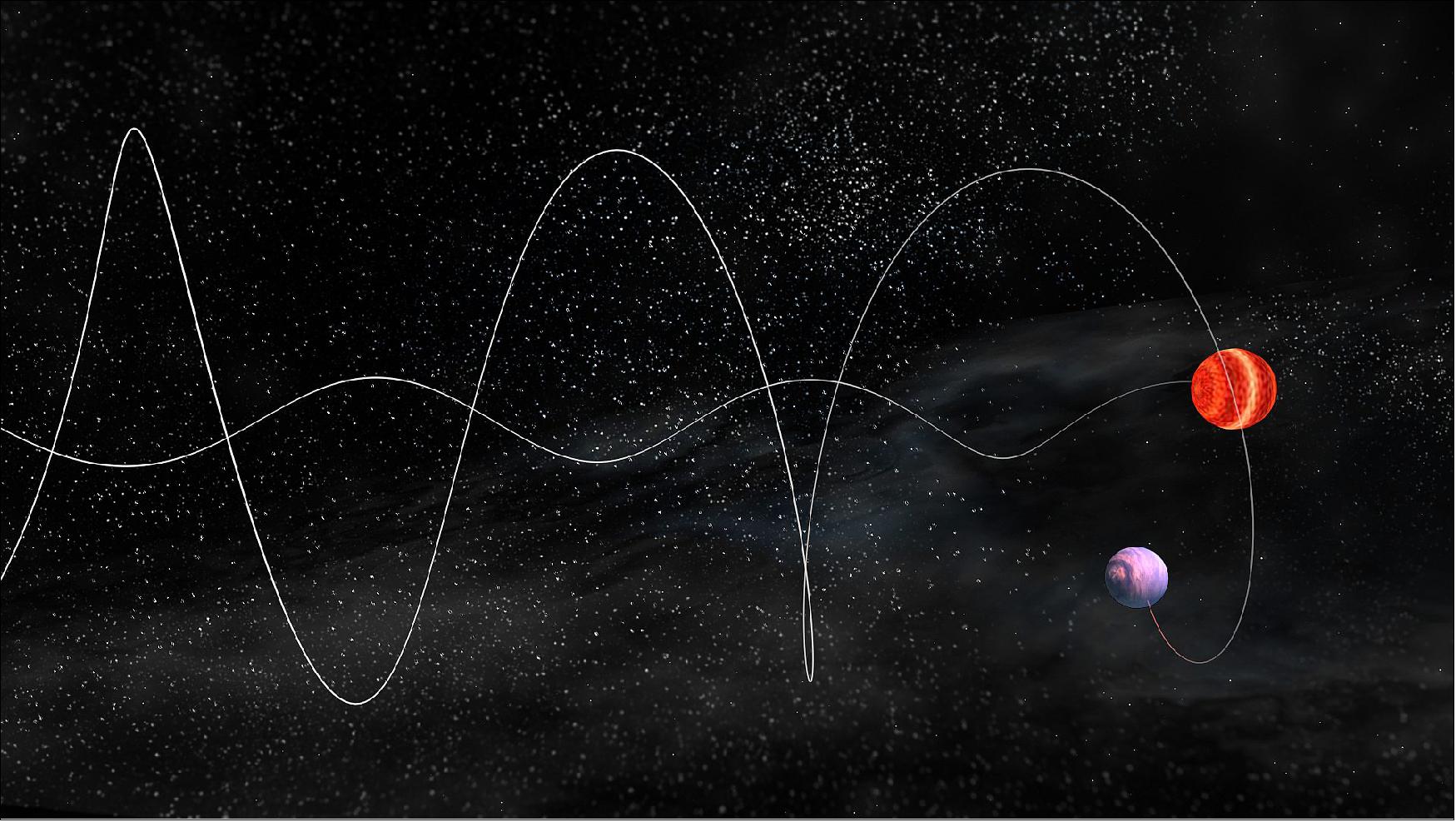
- The technique has long been known, but has proven difficult to use. It involves tracking the star’s actual motion in space, then detecting a minuscule “wobble” in that motion caused by the gravitational effect of the planet. The star and the planet orbit a location that represents the center of mass for both combined. The planet is revealed indirectly if that location, called the barycenter, is far enough from the star’s center to cause a wobble detectable by a telescope.
- This technique, called the astrometric technique, is expected to be particularly good for detecting Jupiter-like planets in orbits distant from the star. This is because when a massive planet orbits a star, the wobble produced in the star increases with a larger separation between the planet and the star, and at a given distance from the star, the more massive the planet, the larger the wobble produced.
- Starting in June of 2018 and continuing for a year and a half, the astronomers tracked a star called TVLM 513–46546, a cool dwarf with less than a tenth the mass of our Sun. In addition, they used data from nine previous VLBA observations of the star between March 2010 and August 2011.
- Extensive analysis of the data from those time periods revealed a telltale wobble in the star’s motion indicating the presence of a planet comparable in mass to Saturn, orbiting the star once every 221 days. This planet is closer to the star than Mercury is to the Sun.
- Small, cool stars like TVLM 513–46546 are the most numerous stellar type in our Milky Way Galaxy, and many of them have been found to have smaller planets, comparable to Earth and Mars.
- “Giant planets, like Jupiter and Saturn, are expected to be rare around small stars like this one, and the astrometric technique is best at finding Jupiter-like planets in wide orbits, so we were surprised to find a lower mass, Saturn-like planet in a relatively compact orbit. We expected to find a more massive planet, similar to Jupiter, in a wider orbit,” said Salvador Curiel, of the National Autonomous University of Mexico. “Detecting the orbital motions of this sub-Jupiter mass planetary companion in such a compact orbit was a great challenge,” he added.
- More than 4,200 planets have been discovered orbiting stars other than the Sun, but the planet around TVLM 513–46546 is only the second to be found using the astrometric technique. Another, very successful method, called the radial velocity technique, also relies on the gravitational effect of the planet upon the star. That technique detects the slight acceleration of the star, either toward or away from Earth, caused by the star’s motion around the barycenter.
- “Our method complements the radial velocity method which is more sensitive to planets orbiting in close orbits, while ours is more sensitive to massive planets in orbits further away from the star,” said Gisela Ortiz-Leon of the Max Planck Institute for Radio Astronomy in Germany. “Indeed, these other techniques have found only a few planets with characteristics such as planet mass, orbital size, and host star mass, similar to the planet we found. We believe that the VLBA, and the astrometry technique in general, could reveal many more similar planets.”
- A third technique, called the transit method, also very successful, detects the slight dimming of the star’s light when a planet passes in front of it, as seen from Earth.
- The astrometric method has been successful for detecting nearby binary star systems, and was recognized as early as the 19th Century as a potential means of discovering extrasolar planets. Over the years, a number of such discoveries were announced, then failed to survive further scrutiny. The difficulty has been that the stellar wobble produced by a planet is so small when seen from Earth that it requires extraordinary precision in the positional measurements.
- “The VLBA, with antennas separated by as much as 5,000 miles, provided us with the great resolving power and extremely high precision needed for this discovery,” said Amy Mioduszewski, of the National Radio Astronomy Observatory. “In addition, improvements that have been made to the VLBA’s sensitivity gave us the data quality that made it possible to do this work now,” she added.
- Curiel, Ortiz-Leon, Mioduszewski, and Rosa Torres of the University of Guadalajara in Mexico, reported their findings in the Astronomical Journal. 68)
• June 16, 2020: An international team of astronomers has created the most detailed map yet of the atmosphere of the red supergiant star Antares. The unprecedented sensitivity and resolution of both the Atacama Large Millimeter/submillimeter Array (ALMA) and the National Science Foundation’s Karl G. Jansky Very Large Array (VLA) revealed the size and temperature of Antares’ atmosphere from just above the star’s surface, throughout its chromosphere, and all the way out to the wind region. 69)
- Red supergiant stars, like Antares and its more well-known cousin Betelgeuse, are huge, relatively cold stars at the end of their lifetime. They are on their way to run out of fuel, collapse, and become supernovae. Through their vast stellar winds, they launch heavy elements into space, thereby playing an important role in providing the essential building blocks for life in the universe. But it is a mystery how these enormous winds are launched. A detailed study of the atmosphere of Antares, the closest supergiant star to Earth, provides a crucial step towards an answer.
- The ALMA and VLA map of Antares is the most detailed radio map yet of any star, other than the Sun. ALMA observed Antares close to its surface (its optical photosphere) in shorter wavelengths, and the longer wavelengths observed by the VLA revealed the star’s atmosphere further out. As seen in visible light, Antares’ diameter is approximately 700 times larger than the Sun. But when ALMA and the VLA revealed its atmosphere in radio light, the supergiant turned out to be even more gigantic.
- “The size of a star can vary dramatically depending on what wavelength of light it is observed with,” explained Eamon O’Gorman of the Dublin Institute for Advanced Studies in Ireland and lead author of the study published in the June 16 edition of the journal Astronomy & Astrophysics. “The longer wavelengths of the VLA revealed the supergiant’s atmosphere out to nearly 12 times the star’s radius.”
- The radio telescopes measured the temperature of most of the gas and plasma in Antares’ atmosphere. Most noticeable was the temperature in the chromosphere. This is the region above the star’s surface that is heated up by magnetic fields and shock waves created by the vigorous roiling convection at the stellar surface – much like the bubbling motion in a pot of boiling water. Not much is known about chromospheres, and this is the first time that this region has been detected in radio waves.
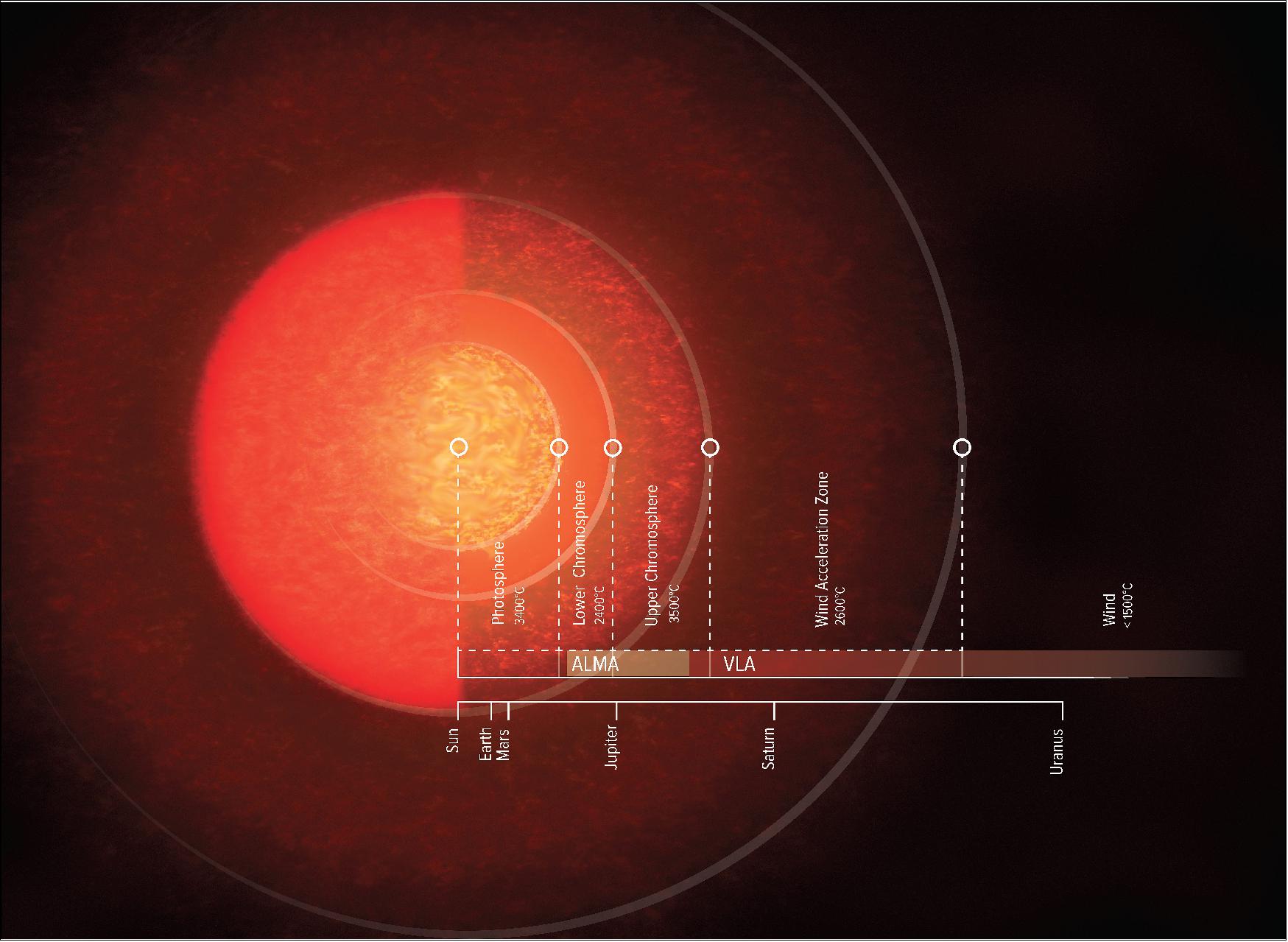
- Thanks to ALMA and the VLA, the scientists discovered that the star’s chromosphere extends out to 2.5 times the star’s radius (our Sun’s chromosphere is only 1/200th of its radius). They also found that the temperature of the chromosphere is lower than previous optical and ultraviolet observations have suggested. The temperature peaks at 3,500 degrees Celsius (6,400 degrees Fahrenheit), after which it gradually decreases. As a comparison, the Sun’s chromosphere reaches temperatures of almost 20,000 degrees Celsius.
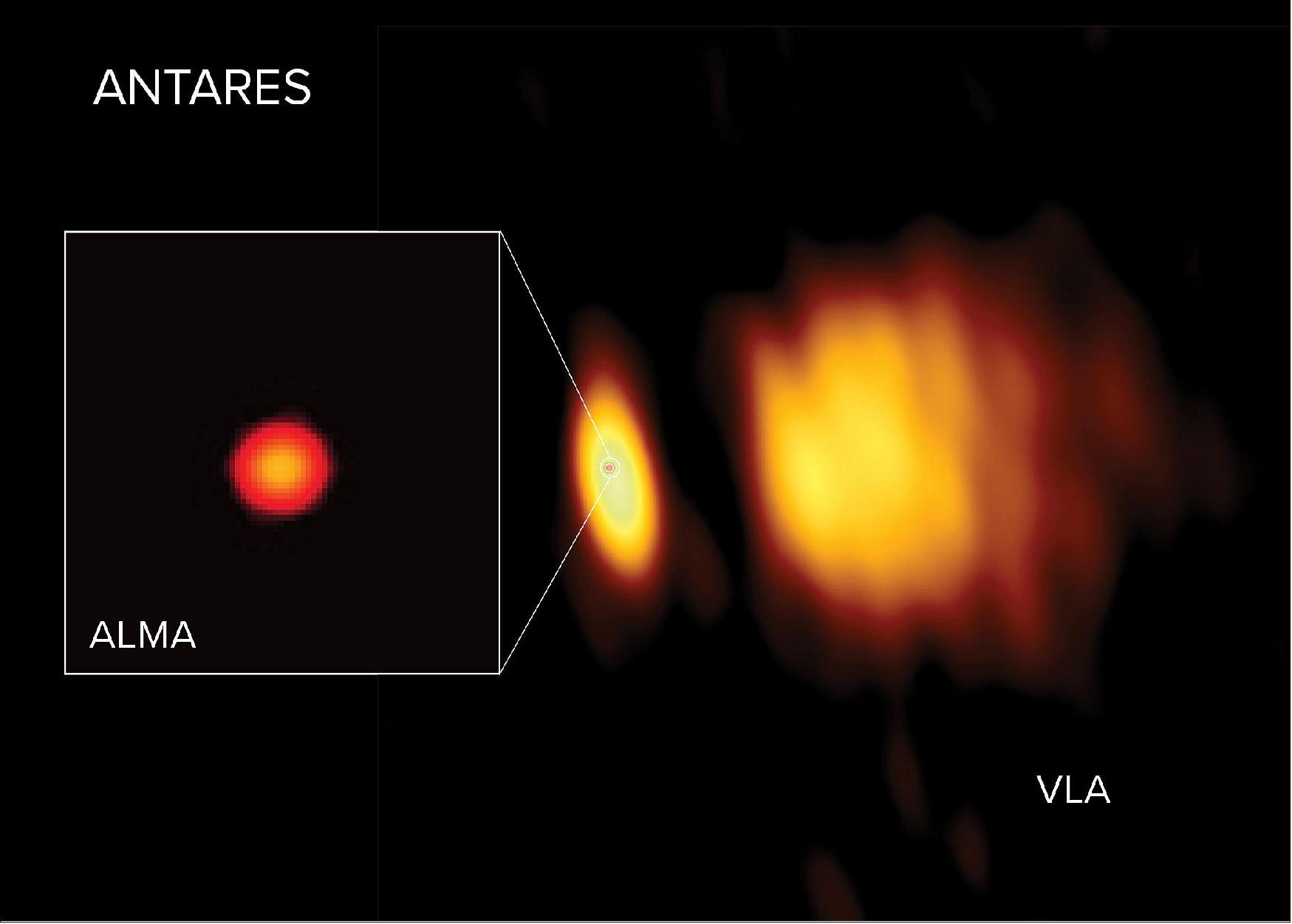
- “We found that the chromosphere is ‘lukewarm’ rather than hot, in stellar temperatures,” said O’Gorman. “The difference can be explained because our radio measurements are a sensitive thermometer for most of the gas and plasma in the star’s atmosphere, whereas past optical and ultraviolet observations were only sensitive to very hot gas and plasma.”
- “We think that red supergiant stars, such as Antares and Betelgeuse, have an inhomogeneous atmosphere,” said co-author Keiichi Ohnaka of the Universidad Católica del Norte in Chile who previously observed Antares’ atmosphere in infrared light. “Imagine that their atmospheres are a painting made out of many dots of different colors, representing different temperatures. Most of the painting contains dots of the lukewarm gas that radio telescopes can see, but there are also cold dots that only infrared telescopes can see, and hot dots that UV telescopes see. At the moment we can’t observe these dots individually, but we want to try that in future studies.”
- In the ALMA and VLA data, astronomers for the first time saw a clear distinction between the chromosphere and the region where winds start to form. In the VLA image, a huge wind is visible, ejected from Antares and lit up by its smaller but hotter companion star Antares B.
- “When I was a student, I dreamt of having data like this,” said co-author Graham Harper of the University of Colorado, Boulder. “Knowing the actual sizes and temperatures of the atmospheric zones gives us a clue of how these huge winds start to form and how much mass is being ejected.”
- “Our innate understanding of the night sky is that stars are just points of light. The fact we can map the atmospheres of these supergiant stars in detail, is a true testament to technological advances in interferometry. These tour de force observations bring the universe close, right into our own backyard,” said Chris Carilli of the National Radio Astronomy Observatory, who was involved in the first observations of Betelgeuse at multiple radio wavelengths with the VLA in 1998. 70)
• June 11, 2020: A new set of precision distance measurements made with an international collection of radio telescopes have greatly increased the likelihood that theorists need to revise the “standard model” that describes the fundamental nature of the Universe. 71)
- The new distance measurements allowed astronomers to refine their calculation of the Hubble Constant, the expansion rate of the Universe, a value important for testing the theoretical model describing the composition and evolution of the Universe. The problem is that the new measurements exacerbate a discrepancy between previously measured values of the Hubble Constant and the value predicted by the model when applied to measurements of the cosmic microwave background made by the Planck satellite.
- “We find that galaxies are nearer than predicted by the standard model of cosmology, corroborating a problem identified in other types of distance measurements. There has been debate over whether this problem lies in the model itself or in the measurements used to test it. Our work uses a distance measurement technique completely independent of all others, and we reinforce the disparity between measured and predicted values. It is likely that the basic cosmological model involved in the predictions is the problem,” said James Braatz, of the National Radio Astronomy Observatory (NRAO).
- Braatz leads the Megamaser Cosmology Project, an international effort to measure the Hubble Constant by finding galaxies with specific properties that lend themselves to yielding precise geometric distances. The project has used the National Science Foundation’s Very Long Baseline Array (VLBA), Karl G. Jansky Very Large Array (VLA), and Robert C. Byrd Green Bank Telescope (GBT), along with the Effelsberg telescope in Germany. The team reported their latest results in the Astrophysical Journal Letters. 72)
- Edwin Hubble, after whom the orbiting Hubble Space Telescope is named, first calculated the expansion rate of the universe (the Hubble Constant) in 1929 by measuring the distances to galaxies and their recession speeds. The more distant a galaxy is, the greater its recession speed from Earth. Today, the Hubble Constant remains a fundamental property of observational cosmology and a focus of many modern studies.
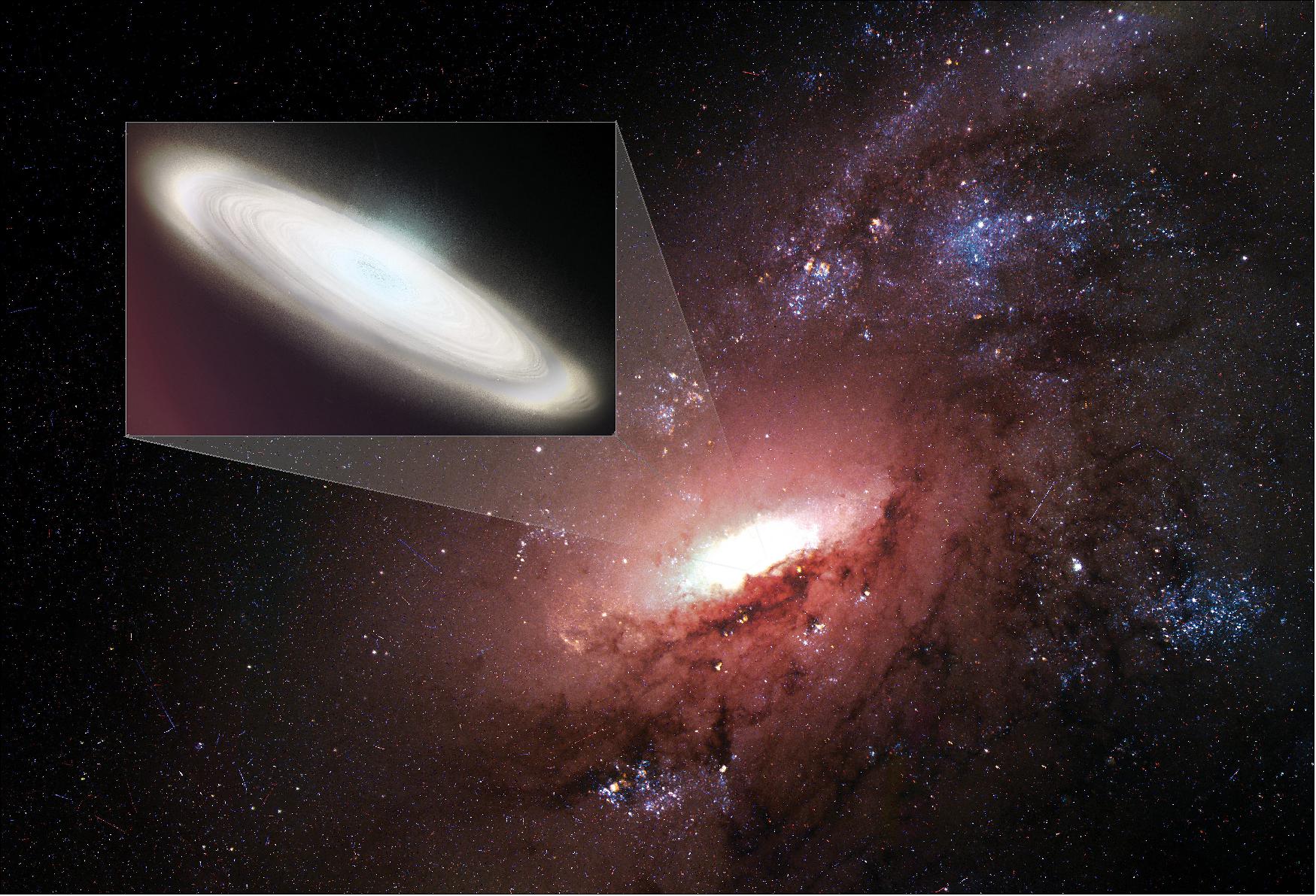
- Measuring recession speeds of galaxies is relatively straightforward. Determining cosmic distances, however, has been a difficult task for astronomers. For objects in our own Milky Way Galaxy, astronomers can get distances by measuring the apparent shift in the object’s position when viewed from opposite sides of Earth’s orbit around the Sun, an effect called parallax. The first such measurement of a star’s parallax distance came in 1838.
- Beyond our own Galaxy, parallaxes are too small to measure, so astronomers have relied on objects called “standard candles,” so named because their intrinsic brightness is presumed to be known. The distance to an object of known brightness can be calculated based on how dim the object appears from Earth. These standard candles include a class of stars called Cepheid variables and a specific type of stellar explosion called a Type Ia supernova.
- Another method of estimating the expansion rate involves observing distant quasars whose light is bent by the gravitational effect of a foreground galaxy into multiple images. When the quasar varies in brightness, the change appears in the different images at different times. Measuring this time difference, along with calculations of the geometry of the light-bending, yields an estimate of the expansion rate.
- Determinations of the Hubble Constant based on the standard candles and the gravitationally-lensed quasars have produced figures of 73-74 kilometers per second (the speed) per megaparsec (distance in units favored by astronomers).
- However, predictions of the Hubble Constant from the standard cosmological model when applied to measurements of the cosmic microwave background (CMB) — the leftover radiation from the Big Bang — produce a value of 67.4, a significant and troubling difference. This difference, which astronomers say is beyond the experimental errors in the observations, has serious implications for the standard model.
- The model is called Lambda Cold Dark Matter, or Lambda CDM, where “Lambda” refers to Einstein’s cosmological constant and is a representation of dark energy. The model divides the composition of the Universe mainly between ordinary matter, dark matter, and dark energy, and describes how the Universe has evolved since the Big Bang.
- The Megamaser Cosmology Project focuses on galaxies with disks of water-bearing molecular gas orbiting supermassive black holes at the galaxies’ centers. If the orbiting disk is seen nearly edge-on from Earth, bright spots of radio emission, called masers — radio analogs to visible-light lasers — can be used to determine both the physical size of the disk and its angular extent, and therefore, through geometry, its distance. The project’s team uses the worldwide collection of radio telescopes to make the precision measurements required for this technique.
- In their latest work, the team refined their distance measurements to four galaxies, at distances ranging from 168 million light-years to 431 million light-years. Combined with previous distance measurements of two other galaxies, their calculations produced a value for the Hubble Constant of 73.9 kilometers per second per megaparsec.
- “Testing the standard model of cosmology is a really challenging problem that requires the best-ever measurements of the Hubble Constant. The discrepancy between the predicted and measured values of the Hubble Constant points to one of the most fundamental problems in all of physics, so we would like to have multiple, independent measurements that corroborate the problem and test the model. Our method is geometric, and completely independent of all others, and it reinforces the discrepancy,” said Dom Pesce, a researcher at the Center for Astrophysics | Harvard and Smithsonian, and lead author on the latest paper.
- “The maser method of measuring the expansion rate of the universe is elegant, and, unlike the others, based on geometry. By measuring extremely precise positions and dynamics of maser spots in the accretion disk surrounding a distant black hole, we can determine the distance to the host galaxies and then the expansion rate. Our result from this unique technique strengthens the case for a key problem in observational cosmology.” said Mark Reid of the Center for Astrophysics | Harvard and Smithsonian, and a member of the Megamaser Cosmology Project team.
- “Our measurement of the Hubble Constant is very close to other recent measurements, and statistically very different from the predictions based on the CMB and the standard cosmological model. All indications are that the standard model needs revision,” said Braatz.
- Astronomers have various ways to adjust the model to resolve the discrepancy. Some of these include changing presumptions about the nature of dark energy, moving away from Einstein’s cosmological constant. Others look at fundamental changes in particle physics, such as changing the numbers or types of neutrinos or the possibilities of interactions among them. There are other possibilities, even more exotic, and at the moment scientists have no clear evidence for discriminating among them.
- “This is a classic case of the interplay between observation and theory. The Lambda CDM model has worked quite well for years, but now observations clearly are pointing to a problem that needs to be solved, and it appears the problem lies with the model,” Pesce said.
• September 16, 2019: Astronomers using the GBT have discovered the most massive neutron star to date, a rapidly spinning pulsar approximately 4,600 light-years from Earth. This record-breaking object is teetering on the edge of existence, approaching the theoretical maximum mass possible for a neutron star. 73)
- Neutron stars – the compressed remains of massive stars gone supernova – are the densest “normal” objects in the known universe. (Black holes are technically denser, but far from normal.) Just a single sugar-cube worth of neutron-star material would weigh 100 million tons here on Earth, or about the same as the entire human population. Though astronomers and physicists have studied and marveled at these objects for decades, many mysteries remain about the nature of their interiors: Do crushed neutrons become “superfluid” and flow freely? Do they breakdown into a soup of subatomic quarks or other exotic particles? What is the tipping point when gravity wins out over matter and forms a black hole?
- A team of astronomers using the National Science Foundation’s (NSF) Green Bank Telescope (GBT) has brought us closer to finding the answers.
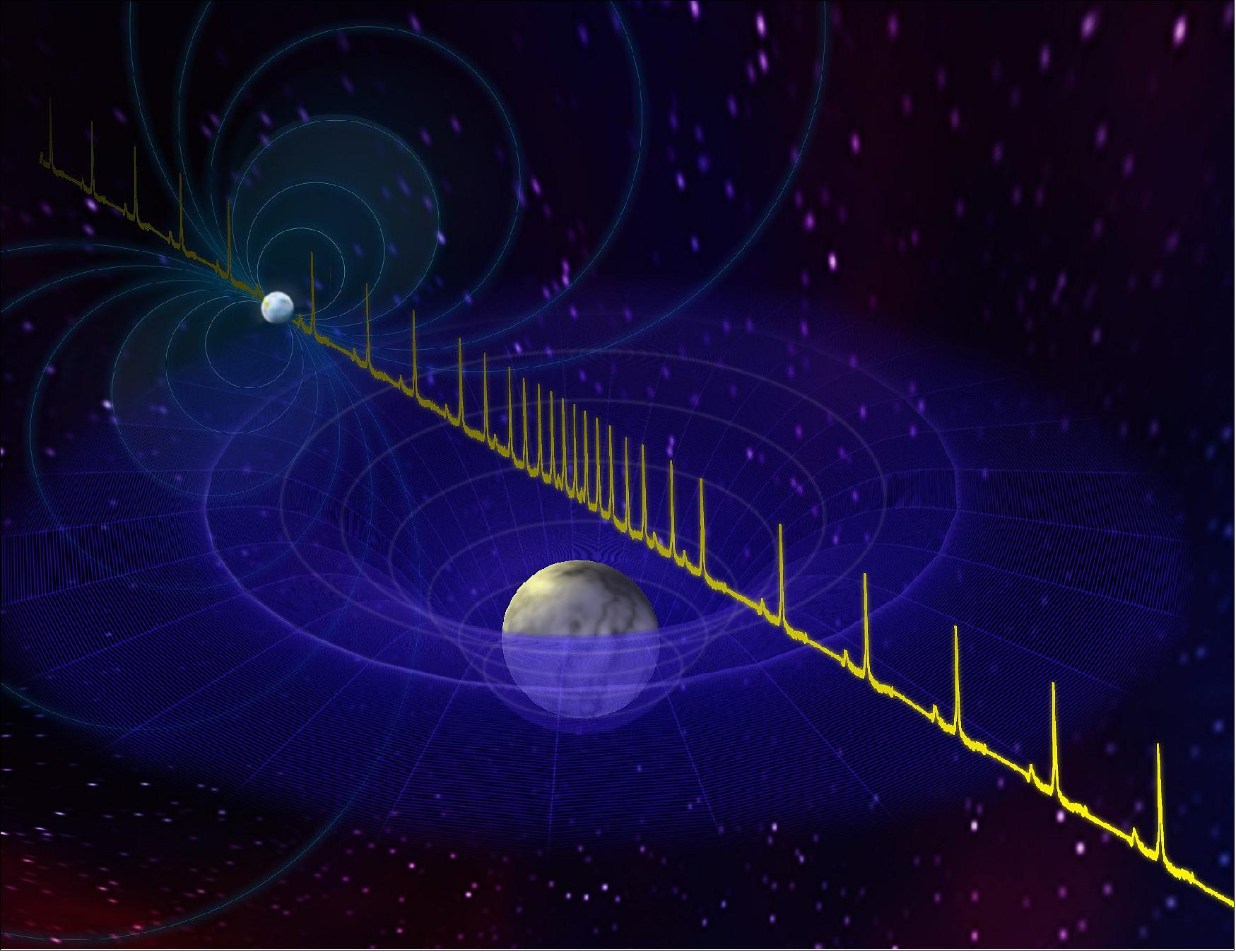
- The researchers, members of the NANOGrav Physics Frontiers Center, discovered that a rapidly rotating millisecond pulsar, called J0740+6620, is the most massive neutron star ever measured, packing 2.17 times the mass of our Sun into a sphere only 30 kilometers across. This measurement approaches the limits of how massive and compact a single object can become without crushing itself down into a black hole. Recent work involving gravitational waves observed from colliding neutron stars by LIGO suggests that 2.17 solar masses might be very near that limit.
- “Neutron stars are as mysterious as they are fascinating,” said Thankful Cromartie, a graduate student at the University of Virginia and Grote Reber doctoral fellow at the National Radio Astronomy Observatory in Charlottesville, Virginia. “These city-sized objects are essentially ginormous atomic nuclei. They are so massive that their interiors take on weird properties. Finding the maximum mass that physics and nature will allow can teach us a great deal about this otherwise inaccessible realm in astrophysics.”
- Pulsars get their name because of the twin beams of radio waves they emit from their magnetic poles. These beams sweep across space in a lighthouse-like fashion. Some rotate hundreds of times each second. Since pulsars spin with such phenomenal speed and regularity, astronomers can use them as the cosmic equivalent of atomic clocks. Such precise timekeeping helps astronomers study the nature of spacetime, measure the masses of stellar objects, and improve their understanding of general relativity.
- In the case of this binary system, which is nearly edge-on in relation to Earth, this cosmic precision provided a pathway for astronomers to calculate the mass of the two stars.
- As the ticking pulsar passes behind its white dwarf companion, there is a subtle (on the order of 10 millionths of a second) delay in the arrival time of the signals. This phenomenon is known as “Shapiro Delay.” In essence, gravity from the white dwarf star slightly warps the space surrounding it, in accordance with Einstein’s general theory of relativity. This warping means the pulses from the rotating neutron star have to travel just a little bit farther as they wend their way around the distortions of spacetime caused by the white dwarf.
- Astronomers can use the amount of that delay to calculate the mass of the white dwarf. Once the mass of one of the co-orbiting bodies is known, it is a relatively straightforward process to accurately determine the mass of the other.
- Cromartie is the principal author on a paper accepted for publication in Nature Astronomy. 74) The GBT observations were research related to her doctoral thesis, which proposed observing this system at two special points in their mutual orbits to accurately calculate the mass of the neutron star.
- “The orientation of this binary star system created a fantastic cosmic laboratory,” said Scott Ransom, an astronomer at NRAO and coauthor on the paper. “Neutron stars have this tipping point where their interior densities get so extreme that the force of gravity overwhelms even the ability of neutrons to resist further collapse. Each “most massive” neutron star we find brings us closer to identifying that tipping point and helping us to understand the physics of matter at these mindboggling densities.”
- These observations were also part of a larger observing campaign known as NANOGrav, short for the North American Nanohertz Observatory for Gravitational Waves, which is a Physics Frontiers Center funded by the NSF.
• April 2, 2019: Astronomers used the National Science Foundation’s Karl G. Jansky Very Large Array (VLA) to make the first direct image of a dusty, doughnut-shaped feature surrounding the supermassive black hole at the core of one of the most powerful radio galaxies in the Universe — a feature first postulated by theorists nearly four decades ago as an essential part of such objects. 75)
- The scientists studied Cygnus A, a galaxy some 760 million light-years from Earth. The galaxy harbors a black hole at its core that is 2.5 billion times more massive than the Sun. As the black hole’s powerful gravitational pull draws in surrounding material, it also propels superfast jets of material traveling outward at nearly the speed of light, producing spectacular “lobes” of bright radio emission.
- Black hole-powered “central engines” producing bright emission at various wavelengths, and jets extending far beyond the galaxy are common to many galaxies, but show different properties when observed. Those differences led to a variety of names, such as quasars, blazars, or Seyfert galaxies. To explain the differences, theorists constructed a “unified model” with a common set of features that would show different properties depending on the angle from which they are viewed.
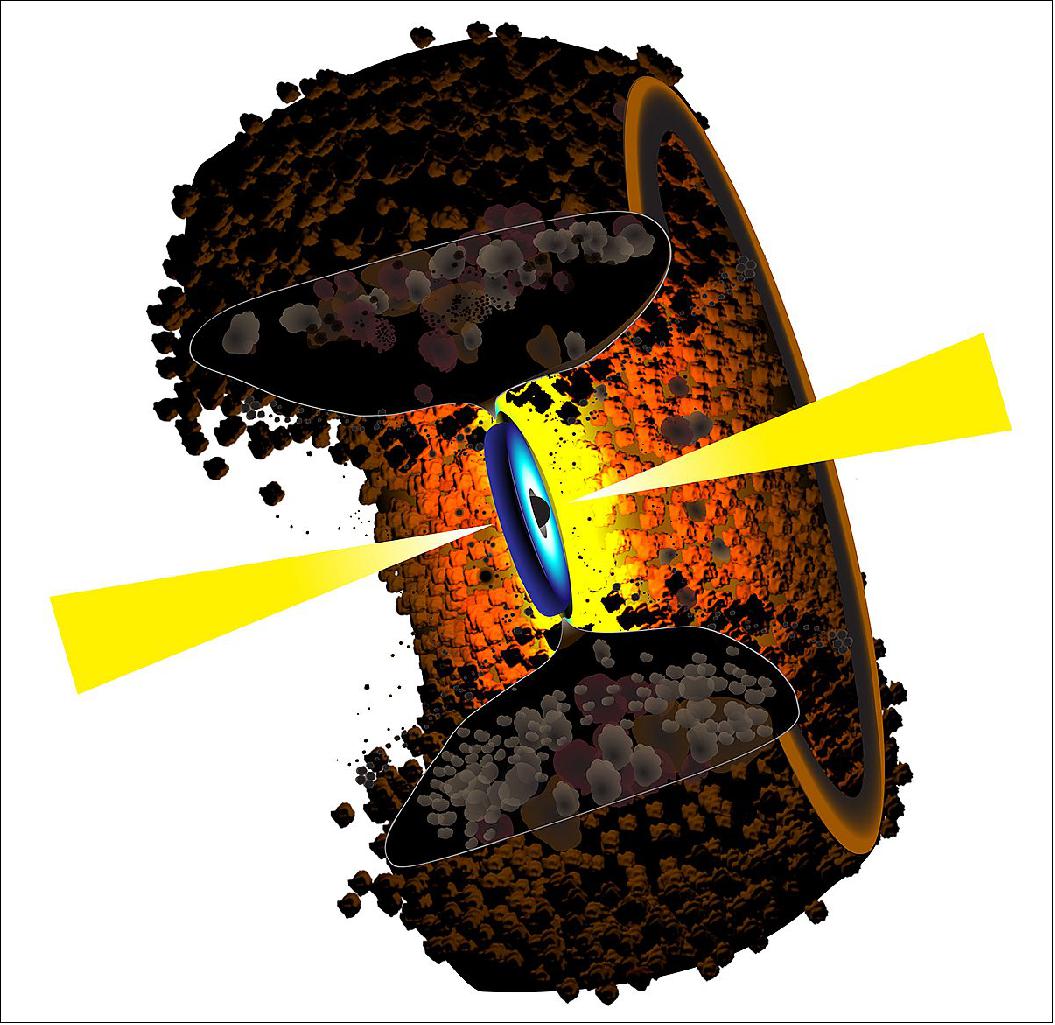
- The unified model includes the central black hole, a rotating disk of infalling material surrounding the black hole, and the jets speeding outward from the poles of the disk. In addition, to explain why the same type of object looks different when viewed from different angles, a thick, dusty, doughnut-shaped “torus” is included, surrounding the inner parts. The torus obscures some features when viewed from the side, leading to apparent differences to the observer, even for intrinsically similar objects. Astronomers generically call this common set of features an active galactic nucleus (AGN).
- “The torus is an essential part of the AGN phenomenon, and evidence exists for such structures in nearby AGN of lower luminosity, but we’ve never before directly seen one in such a brightly-emitting radio galaxy,” said Chris Carilli, of the National Radio Astronomy Observatory (NRAO). “The torus helps explain why objects known by different names actually are the same thing, just observed from a different perspective,” he added.
- In the 1950s, astronomers discovered objects that strongly emitted radio waves, but appeared point-like, similar to distant stars, when later observed with visible-light telescopes. In 1963, Maarten Schmidt of Caltech discovered that one of these objects was extremely distant, and more such discoveries quickly followed. To explain how these objects, dubbed quasars, could be so bright, theorists suggested that they must be tapping the tremendous gravitational energy of supermassive black holes. The combination of black hole, the rotating disk, called an accretion disk, and the jets was termed the “central engine” responsible for the objects’ prolific outpourings of energy.
- The same type of central engine also appeared to explain the output of other types of objects, including radio galaxies, blazars, and Seyfert Galaxies. However, each showed a different set of properties. Theorists worked to develop a “unification scheme” to explain how the same thing could appear differently. In 1977, obscuration by dust was suggested as one element of that scheme. In a 1982 paper, Robert Antonucci, of the University of California, Santa Barbara, presented a drawing of an opaque torus — a doughnut-shaped object — surrounding the central engine. From that point on, an obscuring torus has been a common feature of astronomers’ unified view of all types of active galactic nuclei.
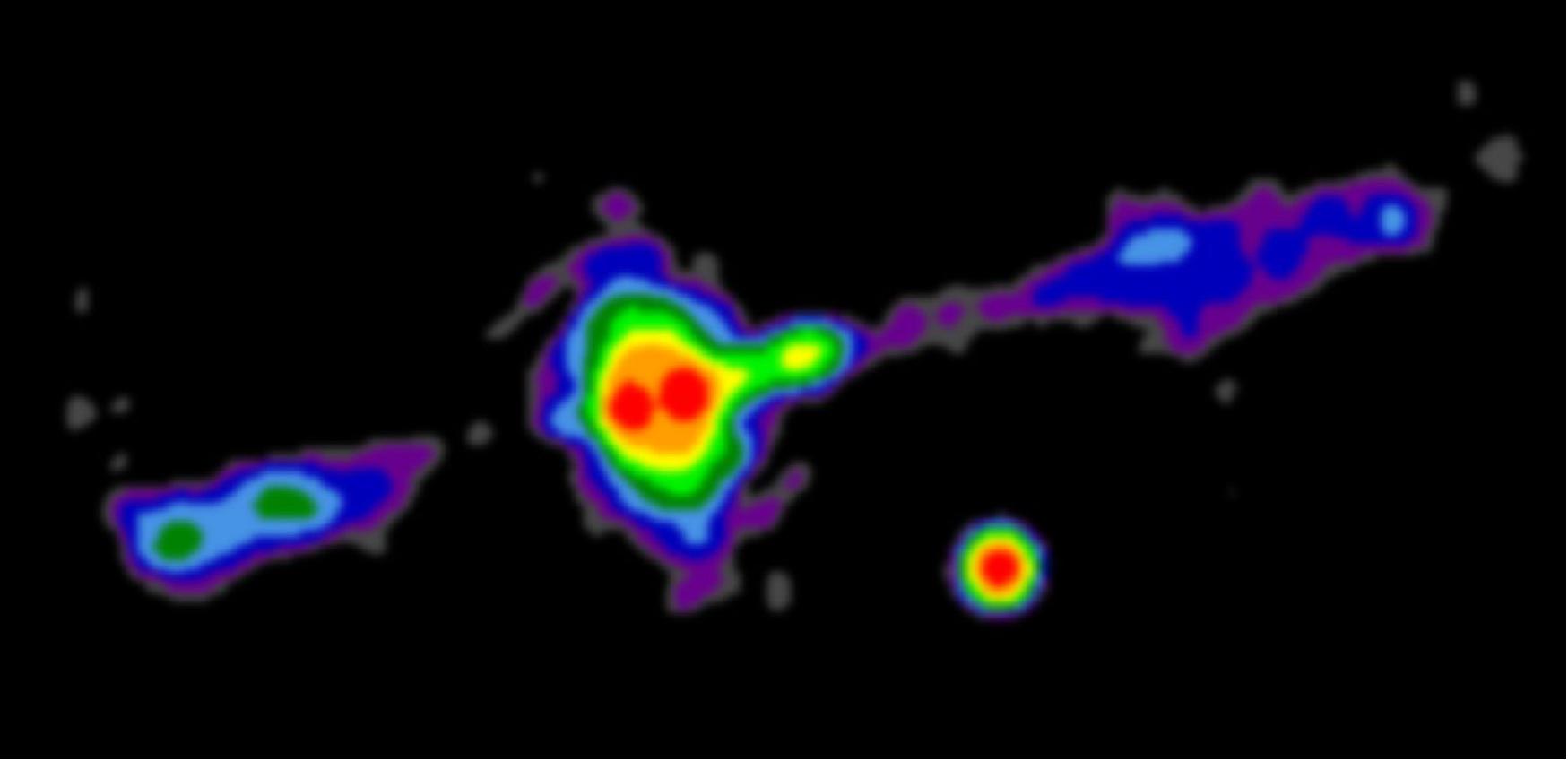
- “Cygnus A is the closest example of a powerful radio-emitting galaxy — 10 times closer than any other with comparably powerful radio emission. That proximity allowed us to find the torus in a high-resolution VLA image of the galaxy’s core,” said Rick Perley, also of NRAO. “Doing more work of this type on weaker and more distant objects will almost certainly need the order-of-magnitude improvement in sensitivity and resolution that the proposed Next Generation Very Large Array (ngVLA) would bring,” he added.
- The VLA observations directly revealed the gas in Cygnus A’s torus, which has a radius of nearly 900 light-years. Longstanding models for the torus suggest that the dust is in clouds embedded in the somewhat-clumpy gas.
- “It’s really great to finally see direct evidence of something that we’ve long presumed should be there,” Carilli said. “To more accurately determine the shape and composition of this torus, we need to do further observing. For example, the Atacama Large Millimeter/submillimeter Array (ALMA) can observe at the wavelengths that will directly reveal the dust,” he added.
- Carilli and Perley, with their colleagues Vivek Dhawan, also of NRAO, and Daniel Perley of Liverpool John Moores University in the UK, discovered the torus when following up their surprising discovery in 2016 of a new, bright object near the center of Cygnus A. That new object, they said, is most likely a second supermassive black hole that only recently encountered new material it could devour, causing it to produce bright emission the same way the central black hole does. The existence of the second black hole, they said, suggests that Cygnus A merged with another galaxy in the astronomically recent past.
- Cygnus A, so named because it is the most powerful radio-emitting object in the constellation Cygnus, was discovered in 1946 by English physicist and radio astronomer J.S. Hey. It was matched to a visible-light, giant galaxy by Walter Baade and Rudolf Minkowski in 1951. It became an early target for the VLA soon after its completion in the early 1980s. Detailed VLA images of Cygnus A published in 1984 produced major advances in astronomers’ understanding of such galaxies.
- The scientists are reporting their findings in the Astrophysical Journal Letters. 76)
• December 20, 2018: As comet 46P/Wirtanen neared Earth on December 2, astronomers using the Atacama Large Millimeter/submillimeter Array (ALMA) took a remarkably close look the innermost regions of the comet’s coma, the gaseous envelope around its nucleus. 77)
- ALMA imaged the comet when it was approximately 16.5 million kilometers from Earth. At its closet on December 16, the comet – one of the brightest in years — was approximately 11.6 million kilometers from Earth, or about 30 times the distance from the Earth to the moon.
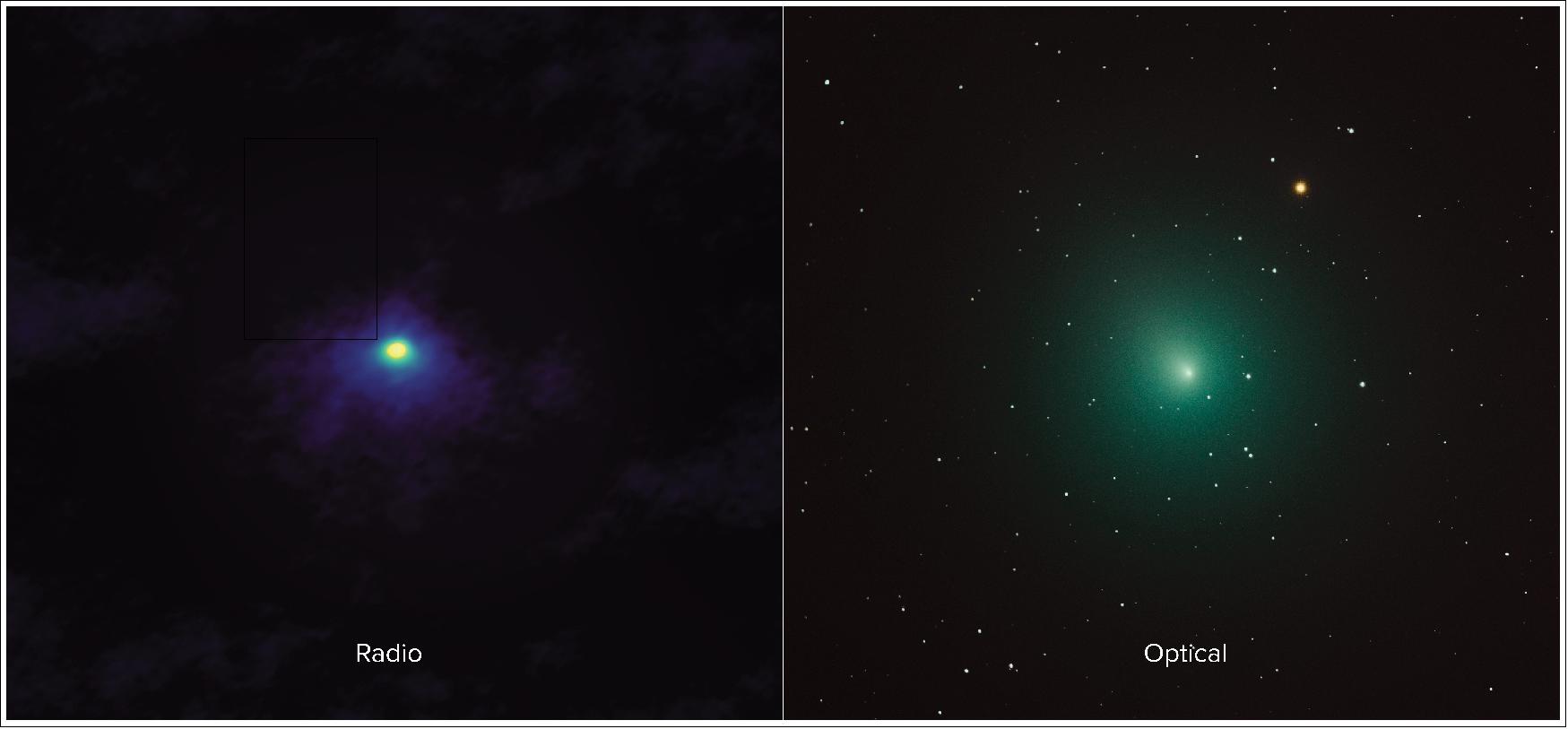
- “This comet is causing a stir in the professional and amateur astronomy communities due to its combined brightness and proximity, which allows us to study it in unprecedented detail” said NASA’s Martin Cordiner, who led the team that made the ALMA observations. “As the comet drew nearer to the Sun, its icy body heated up, releasing water vapor and various other particles stored inside, forming the characteristic puffed-up coma and elongated tail.”
- The ALMA image of comet 46P/Wirtanen zooms-in to very near its nucleus – the solid “dirty snowball” of the comet itself — to image the natural millimeter-wavelength “glow” emitted by molecules of hydrogen cyanide (HCN), a simple organic molecule that forms an ethereal atmosphere around the comet. ALMA, using its remarkable ability to see fine details, was able to detect and image the fine-scale distribution of this particular molecule.
- The HCN image shows a compact region of gas and an extended, diffuse, and somewhat asymmetrical, pattern in the inner portion of the coma. Due to the extreme proximity of this comet, most of the extended coma is resolved out, so these observations are only sensitive to the innermost regions, in the immediate vicinity of the nucleus.
- The astronomers also performed observations of more complex molecules on Dec 9, when the comet was 13.6 million kilometers from Earth.
- Comet 46P/Wirtanen orbits the Sun once every five-and-a-half years, which is remarkably brisk compared to its more famous cousin Halley’s Comet, which has an orbital period of about 75 years. Other bright comets can have periods that are on the order of hundreds and even thousands of years. The comet may yet be visible to the naked eye.
- For comparison, an optical view of the comet taken by an amateur astrophotographer is shown. Though they appear to be similar, the ALMA image spans an area of the sky only about 5 arcseconds – about 1000 times smaller than the optical image – meaning ALMA is looking at the very fine-scale features in the coma.
- This and previous observations of comets with ALMA confirm that they are rich in organic molecules, and may therefore have seeded the early Earth with the chemical building blocks of life.
• August 17, 2018: A team of scientists using the highest-frequency capabilities of the Atacama Large Millimeter/submillimeter Array (ALMA) has uncovered jets of warm water vapor streaming away from a newly forming star. The researchers also detected the “fingerprints” of an astonishing assortment of molecules near this stellar nursery. 78)
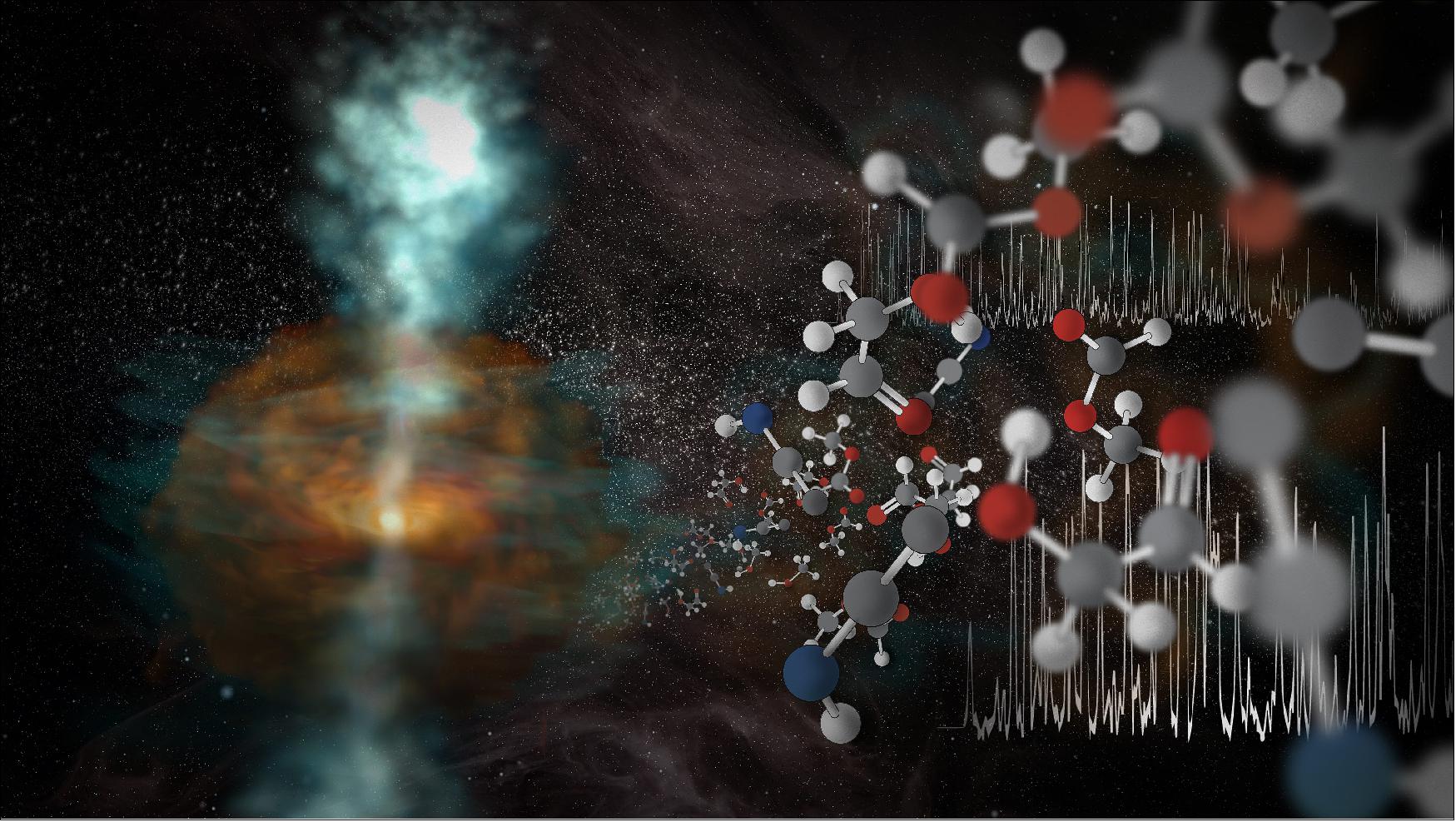
- The ALMA telescope in Chile has transformed how we see the universe, showing us otherwise invisible parts of the cosmos. This array of incredibly precise antennas studies a comparatively high-frequency sliver of radio light: waves that range from a few tenths of a millimeter to several millimeters in length. Recently, scientists pushed ALMA to its limits, harnessing the array’s highest-frequency (shortest wavelength) capabilities, which peer into a part of the electromagnetic spectrum that straddles the line between infrared light and radio waves.
![Figure 57: Pictured here is one of the cold cartridge assemblies of the Band 10 receiver, which gives ALMA its highest-frequency capabilities [image credit: ALMA (ESO/NAOJ/NRAO)]](https://www.eoportal.org/ftp/satellite-missions/n/NRAO_270622/NRAO_AutoE.jpeg)
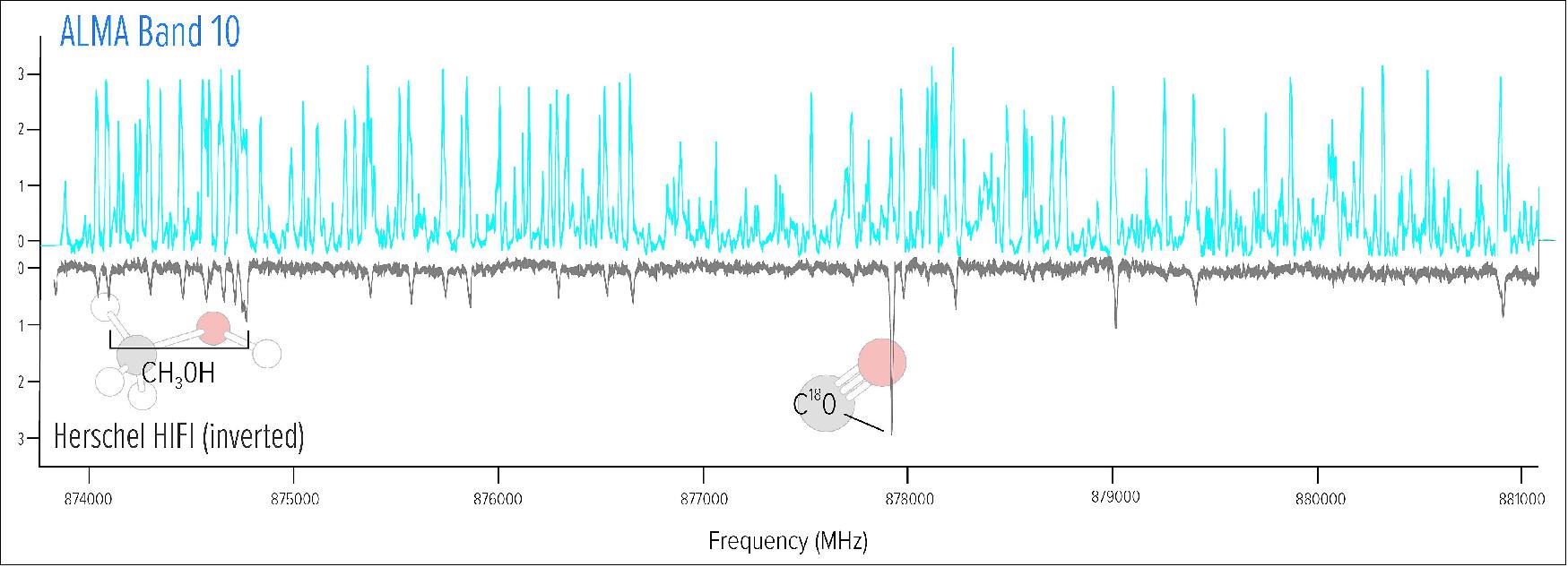
- Under ideal atmospheric conditions, which occurred on the evening of 5 April 2018, astronomers trained ALMA’s highest-frequency, submillimeter vision on a curious region of the Cat’s Paw Nebula (also known as NGC 6334I), a star-forming complex located about 4,300 light-years from Earth in the direction of the southern constellation Scorpius.
- Previous ALMA observations of this region at lower frequencies uncovered turbulent star formation, a highly dynamic environment, and a wealth of molecules inside the nebula.
- To observe at higher frequencies, the ALMA antennas are designed to accommodate a series of “bands” — numbered 1 to 10 — that each study a particular sliver of the spectrum. The Band 10 receivers observe at the highest frequency (shortest wavelengths) of any of the ALMA instruments, covering wavelengths from 0.3 to 0.4 mm (787 to 950 GHz), which is also considered to be long-wavelength infrared light.
- These first-of-their-kind ALMA observations with Band 10 produced two exciting results.
Jets of Steam from Protostar
- One of ALMA’s first Band 10 results was also one of the most challenging, the direct observation of jets of water vapor streaming away from one of the massive protostars in the region. ALMA was able to detect the submillimeter-wavelength light naturally emitted by heavy water (water molecules made up of oxygen, hydrogen and deuterium atoms, which are hydrogen atoms with a proton and a neutron in their nucleus).
- “Normally, we wouldn’t be able to directly see this particular signal at all from the ground,” said Crystal Brogan, an astronomer at the NRAO and co-author on the paper. “Earth’s atmosphere, even at remarkably arid places, still contains enough water vapor to completely overwhelm this signal from any cosmic source. During exceptionally pristine conditions in the high Atacama Desert, however, ALMA can in fact detect that signal. This is something no other telescope on Earth can achieve.”
- As stars begin to form out of massive clouds of dust and gas, the material surrounding the star falls onto the mass at the center. A portion of this material, however, is propelled away from the growing protostar as a pair of jets, which carry away gas and molecules, including water.
- The heavy water the researchers observed is flowing away from either a single protostar or a small cluster of protostars. These jets are oriented differently from what appear to be much larger and potentially more-mature jets emanating from the same region. The astronomers speculate that the heavy-water jets seen by ALMA are relatively recent features just beginning to move out into the surrounding nebula.
- These observations also show that in the regions where this water is slamming into the surrounding gas, low-frequency water masers – naturally occurring microwave versions of lasers — flare up. The masers were detected in complementary observations by the National Science Foundation’s Very Large Array.
ALMA Observes Molecules Galore
- In addition to making striking images of objects in space, ALMA is also a supremely sensitive cosmic chemical sensor. As molecules tumble and vibrate in space, they naturally emit light at specific wavelengths, which appear as spikes and dips on a spectrum. All of ALMA’s receiver bands can detect these unique spectral fingerprints, but those lines at the highest frequencies offer unique insight into lighter, important chemicals, like heavy water. They also provide the ability to see signals from complex, warm molecules, which have weaker spectral lines at lower frequencies.
- Using Band 10, the researchers were able to observe a region of the spectrum that is extraordinarily rich in molecular fingerprints, including glycolaldehyde , the simplest sugar-related molecule.
- When compared to previous best-in-the-world observations of the same source with the European Space Agency’s Herschel Space Observatory, the ALMA observations detected more than ten times as many spectral lines.
- “We detected a wealth of complex organic molecules surrounding this massive star-forming region,” said McGuire. “These results have been received with excitement by the astronomical community and show once again how ALMA will reshape our understanding of the universe.”
- ALMA is able to take advantage of these rare windows of opportunity when the atmospheric conditions are “just right” by using dynamic scheduling. That means, the telescope operators and astronomers carefully monitor the weather and conduct those planned observations that best fit the prevailing conditions.
- “There certainly are quite a few conditions that have to be met to conduct a successful observation using Band 10,” concluded Brogan. “But these new ALMA results demonstrate just how important these observations can be.”
- “To remain at the forefront of discovery, observatories must continuously innovate to drive the leading edge of what astronomy can accomplish,” said Joe Pesce, the program director for the National Radio Astronomy Observatory at NSF. “That is a core element of NSF’s NRAO, and its ALMA telescope, and this discovery pushes the limit of what is possible through ground-based astronomy.” 79)
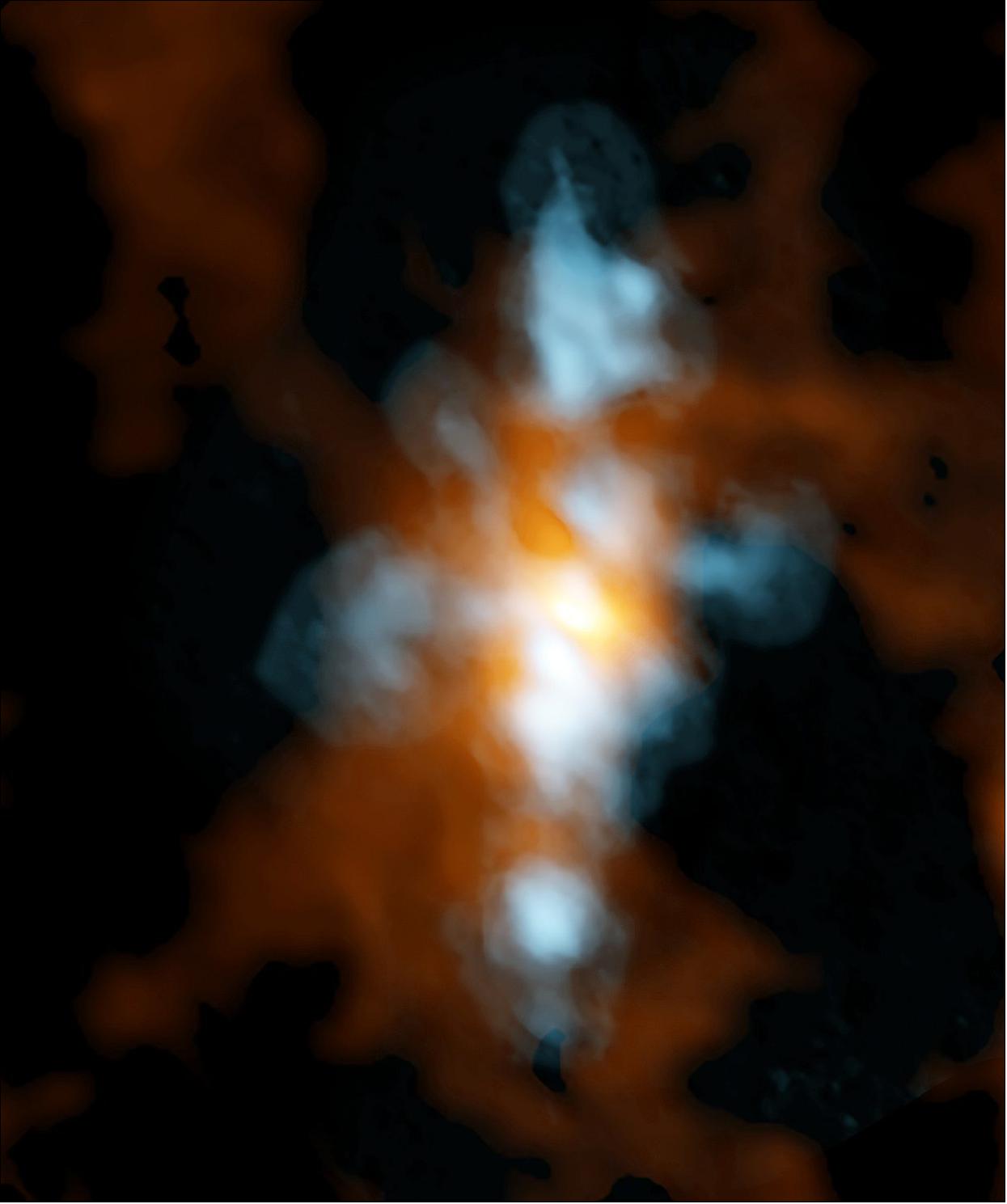
• April 25, 2018: Peering deep into space — an astounding 90 percent of the way across the observable universe — astronomers have witnessed the beginnings of a gargantuan cosmic pileup, the impending collision of 14 young, starbursting galaxies. This ancient megamerger is destined to evolve into one of the most massive structures in the known universe: a cluster of galaxies, gravitationally bound by dark matter and swimming in a sea of hot, ionized gas. 80)
![Figure 60: Zooming in to the galaxies discovered by ALMA that are evolving into a galaxy cluster. The outer field is from data taken by the Hershel Space Observatory. The middle image — a portion of a much-wider survey by NSF's South Pole Telescope — uncovered the distant galactic source that was studied by ALMA to reveal the 14 galaxies [image credit: ALMA (ESO/NAOJ/NRAO), T. Miller & S. Chapman et al.; Herschel; South Pole Telescope; (NRAO/AUI/NSF) B. Saxton]](https://www.eoportal.org/ftp/satellite-missions/n/NRAO_270622/NRAO_AutoB.jpeg)
- Using the Atacama Large Millimeter/submillimeter Array (ALMA), an international team of scientists has uncovered a startlingly dense concentration of 14 galaxies that are poised to merge, forming the core of what will eventually become a colossal galaxy cluster.
- This tightly bound galactic smashup, known as a protocluster, is located approximately 12.4 billion light-years away, meaning its light started traveling to us when the universe was only 1.4 billion years old, or about a tenth of its present age. Its individual galaxies are forming stars as much as 1,000 times faster than our home galaxy and are crammed inside a region of space only about three times the size of the Milky Way. The resulting galaxy cluster will eventually rival some of the most massive clusters we see in the universe today.
- The results are published in the journal Nature. 81)
- “Having caught a massive galaxy cluster in throes of formation is spectacular in and of itself,” said Scott Chapman, an astrophysicist at Dalhousie University in Halifax, Canada, who specializes in observational cosmology and studies the origins of structure in the universe and the evolution of galaxies.
- “But, the fact that this is happening so early in the history of the universe poses a formidable challenge to our present-day understanding of the way structures form in the universe,” he said.
- During the first few million years of cosmic history, normal matter and dark matter began to aggregate into larger and larger concentrations, eventually giving rise to galaxy clusters, the largest objects in the known universe. With masses comparable to a million billion suns, clusters may contain as many as a thousand galaxies, vast amounts of dark matter, gargantuan black holes, and X-ray emitting gas that reaches temperatures of over a million degrees.
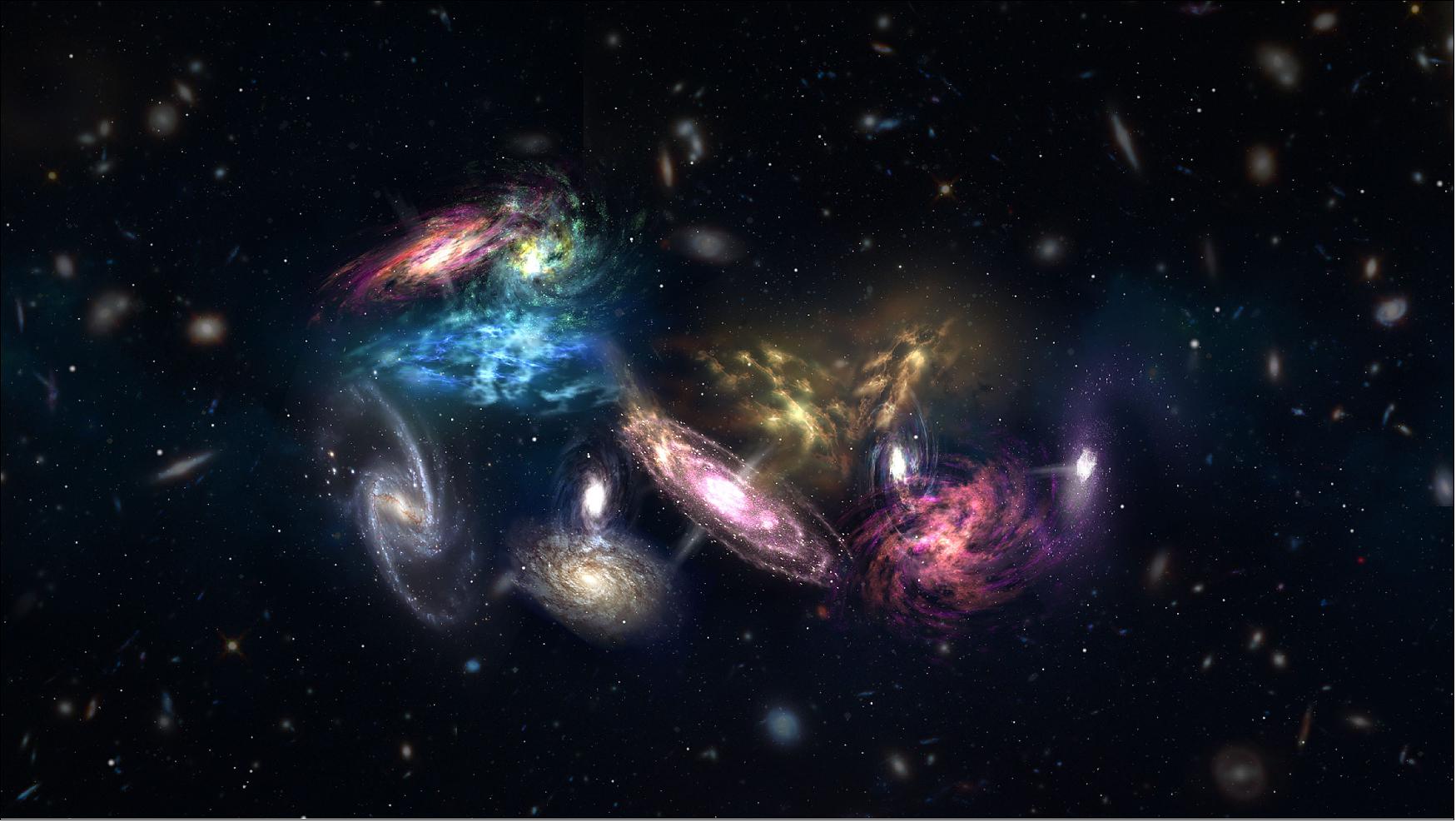
- Current theory and computer models suggest that protoclusters as massive as the one observed by ALMA, however, should have taken much longer to evolve.
- “How this assembly of galaxies got so big so fast is a bit of a mystery, it wasn’t built up gradually over billions of years, as astronomers might expect,” said Tim Miller, a doctoral candidate at Yale University and coauthor on the paper. “This discovery provides an incredible opportunity to study how galaxy clusters and their massive galaxies came together in these extreme environments.”
- This particular galactic protocluster, designated SPT2349-56, was first observed as a faint smudge of millimeter-wavelength light in 2010 with the National Science Foundation’s South Pole Telescope. Follow-up observations with the Atacama Pathfinder Experiment (APEX) telescope helped confirm that it was in fact an extremely distant galactic source and worthy of follow-up observations with ALMA. ALMA’s superior resolution and sensitivity allowed astronomers to distinguish no fewer than 14 individual objects in a shockingly small region of space, confirming the object was the archetypical example of a protocluster in a very early stage of development.
- This cluster’s extreme distance and clearly defined components offer astronomers an unprecedented opportunity to study some of the first steps of cluster formation less than 1.5 billion years after the Big Bang. By using the ALMA data as the starting conditions for sophisticated computer simulations, the researchers were able to demonstrate how this current collection of galaxies will likely grow and evolve over billions of years.
- “ALMA gave us, for the first time, a clear starting point to predict the evolution of a galaxy cluster. Over time, the 14 galaxies we observed will stop forming stars and will collide and coalesce into a single gigantic galaxy,” said Chapman.
• January 11, 2018: Astronomers using the Green Bank Telescope have made the first definitive interstellar detection of benzonitrile, an intriguing organic molecule that helps to chemically link simple carbon-based molecules and truly massive ones known as polycyclic aromatic hydrocarbons. This discovery is a vital clue in a 30-year-old mystery: identifying the source of a faint infrared glow that permeates the Milky Way and other galaxies. 82)
- Astronomers had a mystery on their hands. No matter where they looked, from inside the Milky Way to distant galaxies, they observed a puzzling glow of infrared light. This faint cosmic light, which presents itself as a series of spikes in the infrared spectrum, had no easily identifiable source. It seemed unrelated to any recognizable cosmic feature, like giant interstellar clouds, star-forming regions, or supernova remnants. It was ubiquitous and a bit baffling.
- The likely culprit, scientists eventually deduced, was the intrinsic infrared emission from a class of organic molecules known as polycyclic aromatic hydrocarbons (PAHs), which, scientists would later discover, are amazingly plentiful; nearly 10 percent of all the carbon in the universe is tied up in PAHs.
- Even though, as a group, PAHs seemed to be the answer to this mystery, none of the hundreds of PAH molecules known to exist had ever been conclusively detected in interstellar space.
- New data from the National Science Foundation’s Green Bank Telescope (GBT) show, for the first time, the convincing radio fingerprints of a close cousin and chemical precursor to PAHs, the molecule benzonitrile (C6H5CN). This detection may finally provide the “smoking gun” that PAHs are indeed spread throughout interstellar space and account for the mysterious infrared light astronomers had been observing.
- The results of this study are presented today at the 231st meeting of the American Astronomical Society (AAS) in Washington, D.C., and published in the journal Science.
- The science team, led by chemist Brett McGuire at the National Radio Astronomy Observatory (NRAO) in Charlottesville, Virginia, detected this molecule’s telltale radio signature coming from a nearby star-forming nebula known as the Taurus Molecular Cloud 1 (TCM-1), which is about 430 light-years from Earth.
- “These new radio observations have given us more insights than infrared observations can provide,” said McGuire. “Though we haven’t yet observed polycyclic aromatic hydrocarbons directly, we understand their chemistry quite well. We can now follow the chemical breadcrumbs from simple molecules like benzonitrile to these larger PAHs.”
- Though benzonitrile is one of the simplest so-called aromatic molecules, it is in fact the largest molecule ever seen by radio astronomy. It also is the first 6-atom aromatic ring (a hexagonal array of carbon atoms bristling with hydrogen atoms) molecule ever detected with a radio telescope.
- While aromatic rings are commonplace in molecules seen here on Earth (they are found in everything from food to medicine), this is the first such ring molecule ever seen in space with radio astronomy. Its unique structure enabled the scientists to tease out its distinctive radio signature, which is the “gold standard” when confirming the presence of molecules in space.
- As molecules tumble in the near vacuum of interstellar space, they give off a distinctive signature, a series of telltale spikes that appear in the radio spectrum. Larger and more complex molecules have a correspondingly more-complex signature, making them harder to detect. PAHs and other aromatic molecules are even more difficult to detect because they typically form with very symmetrical structures.
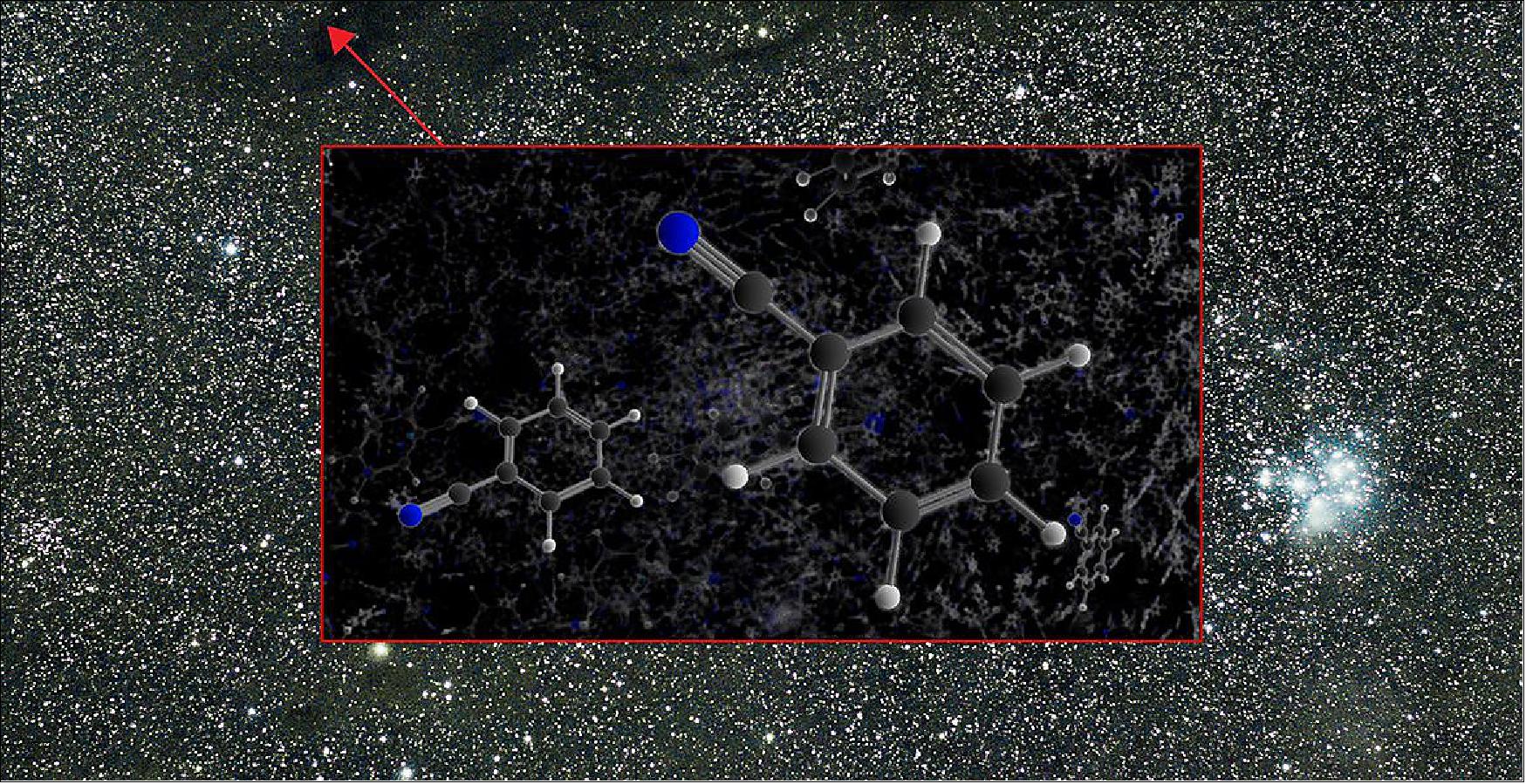
- To produce a clear radio fingerprint, molecules must be somewhat asymmetrical. Molecules with more uniform structures, like many PAHs, can have very weak signatures or no signature at all..
- Benzonitrile’s lopsided chemical arrangement allowed McGuire and his team to identify nine distinct spikes in the radio spectrum that correspond to the molecule. They also could observe the additional effects of nitrogen atom nuclei on the radio signature.
- “The evidence that the GBT allowed us to amass for this detection is incredible,” said McGuire. “As we look for yet larger and more interesting molecules, we will need the sensitivity of the GBT, which has unique capabilities as a cosmic molecule detector.” 83)
• December 6, 2017: Astronomers expect that the first galaxies, those that formed just a few hundred million years after the Big Bang, would share many similarities with some of the dwarf galaxies we see in the nearby universe today. These early agglomerations of a few billion stars would then become the building blocks of the larger galaxies that came to dominate the universe after the first few billion years. 84)
- Ongoing observations with ALMA (Atacama Large Millimeter/submillimeter Array), however, have discovered surprising examples of massive, star-filled galaxies seen when the cosmos was less than a billion years old. This suggests that smaller galactic building blocks were able to assemble into large galaxies quite quickly.
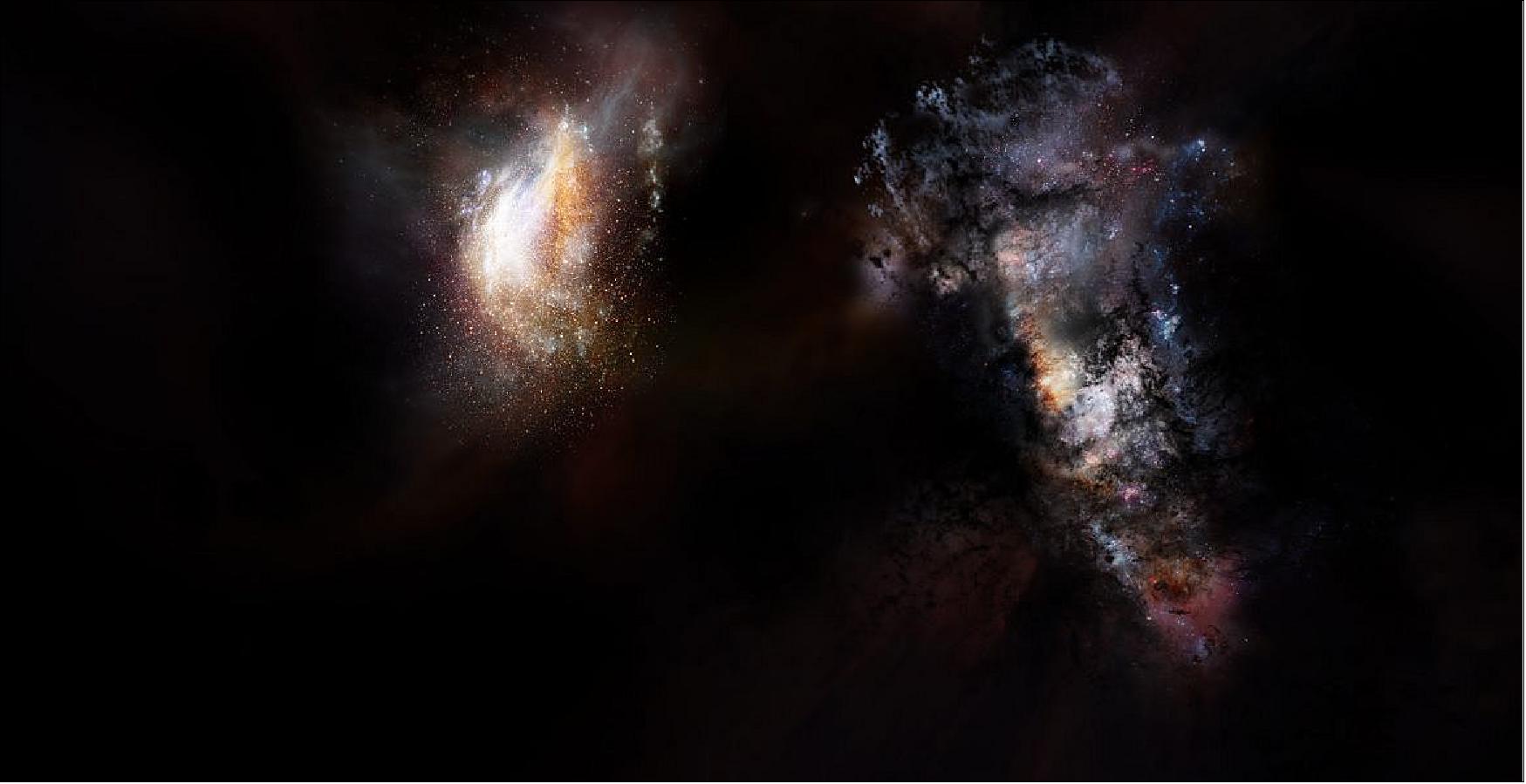
- The latest ALMA observations push back this epoch of massive-galaxy formation even further by identifying two giant galaxies seen when the universe was only 780 million years old, or about 5 percent its current age. ALMA also revealed that these uncommonly large galaxies are nestled inside an even-more-massive cosmic structure, a halo of dark matter several trillion times more massive than the sun.
- The two galaxies are in such close proximity — less than the distance from the Earth to the center of our galaxy — that they will shortly merge to form the largest galaxy ever observed at that period in cosmic history. This discovery provides new details about the emergence of large galaxies and the role that dark matter plays in assembling the most massive structures in the universe.
- The researchers report their findings in the journal Nature. 85)
- “With these exquisite ALMA observations, astronomers are seeing the most massive galaxy known in the first billion years of the universe in the process of assembling itself,” said Dan Marrone, associate professor of astronomy at the University of Arizona in Tucson and lead author on the paper.
- Astronomers are seeing these galaxies during a period of cosmic history known as the Epoch of Reionization, when most of intergalactic space was suffused with an obscuring fog of cold hydrogen gas. As more stars and galaxies formed, their energy eventually ionized the hydrogen between the galaxies, revealing the universe as we see it today.
- “We usually view that as the time of little galaxies working hard to chew away at the neutral intergalactic medium,” said Marrone. “Mounting observational evidence with ALMA, however, has helped to reshape that story and continues to push back the time at which truly massive galaxies first emerged in the universe.”
- The galaxies that Marrone and his team studied, collectively known as SPT0311-58, were originally identified as a single source by the South Pole Telescope. These first observations indicated that this object was very distant and glowing brightly in infrared light, meaning that it was extremely dusty and likely going through a burst of star formation. Subsequent observations with ALMA revealed the distance and dual nature of the object, clearly resolving the pair of interacting galaxies.
- To make this observation, ALMA had some help from a gravitational lens, which provided an observing boost to the telescope. Gravitational lenses form when an intervening massive object, like a galaxy or galaxy cluster, bends the light from more distant galaxies. They do, however, distort the appearance of the object being studied, requiring sophisticated computer models to reconstruct the image as it would appear in its unaltered state.
- This “de-lensing” process provided intriguing details about the galaxies, showing that the larger of the two is forming stars at a rate of 2,900 solar masses per year. It also contains about 270 billion times the mass of our sun in gas and nearly 3 billion times the mass of our sun in dust. “That’s a whopping large quantity of dust, considering the young age of the system,” noted Justin Spilker, a recent graduate of the University of Arizona and now a postdoctoral fellow at the University of Texas at Austin.
- The astronomers determined that this galaxy’s rapid star formation was likely triggered by a close encounter with its slightly smaller companion, which already hosts about 35 billion solar masses of stars and is increasing its rate of starburst at the breakneck pace of 540 solar masses per year.
- The researchers note that galaxies of this era are “messier” than the ones we see in the nearby universe. Their more jumbled shapes would be due to the vast stores of gas raining down on them and their ongoing interactions and mergers with their neighbors.
- The new observations also allowed the researchers to infer the presence of a truly massive dark matter halo surrounding both galaxies. Dark matter provides the pull of gravity that causes the universe to collapse into structures (galaxies, groups and clusters of galaxies, etc.).
- “If you want to see if a galaxy makes sense in our current understanding of cosmology, you want to look at the dark matter halo — the collapsed dark matter structure — in which it resides,” said Chris Hayward, associate research scientist at the Center for Computational Astrophysics at the Flatiron Institute in New York City. “Fortunately, we know very well the ratio between dark matter and normal matter in the universe, so we can estimate what the dark matter halo mass must be.”
- By comparing their calculations with current cosmological predictions, the researchers found that this halo is one of the most massive that should exist at that time.
- “There are more galaxies discovered with the South Pole Telescope that we’re following up on,” said Joaquin Vieira of the University of Illinois at Urbana-Champaign, “and there is a lot more survey data that we are just starting to analyze. Our hope is to find more objects like this, possibly even more distant ones, to better understand this population of extreme dusty galaxies and especially their relation to the bulk population of galaxies at this epoch.”
- “In any case, our next round of ALMA observations should help us understand how quickly these galaxies came together and improve our understanding of massive galaxy formation during reionization,” added Marrone.
![Figure 64: A composite image showing ALMA data (red) of the two galaxies of SPT0311-58. These galaxies are shown over a background from the Hubble Space Telescope (blue and green). The ALMA data show the two galaxies' dusty glow. The image of the galaxy on the right is distorted by gravitational lensing. The nearer foreground lensing galaxy is the green object between the two galaxies imaged by ALMA [image credit: ALMA (ESO/NAOJ/NRAO), Marrone, et al.; B. Saxton (NRAO/AUI/NSF); NASA/ESA Hubble]](https://www.eoportal.org/ftp/satellite-missions/n/NRAO_270622/NRAO_Auto7.jpeg)
• March 23, 2017: By harnessing the extreme sensitivity of the Atacama Large Millimeter/submillimeter Array (ALMA), astronomers have directly observed a pair of Milky Way-like galaxies seen when the universe was only eight percent of its current age. These progenitors of today’s giant spiral galaxies are surrounded by “super halos” of hydrogen gas that extend many tens of thousands of light-years beyond their dusty, star-filled disks. 86)
![Figure 65: Artist impression of a progenitor of Milky Way-like galaxy in the early universe with a background quasar shinning through a 'super halo' of hydrogen gas surrounding the galaxy. New ALMA observations of two such galaxies reveal that these vast halos extend well beyond the galaxies' dusty, star-forming disks. The galaxies were initially found by the absorption of background quasar light passing through the galaxies. ALMA was able to image the ionized carbon in the galaxies' disks, revealing crucial details about their structures [image credit: Alexandra Angelich (NRAO/AUI/NSF)]](https://www.eoportal.org/ftp/satellite-missions/n/NRAO_270622/NRAO_Auto6.jpeg)
- Astronomers initially detected these galaxies by studying the intense light from even-more-distant quasars. As this light travels through an intervening galaxy on its way to Earth, it can pick up the unique spectral signature from the galaxy’s gas. This technique, however, normally prevents astronomers from seeing the actual light emitted by the galaxy, which is overwhelmed by the much brighter emission from the background quasar.
- “Imagine a tiny firefly next to a high-power search light. That’s what astronomers are up against when it comes to observing these youthful versions of our home galaxy,” said Marcel Neeleman a postdoctoral fellow at the University of California, Santa Cruz, and lead author on a paper appearing in the journal Science. “We can now see the galaxies themselves, which gives us an amazing opportunity to learn about the earliest history of our own galaxy and others like it.” 87)
- With ALMA, the astronomers were finally able to observe the natural millimeter-wavelength “glow” emitted by ionized carbon in the dense and dusty star-forming regions of the galaxies. This carbon signature, however, is considerably offset from the gas first detected by quasar absorption. This extreme separation indicates that the galaxies’ gas content extends well beyond their star-filled disks, suggesting that each galaxy is embedded in a monstrous halo of hydrogen gas.
- “We had expected we would see faint emission right on top of the quasar, and instead we saw bright galaxies at large separations from the quasar,” said J. Xavier Prochaska, professor of astronomy and astrophysics at UC Santa Cruz and coauthor of the paper. The separation from the quasar to the observed galaxy is about 137,000 light-years for one galaxy and about 59,000 light-years for the other.
- According to the researchers, the neutral hydrogen gas revealed by its absorption of quasar light is most likely part of a large halo or perhaps an extended disk of gas around the galaxy. “It’s not where the star formation is, and to see so much gas that far from the star-forming region means there is a large amount of neutral hydrogen around the galaxy,” Neeleman said.
- The new ALMA data show that these young galaxies are already rotating, which is one of the hallmarks of the massive spiral galaxies we see in the universe today. The ALMA observations further reveal that both galaxies are forming stars at moderately high rates: more than 100 solar masses per year in one galaxy and about 25 solar masses per year in the other.
- “These galaxies appear to be massive, dusty, and rapidly star-forming systems, with large, extended layers of gas,” Prochaska said.
- “ALMA has solved a decades-old question on galaxy formation,” said Chris Carilli, an astronomer with the National Radio Astronomy Observatory in Socorro, N.M., and co-author on the paper. “We now know that at least some very early galaxies have halos that are much more extended that previously considered, which may represent the future material for galaxy growth.”
- The galaxies, which are officially designated ALMA J081740.86+135138.2 and ALMA J120110.26+211756.2, are each about 12 billion light-years from Earth. The background quasars are each roughly 12.5 billion light-years from Earth.
• January 17, 2017: New images from the Atacama Large Millimeter/submillimeter Array (ALMA) reveal stunning details of our Sun, including the dark, contorted center of an evolving sunspot that is nearly twice the diameter of the Earth. 88)
- These images are part of the testing and verification campaign to make ALMA’s solar observing capabilities available to the international astronomical community.
- Though designed principally to observe remarkably faint objects throughout the universe — such as distant galaxies and planet-forming disks around young stars – ALMA is also capable of studying objects in our own solar system, including planets, comets, and now the Sun.
- During a 30-month period beginning in 2014, an international team of astronomers harnessed ALMA’s single-antenna and array capabilities to detect and image the millimeter-wavelength light emitted by the Sun’s chromosphere — the region that lies just above the photosphere, the visible surface of the Sun.
- These new images demonstrate ALMA’s ability to study solar activity at longer wavelengths than observed with typical solar telescopes on Earth, and are an important expansion of the range of observations that can be used to probe the physics of our nearest star.
- “We’re accustomed to seeing how our Sun appears in visible light, but that can only tell us so much about the dynamic surface and energetic atmosphere of our nearest star,” said Tim Bastian, an astronomer with the National Radio Astronomy Observatory in Charlottesville, Va. “To fully understand the Sun, we need to study it across the entire electromagnetic spectrum, including the millimeter and submillimeter portion that ALMA can observe.”
- Since our Sun is many billions of times brighter than the faint objects ALMA typically observes, the solar commissioning team had to develop special procedures to enable ALMA to safely image the Sun.
- The result of this work is a series of images that demonstrates ALMA’s unique vision and ability to study our Sun on multiple scales.
![Figure 66: This ALMA image of an enormous sunspot was taken on 18 December 2015 with the Band 6 receiver at a wavelength of 1.25 mm. Sunspots are transient features that occur in regions where the Sun’s magnetic field is extremely concentrated and powerful. They are lower in temperature than their surrounding regions, which is why they appear relatively dark in visible light. The ALMA image is essentially a map of temperature differences in a layer of the Sun's atmosphere known as the chromosphere, which lies just above the visible surface of the Sun (the photosphere). The chromosphere is considerably hotter than the photosphere. Understanding the heating and dynamics of the chromosphere are key areas of research that will be addressed by ALMA. Observations at shorter wavelengths probe deeper into the solar chromosphere than longer wavelengths. Hence, band 6 observations map a layer of the chromosphere that is closer to the visible surface of the Sun than band 3 observations [image credit: ALMA (ESO/NAOJ/NRAO)]](https://www.eoportal.org/ftp/satellite-missions/n/NRAO_270622/NRAO_Auto5.jpeg)
• November 4, 2016: Astronomers using ALMA have discovered a tsunami of stars and gas that is crashing midway through the disk of a spiral galaxy known as IC 2163. This colossal wave of material – which was triggered when IC 2163 recently sideswiped another spiral galaxy dubbed NGC 2207 – produced dazzling arcs of intense star formation that resemble a pair of eyelids. 89)
- “Although galaxy collisions of this type are not uncommon, only a few galaxies with eye-like, or ocular, structures are known to exist,” said Michele Kaufman, an astronomer formerly with The Ohio State University in Columbus and lead author on a paper published in the Astrophysical Journal. 90)
- Kaufman and her colleagues note that the paucity of similar features in the observable universe is likely due to their ephemeral nature. “Galactic eyelids last only a few tens of millions of years, which is incredibly brief in the lifespan of a galaxy. Finding one in such a newly formed state gives us an exceptional opportunity to study what happens when one galaxy grazes another,” said Kaufman.
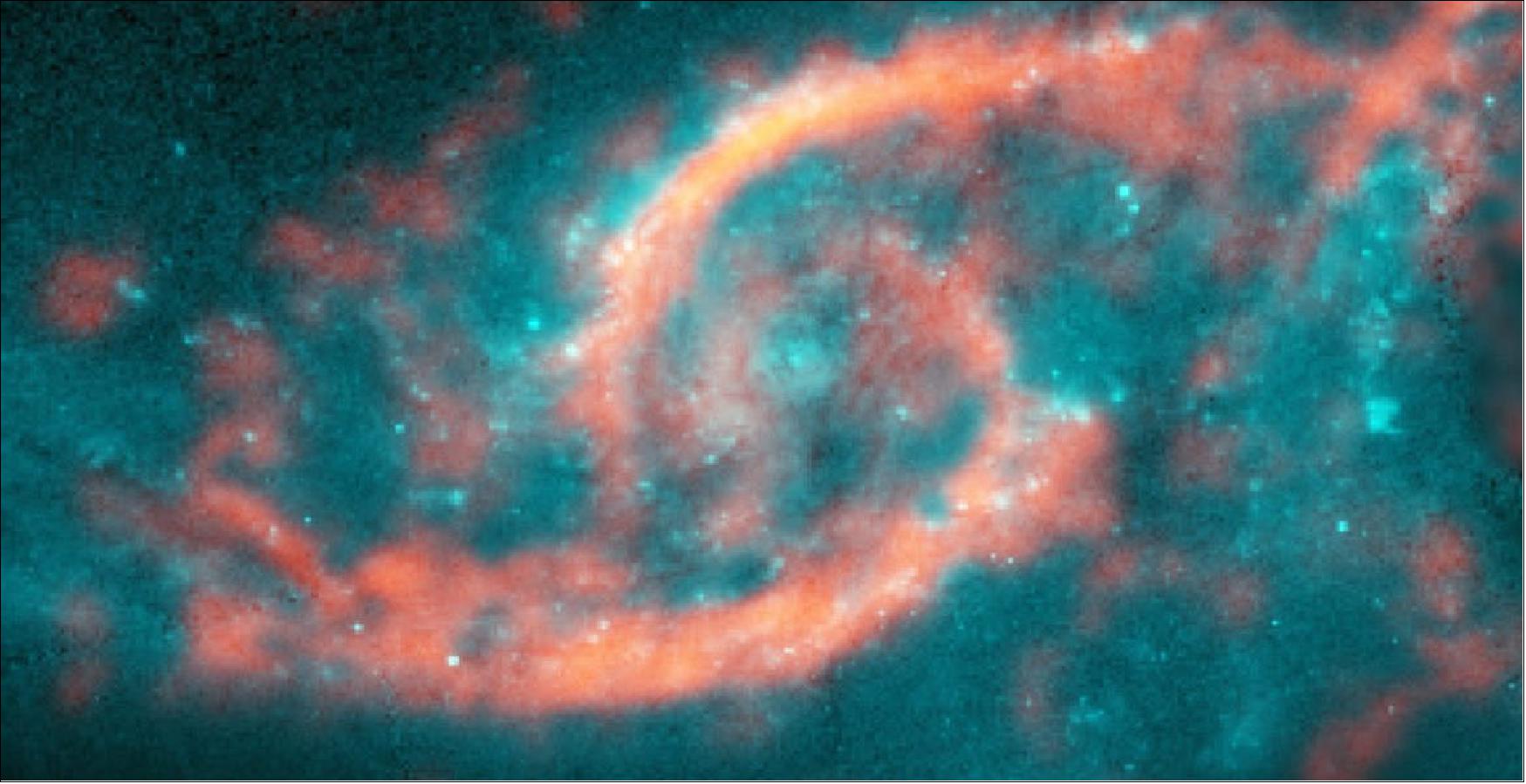
- The interacting pair of galaxies resides approximately 114 million light-years from Earth in the direction of the constellation Canis Major. These galaxies brushed past each other – scraping the edges of their outer spiral arms – in what is likely the first encounter of an eventual merger.
- Using ALMA’s remarkable sensitivity and resolution, the astronomers made the most detailed measurements ever of the motion of carbon monoxide gas in the galaxy’s narrow eyelid features. Carbon monoxide is a tracer of molecular gas, which is the fuel for star formation.
- The data reveal that the gas in the outer portion of IC 2163’s eyelids is racing inward at speeds in excess of 100 kilometers a second. This gas, however, quickly decelerates and its motion becomes more chaotic, eventually changing trajectory and aligning itself with the rotation of the galaxy rather than continuing its pell-mell rush toward the center.
- “What we observe in this galaxy is very much like a massive ocean wave barreling toward shore until it interacts with the shallows, causing it to lose momentum and dump all of its water and sand on the beach,” said Bruce Elmegreen, a scientist with IBM’s T .J. Watson Research Center in Yorktown Heights, New York, and co-author on the paper.
- “Not only do we find a rapid deceleration of the gas as it moves from the outer to the inner edge of the eyelids, but we also measure that the more rapidly it decelerates, the denser the molecular gas becomes,” said Kaufman. “This direct measurement of compression shows how the encounter between the two galaxies drives gas to pile up, spawn new star clusters and form these dazzling eyelid features.”
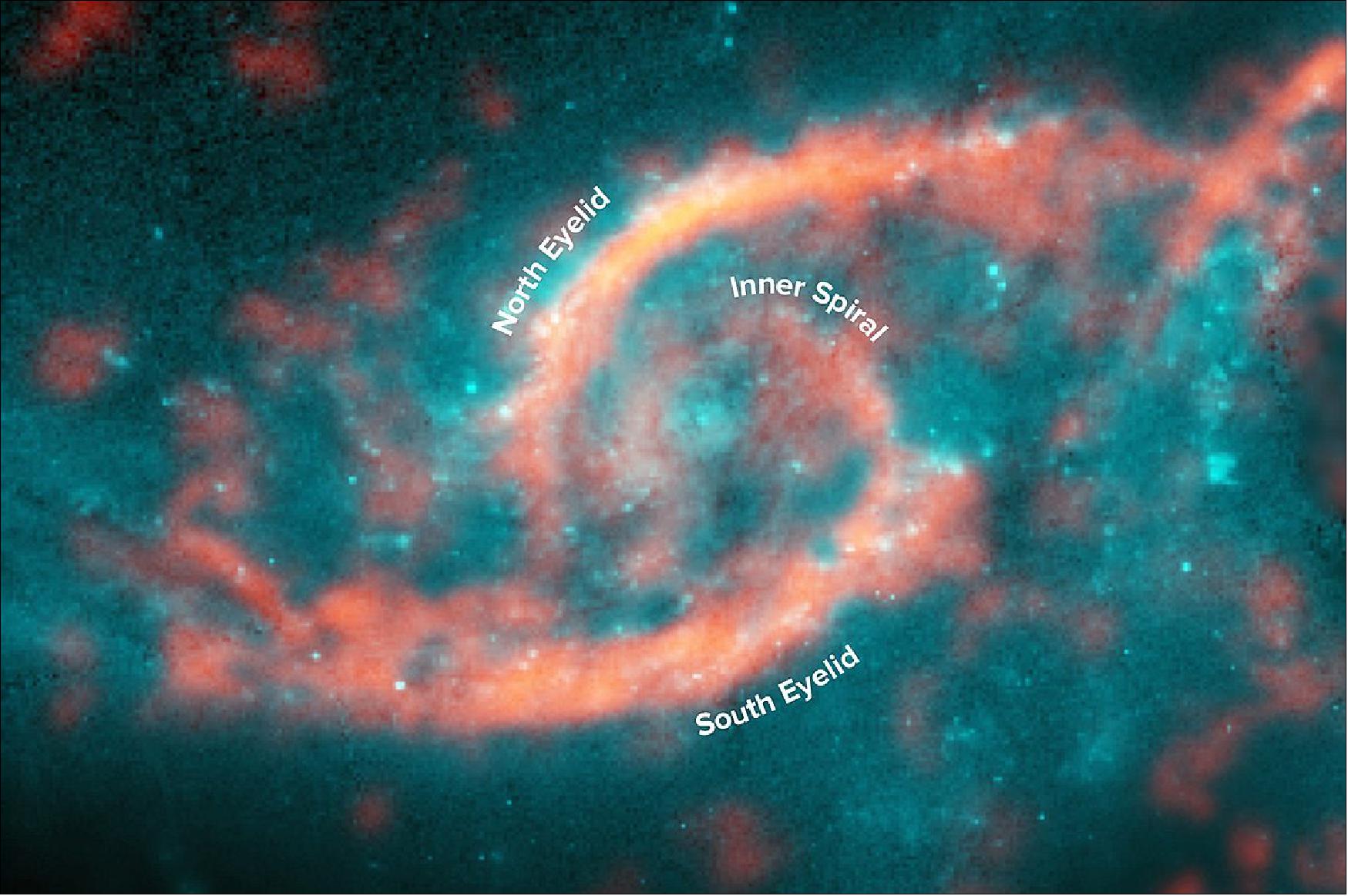
- Computer models predict that such eyelid-like features could evolve if galaxies interacted in a very specific manner. “This evidence for a strong shock in the eyelids is terrific. It’s all very well to have a theory and simulations suggesting it should be true, but real observational evidence is great,” said Curtis Struck, a professor of astrophysics at Iowa State University in Ames and co-author on the paper.
- ALMA showed us that the velocities of the molecular gas in the eyelids are on the right track with the predictions we get from computer models,” said Kaufman. “This critical test of encounter simulations was not possible before.”
- Astronomers believe that such collisions between galaxies were common in the early universe when galaxies were closer together. At that time, however, galactic disks were generally clumpy and irregular, so other processes likely overwhelmed the formation of similar eyelid features.
- The authors continue to study this galaxy pair and currently are comparing the properties (e.g., locations, ages, and masses) of the star clusters previously observed with NASA’s Hubble Space Telescope with the properties of the molecular clouds observed with ALMA. They hope to better understand the differences between molecular clouds and star clusters in the eyelids and those elsewhere in the galaxy pair.
• April 5, 2016: New results from NANOGrav – the North American Nanohertz Observatory for Gravitational Waves – establish astrophysically significant limits in the search for low-frequency gravitational waves. This result provides insight into how often galaxies merge and how those merging galaxies evolve over time. To obtain this result, scientists required an exquisitely precise, nine-year pulsar-monitoring campaign conducted by two of the most sensitive radio telescopes on Earth, the Green Bank Telescope in West Virginia and the Arecibo Observatory in Puerto Rico. 91)
- The recent LIGO (Laser Interferometer Gravitational-Wave Observatory) detection of gravitational waves from merging black holes with tens of solar masses has confirmed that distortions in the fabric of space-time can be observed and measured. Researchers from the North American Nanohertz Observatory for Gravitational Waves (NANOGrav) have spent the past decade searching for low-frequency gravitational waves emitted by black hole binaries with masses many millions of times larger than those seen by LIGO.
![Figure 69: The Earth is constantly jostled by low-frequency gravitational waves from supermassive black hole binaries in distant galaxies. Astrophysicists are using pulsars as a galaxy-sized detector to measure the Earth’s motion from these waves [image credit: B. Saxton (NRAO/AUI/NSF)]](https://www.eoportal.org/ftp/satellite-missions/n/NRAO_270622/NRAO_Auto2.jpeg)
- Analysis of NANOGrav’s nine-year dataset provides very constraining limits on the prevalence of such supermassive black hole binaries throughout the Universe. Given scientists’ current understanding of how often galaxies merge, these limits point to fewer detectable supermassive black hole binaries than were previously expected. This result has significant impacts on our understanding of how galaxies and their central black holes co-evolve.
- Pulsars are the cores of massive stars left behind after stars go supernova. The fastest pulsars rotate hundreds of times each second and emit a pulse of radio waves every few milliseconds. These millisecond pulsars (MSPs) are considered nature’s most precise clocks and are ideal for detecting the small signal from gravitational waves. “This measurement is possible because the gravitational wave background imprints a unique signature onto the radio waves seen from a collection of MSPs,” said Justin Ellis, Einstein Fellow at NASA’s Jet Propulsion Laboratory, California Institute of Technology in Pasadena, California, and a co-author on the report published in Astrophysical Journal. 92)
- Astrophysicists use computer models to predict how often galaxies merge and form supermassive black hole binaries. Those models use several simplifying assumptions about how black hole binaries evolve when they predict the strength of the stochastic gravitational wave background. By using information about galaxy mergers and constraints on the background, the scientists are able to improve their assumptions about black hole binary evolution.
- Ellis continues: “After nine years of observing a collection of MSPs, we haven’t detected the stochastic background but we are beginning to rule out many predictions based on current models of galaxy evolution. We are now at a point where the non-detection of gravitational waves is actually improving our understanding of black hole binary evolution.”
- “Pulsar timing arrays like NANOGrav are making novel observations of the evolution and nature of our Universe,” says Sarah Burke Spolaor, Jansky Fellow at the National Radio Astronomy Observatory (NRAO) in Socorro, New Mexico, and a co-author on the paper.
- According to Spolaor, there are two possible interpretations of this non-detection. “Some supermassive black hole binaries may not be in circular orbits or are significantly interacting with gas or stars. This would drive them to merge faster than simple models have assumed in the past,” she said. An alternate explanation is that many of these binaries inspiral too slowly to ever emit detectable gravitational waves.
- NANOGrav is currently monitoring 54 pulsars, using the National Science Foundation’s Green Bank Telescope in West Virginia and Arecibo Radio Observatory in Puerto Rico, the two most sensitive radio telescopes at these frequencies . Their array of pulsars is continually growing as new MSPs are discovered. In addition, the group collaborates with radio astronomers in Europe and Australia as part of the International Pulsar Timing Array, giving them access to many more pulsar observations. Ellis estimates that this increase in sensitivity could lead to a detection in as little as five years.
- In addition, this measurement helps constrain the properties of cosmic strings, very dense and thin cosmological objects, which many theorists believe evolved when the Universe was just a fraction of a second old. These strings can form loops, which then decay through gravitational wave emission. The most conservative NANOGrav limit on cosmic string tension is the most stringent limit to date, and will continue to improve as NANOGrav continues operating.
- “These new results from NANOGrav have the most important astrophysical implications yet,” said Scott Ransom, an astronomer with the NRAO in Charlottesville, Virginia. “As we improve our detection capabilities, we get closer and closer to that important threshold where the cosmic murmur begins to be heard. At that point, we’ll be able to perform entirely new types of physics experiments on cosmic scales and open up a new window on the Universe, just like LIGO just did for high-frequency gravitational waves.”
- NANOGrav is a collaboration of over 60 scientists at over a dozen institutions in the United States and Canada whose goal is detecting low-frequency gravitational waves to open a new window on the Universe. The group uses radio pulsar timing observations to search for the ripples in the fabric of spacetime. In 2015, NANOGrav was awarded $14.5 million by the National Science Foundation (NSF) to create and operate a Physics Frontiers Center.
- The Physics Frontier Centers bring people together to address frontier science, and NANOGrav’s work in low-frequency gravitational wave physics is a great example,” said Jean Cottam Allen, the NSF program director who oversees the Physics Frontiers Center program. “We’re delighted with their progress thus far, and we’re excited to see where it will lead.”
• December 2, 2015: Fast Radio Bursts (FRBs), brief yet brilliant eruptions of cosmic radio waves, have baffled astronomers since they were first reported nearly a decade ago. Though they appear to come from the distant Universe, none of these enigmatic events has revealed more than the slimmest details about how and where it formed, until now. 93)
- By poring over 650 hours of archival data from the National Science Foundation’s (NSF) Green Bank Telescope (GBT), a team of astronomers uncovered the most detailed record ever of an FRB. Their research indicates that the burst originated inside a highly magnetized region of space, possibly linking it to a recent supernova or the interior of an active star-forming nebula.
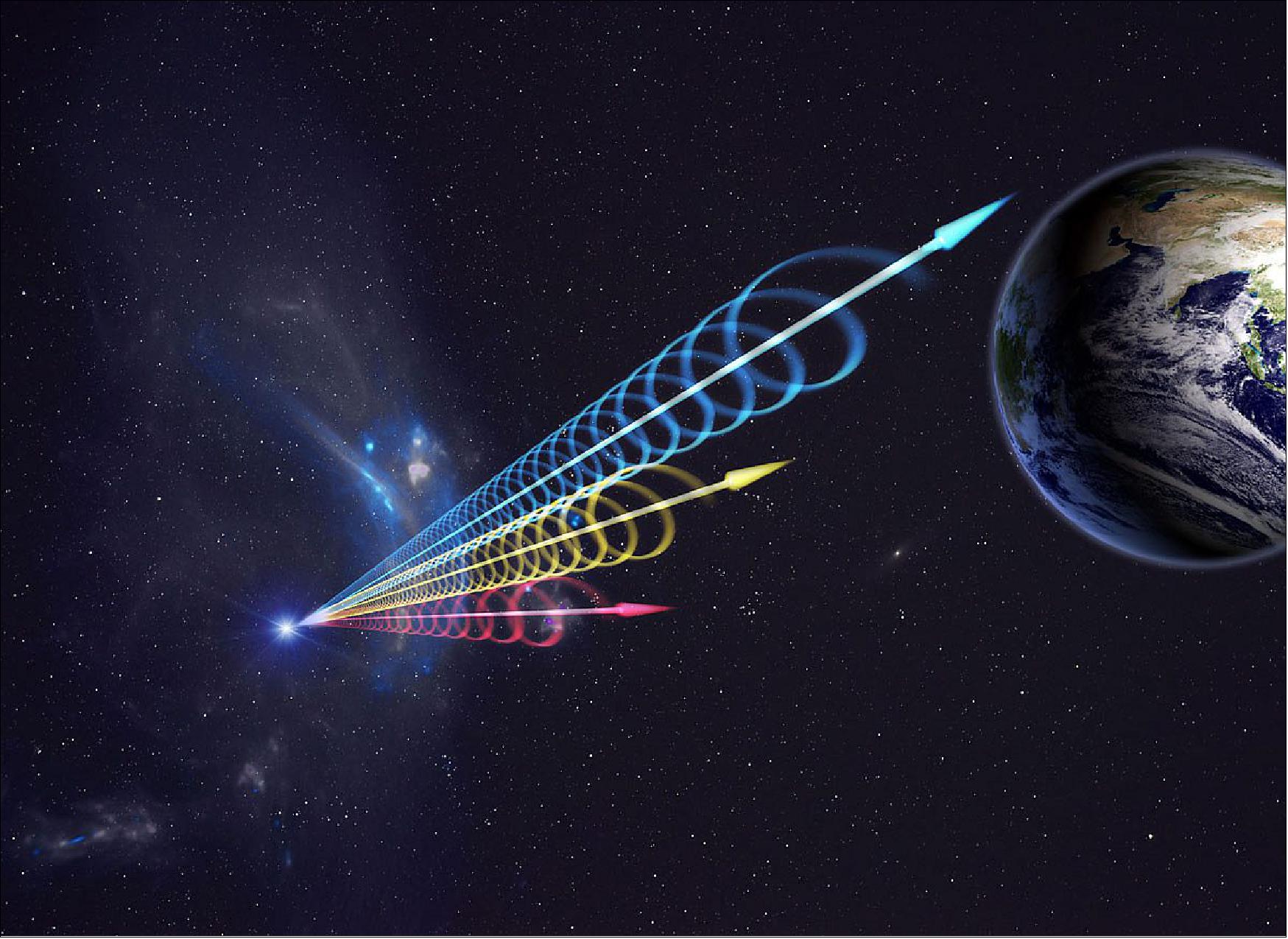
- “We now know that the energy from this FRB passed through a dense, magnetized region shortly after it formed. This significantly narrows down the source’s environment and type of event that triggered the burst,” said Kiyoshi Masui, an astronomer with the University of British Columbia and the Canadian Institute for Advanced Research.
- Lasting only a fraction of a second yet packing a phenomenal amount of energy, FRBs are brief radio flashes of unknown origin that appear to come from random directions on the sky. Though only a handful have been documented previously, astronomers believe that the observable Universe is rocked by thousands of these events each day.
Mining Data to Find Elusive Nugget
- The astronomers found the newly identified FRB, dubbed FRB 110523, by using highly specialized software developed by Masui and his colleague Jonathan Sievers from the University of KwaZulu-Natal in Durban, South Africa.
- The recorded data — a total of 40 terabytes — created a substantial analysis challenge, which was made even more difficult because the otherwise short, sharp signal of an FRB becomes “smeared out” in frequency by its journey through space.
- This smearing of the radio signal, known as dispersion delay, is often used to estimate distance in radio astronomy: the greater the dispersion, the further the object from Earth. In this case, the dispersion measure suggests the FRB originated as far as 6 billion light-years away.
- Dispersion, however, masks the presence of an FRB within archival radio data.
- The new software decreased the time required to analyze the data by counteracting the effects of dispersion, which restored the burst to its original appearance.
- The team — primarily researchers with cosmology backgrounds — used this software to conduct an initial pass of the GBT data to flag any candidate signal. This yielded more than 6,000 possible FRBs, which were individually inspected by team member Hsiu-Hsien Lin from Carnegie Mellon University in Pittsburgh. His analysis winnowed the field until only one candidate remained.
Details Hidden in Polarization
- This one signal, however, was exceptional and contained more details about its polarization than any previously identified. Prior to this detection, only circular polarization was associated with an FRB. The new GBT study includes a detection of both circular and linear polarization.
- “Hidden within an incredibly massive dataset, we found a very peculiar signal, one that matched all the known characteristics of a Fast Radio Burst, but with a tantalizing extra polarization element that we simply have never seen before,” said Jeffrey Peterson, a faculty member in Carnegie Mellon’s McWilliams Center for Cosmology.
- Polarization is a property of electromagnetic radiation, including light and radio waves, and indicates the orientation of the wave. Polarizing sunglasses use this property to block out a portion of the Sun’s rays and 3-D movies use it to achieve the illusion of depth.
- The researchers used this additional information to determine that the radio light from the FRB exhibited Faraday rotation, a corkscrew-like twisting radio waves acquire by passing through a powerful magnetic field.
- In addition, measurements of the dispersion delay can be used to place a lower limit on the size of the source region. In this case, the measurement rules out models for FRBs involving stars in our Galaxy and, for the first time, shows that the FRB must have originated in another galaxy.
- Further analysis of the signal reveals that it also passed through two distinct regions of ionized gas, called screens, on its way to Earth. By using the interplay between the two screens, the astronomers were able to determine their relative locations. The strongest screen is very near the burst’s source — within a hundred thousand light-years — placing it inside the source’s galaxy. Only two things could leave such an imprint on the signal, the researchers note: a nebula surrounding the source or the environment near the center of a galaxy.
- ”Taken together, these remarkable data reveal more about an FRB than we have ever seen before and give us important constraints on these mysterious events,” concludes Masui. “We also have an exciting new tool to search through otherwise overwhelming archival data to uncover more examples and get closer to truly understanding their nature.”
- The results are published in the journal Nature. 94)
• March 10, 2015: Researchers using the Karl G. Jansky Very Large Array (VLA) have produced the most detailed image yet of a fascinating region where clusters of hundreds of galaxies are colliding, creating a rich variety of mysterious phenomena visible only to radio telescopes. 95)
- The scientists took advantage of new VLA capabilities to make a “true color” radio image. This image shows the region as it would appear if human eyes were sensitive to radio waves instead of light waves. In this image, red shows where longer radio waves predominate, and blue shows where shorter radio waves predominate, following the pattern we see in visible light.
- The image shows a number of strange features the astronomers think are related to an ongoing collision of galaxy clusters. The region is called Abell 2256, and is about 800 million light-years from Earth and some 4 million light-years across. The image covers an area in the sky almost as large as the full moon. Studied by astronomers for more than half a century with telescopes ranging from radio to X-ray, Abell 2256 contains a fascinating variety of objects, many of whose exact origins remain unclear.
- With monikers such as “Large Relic,” “Halo,” and “Long Tail,” the features in this region are seen in greater fidelity than ever before, said Frazer Owen, of the National Radio Astronomy Observatory (NRAO). “The image reveals details of the interactions between the two merging clusters and suggests that previously unexpected physical processes are at work in such encounters,” he said.
- Owen worked with Lawrence Rudnick of the University of Minnesota; Jean Eilek of New Mexico Tech; and Urvashi Rau, Sanjay Bhatnagar, and Leonid Kogan of NRAO. The researchers presented their results in the Astrophysical Journal. 96)
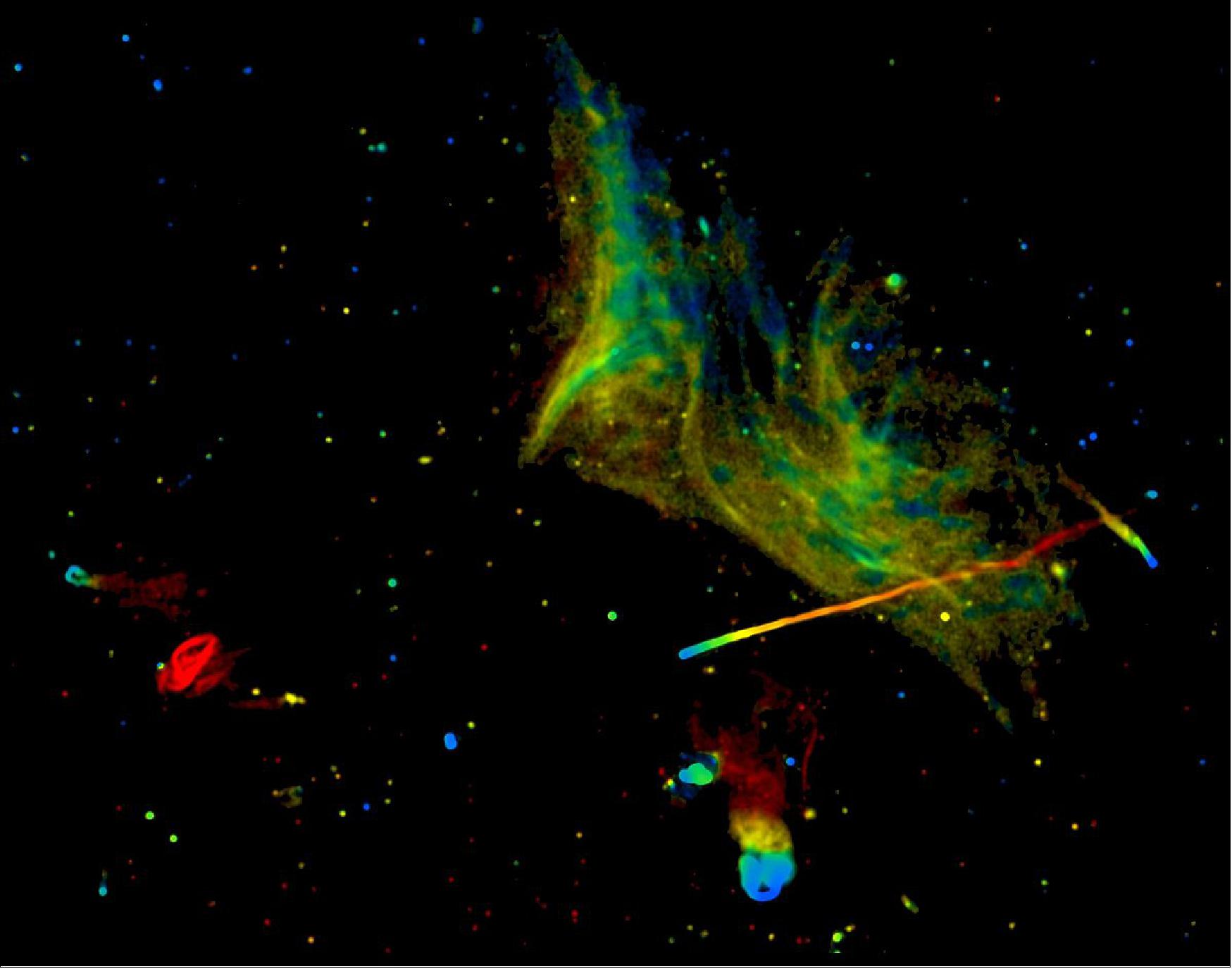
References
1) ”National Radio Astronomy Observatory (NRAO),” NSF, URL: https://www.nsf.gov/funding/pgm_summ.jsp?pims_id=5653&org=MPS
2) ”The History of Radio Astronomy,” NRAO, 2020, URL: https://public.nrao.edu/radio-astronomy/the-history-of-radio-astronomy/
3) Karl G. Jansky, ”Radio Waves from Outside the Solar System,” Nature Volume 132, Issue 3323, 8 July 1933, pp: 66, https://doi.org/10.1038/132066a0
4) ”The final ALMA antenna arrives at Chajnantor,” ALMA partnership, June 16, 2014, URL: http://www.eso.org/public/images/ann14048a/
5) ”Very Large Array,” NRAO, URL: https://public.nrao.edu/telescopes/vla/
6) ”The VLA is in A-configuration,” 9 December 2020, URL: http://www.vla.nrao.edu/operators/CurrentPos.pdf
7) ”Green Bank Interferometer,” NRAO, 2020, URL: https://public.nrao.edu/telescopes/green-bank-interferometer/
8) ”Very Long Baseline Array,” NRAO, URL: https://public.nrao.edu/telescopes/vlba/
9) ”GBT: The Robert C. Byrd Green Bank Telescope,” Cornell University, 2005, URL: http://hosting.astro.cornell.edu/~haynes/rmspg/facs/gbt_p.htm
10) ”Astronomers Find Evidence for Most Powerful Pulsar in Distant Galaxy,” NRAO News Release, 15 June 2022, URL: https://public.nrao.edu/news/powerful-pulsar-in-distant-galaxy/
11) ”Scientists Find Elusive Gas From Post-starburst Galaxies Hiding in Plain Sight,” NRAO News Release, 25 April 2022, URL: https://public.nrao.edu/news/post-starburst-galaxies-gas/
12) Adam Smercina, John-David T. Smith, K. Decker French, Eric F. Bell, Daniel A. Dale, Anne M. Medling, Kristina Nyland, George C. Privon, Kate Rowlands, Fabian Walter, and Ann I. Zabludoff, ”After The Fall: Resolving the Molecular Gas in Post-starburst Galaxies,” The Astrophysical Journal, Volume 929, Number 2, Published: 25 April 2022, https://doi.org/10.3847/1538-4357/ac5d5f, URL: https://iopscience.iop.org/article/10.3847/1538-4357/ac5d5f/pdf
13) ”Prototype SETI Hardware Gets First Data From VLA,” NRAO News, 22 November 2021, URL: https://public.nrao.edu/news/seti-hardware-first-data/
14) ”Next Generation Very Large Array Strongly Endorsed by Decadal Survey,” NRAO News Release, 4 November 2021, URL: https://public.nrao.edu/news/ngvla-strongly-endorsed-by-decadal-survey/
15) ”ALMA Scientists Detect Signs of Water in a Galaxy Far, Far Away,” NRAO News, 3 November 2021, URL: https://public.nrao.edu/news/alma-scientists-detect-signs-of-water-in-a-galaxy-far-far-away/
16) Sreevani Jarugula, Joaquin D. Vieira, Axel Weiß, Justin S. Spilker, Manuel Aravena, Melanie Archipley, Matthieu Bethermin, Scott C. Chapman, Chenxing Dong, Thomas R. Greve, Kevin Harrington, Christopher C. Hayward, Yashar Hezaveh, Ryley Hill, Katrina C. Litke, Matthew A. Malkan, Daniel P. Marrone, Desika Narayanan, Kedar A Phadke, Cassie Reuter, and Kaja M. Rotermund, ”Molecular Line Observations in Two Dusty Star-Forming Galaxies at z = 6.9,” The Astrophysical Journal, Volume 921, Number 1, Published: 3 November 2021, https://doi.org/10.3847/1538-4357/ac21db
17) ”IMAGE RELEASE: Moon’s Tycho Crater Revealed in Intricate Detail,” NRAO News, 21 September 2021, URL: https://public.nrao.edu/news/radar-tycho-crater-intricate-detail/
18) ”ALMA Reveals Carbon-Rich, Organic Birth Environments of Planets,” NSF News, 15 September 2021, URL: https://public.nrao.edu/news/alma-reveals-carbon-rich-organic-birth-environments-of-planets/
19) Karin I. Oberg, Viviana V. Guzmán, Catherine Walsh, Yuri Aikawa, Edwin A. Bergin, Charles J. Law, Ryan A. Loomis, Felipe Alarc ón , Sean M. Andrews, Jaehan Bae, Jennifer B. Bergner, Yann Boehler, Alice S. Booth, Arthur D. Bosman, Jenny K. Calahan, Gianni Cataldi, L. Ilsedore Cleeves, Ian Czekala, Kenji Furuya, Jane Huang, John D. Ilee, Nicolas T. Kurtovic, Romane Le Gal, Yao Liu, Feng Long, Francois Ménard, Hideko Nomura, Laura M. Pérez, Chunhua Qi, Kamber R. Schwarz, Anibal Sierra, Richard Teague, Takashi Tsukagoshi, Yoshihide Yamato,4 Merel L. R. van ’t Hoff,5 Abygail R. Waggoner,26 David J. Wilner, and Ke Zhang, ”Molecules with ALMA at Planet-forming Scales (MAPS) I: Program Overview and Highlights,” Draft version September 17, 2021, https://arxiv.org/pdf/2109.06268.pdf
20) Charles J. Law , Ryan A. Loomis , Richard Teague, Karin I. Öberg, Ian Czekala, Sean M. Andrews, Jane Huang, Yuri Aikawa, Felipe Alarcón, Jaehan Bae, Edwin A. Bergin, Jennifer B. Bergner, Yann Boehler, Alice S. Booth, Arthur D. Bosman, Jenny K. Calahan, Gianni Cataldi, L. Ilsedore Cleeves, Kenji Furuya, Viviana V. Guzm án, John D. Ilee, Romane Le Gal, Yao Liu, Feng Long, Francois Ménard, Hideko Nomura, Chunhua Qi, Kamber R. Schwarz, Anibal Sierra, Takashi Tsukagoshi, Yoshihide Yamato, Merel L. R. van ’t Hoff, Catherine Walsh, David J. Wilner, and Ke Zhang, ”Molecules with ALMA at Planet-forming Scales (MAPS) III: Characteristics of Radial Chemical Substructures,” Draft version September 15, 2021, Typeset using LATEX twocolumn style in AASTeX63, URL: https://arxiv.org/pdf/2109.06210.pdf
21) ”NSF Awards Funding for Next-Generation VLA Antenna Development,” NSF News, 9 August 2021, URL: https://public.nrao.edu/news/nsf-awards-funding-ngvla-antenna/
22) ”New Study Reveals Previously Unseen Star Formation in Milky Way,” NRAO, 22 July 2021, URL: https://public.nrao.edu/news/new-study-star-formation-milky-way/
23) ”GLOSTAR - tracing atomic and molecular gas in the Milky Way,” MPIfR, 22 July 2021, URL: https://www.mpifr-bonn.mpg.de/pressreleases/2021/9
24) A. Brunthaler, K. M. Menten, S. A. Dzib, W. D. Cotton, F. Wyrowski, R. Dokara, Y. Gong, S.-N. X. Medina, P. Müller, H. Nguyen, G. N. Ortiz-León, W. Reich, M. R. Rugel, J. S. Urquhart, B. Winkel, A. Y. Yang, H. Beuther, S. Billington, C. Carrasco-Gonzalez, T. Csengeri, C. Murugeshan, J. D. Pandian and N. Roy, ”A global view on star formation: The GLOSTAR Galactic plane survey, I. Overview and first results for the Galactic longitude range 28º < l < 36º,” Astronomy & Astrophysics, Volume 651, Published online: 22 July 2021, Article Nr A85, https://doi.org/10.1051/0004-6361/202039856
25) R. Dokara, A. Brunthaler, K. M. Menten, S. A. Dzib, W. Reich, W. D. Cotton, L. D. Anderson, C.-H. R. Chen, Y. Gong, S.-N. X. Medina, G. N. Ortiz-León, M. Rugel, J. S. Urquhart, F. Wyrowski, A. Y. Yang, H. Beuther, S. J. Billington, T. Csengeri, C. Carrasco-González and N. Roy, II. Supernova remnants in the first quadrant of the Milky Way,”A global view on star formation: The GLOSTAR Galactic plane survey,” Astronomy & Astrophysics, Volume 651, Article Nr A86, Published online: 22 July 2021, https://doi.org/10.1051/0004-6361/202039873
26) Gisela N. Ortiz-León, Karl M. Mente1, Andreas Brunthale1, Timea Csengeri, James S. Urquhart, Friedrich Wyrowski, Yan Gong, Michael R. Rugel, Sergio A. Dzib, Aiyuan Yang, Hans Nguyen, William D. Cotton, Sac Nicté X. Medina, Rohit Dokara, Carsten König, Henrik Beuther, Jagadheep D. Pandian, Wolfgang Reich and Nirupam Roy, ”A global view on star formation: the GLOSTAR Galactic plane survey, III. 6.7 GHz methanol maser survey in Cygnus X,” Astronomy & Astrophysics, Volume 651, Article Nr: A87, Published online: 22 July 2021, https://doi.org/10.1051/0004-6361/202140817
27) H. Nguyen, M. R. Rugel, K. M. Menten, A. Brunthaler, S. A. Dzib, A. Y. Yang, J. Kauffmann, T. G. S. Pillai, G. Nandakumar, M. Schultheis, J. S. Urquhart, R. Dokara, Y. Gong, S-N. X. Medina, G. N. Ortiz-León, W. Reich, F. Wyrowski, H. Beuther, W. D. Cotton, T. Csengeri, J. D. Pandian and N. Roy, ”A global view on star formation: The GLOSTAR Galactic plane survey, IV. Radio continuum detections of young stellar objects in the Galactic Centre region,” Astronomy & Astrophysics, Volume 651, Article Nr. A88, Published online: 22 July 2021, https://doi.org/10.1051/0004-6361/202140802
28) ”Giant Comet Found in Outer Solar System by Dark Energy Survey,” NOIRLab, noirlab2119 — Science Release, 25 June 2021, URL: https://noirlab.edu/public/news/noirlab2119/
29) ”Study of Young Chaotic Star System Reveals Planet Formation Secrets,” NRAO News Release, 17 June 2021, URL: https://public.nrao.edu/news/chaotic-young-star-reveals-planet-formation/
30) T. Paneque-Carreno,L. M. Pérez, M. Benisty, C. Hall, B. Veronesi,G. Lodato, A. Sierra, J. M. Carpenter, S. M. Andrews,Jaehan Bae, Th. Henning,W. Kwon, H. Linz, L. Loinard, C. Pinte, L. Ricci, M. Tazzari,L. Testi, and D. Wilner,”Spiral Arms and a Massive Dust Disk with non-Keplerian Kinematics:Possible Evidence for Gravitational Instability in the Disk of Elias 2-27,” Draft version May 25, 2021, URL: https://arxiv.org/pdf/2103.14048.pdf
31) ”NRAO Selects Contractor for Next-Generation VLA Antenna Development,” NRAO, 1 June 2021, URL: https://public.nrao.edu/news/contractor-antenna-development/
32) ”IMAGE RELEASE: New Look at a Bright Stellar Nursery,” NRAO, 4 May 2021, URL: https://public.nrao.edu/news/new-look-bright-stellar-nursery/
33) C. G. De Pree, D. J. Wilner, L. E. Kristensen, R. Galván-Madrid, W. M. Goss, R. S. Klessen, M.-M. Mac Low, T. Peters, A. Robinson, S. Sloman, and M. Rao, ”Time-variable Radio Recombination Line Emission in W49A,” The Astronomical Journal, Volume 160, Number 5, Published: 29 October 2020, https://doi.org/10.3847/1538-3881/abba27, URL: https://iopscience.iop.org/article/10.3847/1538-3881/abba27/pdf
34) ”Record-breaking stellar flare from nearby star recorded in multiple wavelengths for the first time,” NRAO News Release, 21 April 2021, URL: https://public.nrao.edu/news/record-breaking-stellar-flare-from-nearby-star-recorded-in-multiple-wavelengths-for-the-first-time/
35) Meredith A. MacGregor, Alycia J. Weinberger, R. O. Parke Loyd, Evgenya Shkolnik, Thomas Barclay, Ward S. Howard, Andrew Zic, Rachel A. Osten, Steven R. Cranmer, Adam F. Kowalski, Emil Lenc, Allison Youngblood, Anna Estes, David J. Wilner, Jan Forbrich, Anna Hughes, Nicholas M. Law, Tara Murphy, Aaron Boley, and Jaymie Matthews, ”Discovery of an Extremely Short Duration Flare from Proxima Centauri Using Millimeter through Far-ultraviolet Observations,” The Astrophysical Journal Letters, Volume 911, Number 2, Published: 21 April 2021, https://doi.org/10.3847/2041-8213/abf14c
36) ”Scientists Uncover Warehouse-Full of Complex Molecules Never before Seen in Space,” CfA News Release, 18 March 2021, URL: https://pweb.cfa.harvard.edu/news/scientists-uncover-warehouse-full-complex-molecules-never-seen-space
37) Ryan A. Loomis, Andrew M. Burkhardt, Christopher N. Shingledecker, Steven B. Charnley, Martin A. Cordiner, Eric Herbst, Sergei Kalenskii, Kin Long Kelvin Lee, Eric R. Willis, Ci Xue, Anthony J. Remijan, Michael C. McCarthy, Brett A. McGuire, ” An investigation of spectral line stacking techniques and application to the detection of HC11N,” Nature Astronomy, Volume 5, Published: 11 January 2021, https://doi.org/10.1038/s41550-020-01261-4
38) Andrew M. Burkhardt, Ryan A. Loomis, Christopher N. Shingledecker, Kin Long Kelvin Lee, Anthony J. Remijan, Michael C. McCarthy, Brett A. McGuire, ”Ubiquitous aromatic carbon chemistry at the earliest stages of star formation,” Nature Astronomy, Volume 5, Published: 11January 2021, https://doi.org/10.1038/s41550-020-01253-4
39) Michael C. McCarthy, Kin Long Kelvin Lee, Ryan A. Loomis, Andrew M. Burkhardt, Christopher N. Shingledecker, Steven B. Charnley, Martin A. Cordiner, Eric Herbst, Sergei Kalenskii, Eric R. Willis, Ci Xue, Anthony J. Remijan, Brett A. McGuire, ”Interstellar detection of the highly polar five-membered ring cyanocyclopentadiene,” Nature Astronomy, Volumr 5, September 2020, https://doi.org/10.1038/s41550-020-01213-y
40) ”IMAGE RELEASE: Cosmic Lens Reveals Faint Radio Galaxy,” NRAO, 16 March 2021, URL: https://public.nrao.edu/news/cosmic-lens-reveals-faint-radio-galaxy/
41) I. Heywood, E. J. Murphy, E. F. Jiménez-Andrade, L. Armus, W. D. Cotton, C. DeCoursey, M. Dickinson, T. J. W. Lazio, E. Momjian, K. Penner, I. Smail, and O. M. Smirnov, ”The VLA Frontier Fields Survey: Deep, High-resolution Radio Imaging of the MACS Lensing Clusters at 3 and 6 GHz,” The Astrophysical Journal, Draft version March 16, 2021, https://arxiv.org/abs/2103.07806
42) E. F. Jiménez-Andrade, E. J. Murphy, I. Heywood, I. Smail, K. Penner, E. Momjian, M. Dickinson, L. Armus, T. J. W. Lazio, ”The VLA Frontier Field Survey: A Comparison of the Radio and UV/optical size of 0.3 ≤ z ≤ 3 star-forming galaxies,” The Astrophysical Journal, Draft version March 16, 2021, https://arxiv.org/pdf/2103.07807.pdf
43) ”VLA Helps Astronomers Make New Discoveries About Star-Shredding Events,” NRAO News, 22 February 2021, URL: https://public.nrao.edu/news/new-discoveries-star-shredding/
44) Stein, Robert, Velzen, Sjoert van, Kowalski, Marek, Franckowiak, Anna, Gezari, Suvi, Miller-Jones, James C. A., Frederick, Sara, Sfaradi, Itai, Bietenholz, Michael F., Horesh, Assaf, Fender, Rob, Garrappa, Simone, Ahumada, Tomás, Andreoni, Igor, Belicki, Justin, Bellm, Eric C., Böttcher, Markus, Brinnel, Valery, Burruss, Rick, Cenko, S. Bradley, Coughlin, Michael W., Cunningham, Virginia, Drake, Andrew, Farrar, Glennys R., Feeney, Michael, Foley, Ryan J., Gal-Yam, Avishay, Golkhou, V. Zach, Goobar, Ariel, Graham, Matthew J., Hammerstein, Erica, Helou, George, Hung, Tiara, Kasliwal, Mansi M., Kilpatrick, Charles D., Kong, Albert K. H., Kupfer, Thomas, Laher, Russ R., Mahabal, Ashish A., Masci, Frank J., Necker, Jannis, Nordin, Jakob, Perley, Daniel A., Rigault, Mickael, Reusch, Simeon, Rodriguez, Hector, Rojas-Bravo, César, Rusholme, Ben, Shupe, David L., Singer, Leo P., Sollerman, Jesper, Soumagnac, Maayane T., Stern, Daniel, Taggart, Kirsty, van Santen, Jakob, Ward, Charlotte, Woudt, Patrick, Yao, Yuhan”A tidal disruption event coincident with a high-energy neutrino,” Nature Astronomy, Published: 22 February 2021, https://doi.org/10.1038/s41550-020-01295-8
45) A. Horesh, S. B. Cenko, I. Arcavi, ”Delayed radio flares from a tidal disruption event,” Nature Astronomy, Published: 22 February 2021, https://doi.org/10.1038/s41550-021-01300-8
46) ”Next Generation VLA Endorsed by Canadian Panel,” NRAO News, 3 February 2021, URL: https://public.nrao.edu/news/next-generation-vla-endorsed-by-canadian-panel/
47) ”Successful Test Paves Way for New Planetary Radar,” NRAO News, 28 January 2021, URL: https://public.nrao.edu/news/successful-test-new-planetary-radar/
48) ”Quasar Discovery Sets New Distance Record,” NRAO, 12 January 2021, URL: https://public.nrao.edu/news/quasar-new-distance-record/
49) Feige Wang, Jinyi Yang, Xiaohui Fan, Joseph F. Hennawi, Aaron J. Barth, Eduardo Banados, Fuyan Bian, Konstantina Boutsia, Thomas Connor, Frederick B. Davies, Roberto Decarli, Anna-Christina Eilers, Emanuele Paolo Farina, Richard Green, Linhua Jiang, Jiang-Tao Li, Chiara Mazzucchelli, Riccardo Nanni, Jan-Torge Schindler, Bram Venemans, Fabian Walter, Xue-Bing Wu, Minghao Yue, ”A Luminous Quasar at Redshift 7.642,” Astrophysical Journal Letters, Draft version January 12, 2021, URL: https://arxiv.org/pdf/2101.03179.pdf
50) ”Gravitational Wave Search Finds Tantalizing New Clue,” NASA/JPL News, 11 January 2021, URL: https://www.jpl.nasa.gov/news/gravitational-wave-search-finds-tantalizing-new-clue/
51) Zaven Arzoumanian, Paul T. Baker, Harsha Blumer, Bence B écsy, Adam Brazier, Paul R. Brook, Sarah Burke-Spolaor, Shami Chatterjee, Siyuan Chen, James M. Cordes, Neil J. Cornish, Fronefield Crawford, H. Thankful Cromartie, Megan E. DeCesar, Paul B. Demorest, Timothy Dolch, Justin A. Ellis, Elizabeth C. Ferrara, William Fiore, Emmanuel Fonseca, Nathan Garver-Daniels, Peter A. Gentile, Deborah C. Good, Jeffrey S. Hazboun, A. Miguel Holgado, Kristina Islo, Ross J. Jennings,Megan L. Jones, Andrew R. Kaiser, David L. Kaplan, Luke Zoltan Kelley, Joey Shapiro Key, Nima Laal, Michael T. Lam, T. Joseph W. Lazio, Duncan R. Lorimer, Jing Luo, Ryan S. Lynch, Dustin R. Madison, Maura A. McLaughlin,Chiara M. F. Mingarelli, Cherry Ng, David J. Nice, Timothy T. Pennucci, Nihan S. Pol, Scott M. Ransom, Paul S. Ray, Brent J. Shapiro-Albert,Xavier Siemens, Joseph Simon, Renée Spiewak, Ingrid H. Stairs, Daniel R. Stinebring, Kevin Stovall, Jerry P. Sun, Joseph K. Swiggum,Stephen R. Taylor, Jacob E. Turner, Michele Vallisneri, Sarah J. Vigeland, Caitlin A. Witt, ”The NANOGrav 12.5-year Data Set:Search For An Isotropic Stochastic Gravitational-Wave Background,” Draft Version January 11, 2021, URL: https://arxiv.org/pdf/2009.04496.pdf
52) ”Stunning deep image of NGC 1003 reveals hundreds of cluster galaxies,” NOIRLab Photo Release, 5 January 2021, The Astrophysical Journal Letters, Volume 905, Number 2 (2020), URL: https://noirlab.edu/public/news/noirlab2101/
53) ”Image Release: A Blazar In the Early Universe,” NRAO, 22 December 2020, URL: https://public.nrao.edu/news/blazar-in-the-early-universe/
54) C. Spingola, D. Dallacasa, S. Belladitta, A. Caccianiga, M. Giroletti, A. Moretti, and M. Orienti, ”Parsec-scale properties of the radio brightest jetted AGN at z>6,” Astronomy & Astrophysics, Volume 643, L12 (2020), https://doi.org/10.1051/0004-6361/202039458
55) ”Arecibo Observatory: Media Resources,” NSF, 3 December 2020, URL: https://www.nsf.gov/news/special_reports/arecibo/index.jsp
56) ”VLA Sky Survey Reveals Newborn Jets in Distant Galaxies,” NRAO, 19 November 2020, URL: https://public.nrao.edu/news/newborn-jets-distant-galaxies/
57) Kristina Nyland, Dillon Z. Dong, Pallavi Patil, Mark Lacy, Sjoert van Velzen, Amy E. Kimball, Sumit Sarbadhicary, Gregg Hallinan, Vivienne Baldassare, Tracy Clarke, Andy D. Goulding, Jenny E. Greene, Andrew Hughes, Namir Kassim, Magdalena Kunert-Bajraszewska, Thomas J. Maccarone, Kunal Mooley, Dipanjan Mukherjee, Wendy Peters, Leonid Petrov, Emil Polisensky, Wiphu Rujopakarn, Mark Whittle, Mattia Vaccari, ”Quasars That Have Transitioned from Radio-quiet to Radio-loud on Decadal Timescales Revealed by VLASS and FIRST,” Astrophysical Journal, Draft Version November19, 2020, https://arxiv.org/pdf/2011.08872.pdf
58) ”NRAO and GBO Saddened at Loss of Arecibo Telescope,” NRAO News, 19 November 2020, URL: https://public.nrao.edu/news/nrao-and-gbo-saddened-at-loss-of-arecibo-telescope/
59) ”NSF begins planning for decommissioning of Arecibo Observatory’s 305-meter telescope due to safety concerns,” NSF News Release 20-010, 19 November 2020, URL: https://www.nsf.gov/news/news_summ.jsp?cntn_id=301674
60) ”Galaxies in the Perseus Cluster,” NRAO Image Release, 12 November 2020, URL: https://public.nrao.edu/news/galaxies-perseus-cluster/
61) M Gendron-Marsolais, J Hlavacek-Larrondo, R J van Weeren, L Rudnick, T E Clarke, B Sebastian, T Mroczkowski, A C Fabian, K M Blundell, E Sheldahl, K Nyland, J S Sanders, W M Peters, H T Intema, ”High-resolution VLA low radio frequency observations of the Perseus cluster: radio lobes, mini-halo, and bent-jet radio galaxies,” MNRAS, Volume 499, Issue 4, Published: 12 December 2020, Pages 5791–5805, https://doi.org/10.1093/mnras/staa2003
62) ”VLA Marks 40 Years at the Frontier of Science,” NRAO, 5 October 2020, URL: https://public.nrao.edu/news/vla-marks-40-years/
63) ”VLBA Makes First Direct Distance Measurement to Magnetar,” NRAO, 18 September 2020, URL: https://public.nrao.edu/news/distance-measurement-magnetar/
64) H. Ding, A. T. Deller, M. E. Lower, C. Flynn, S. Chatterjee, W. Brisken, N. Hurley-Walker, F. Camilo, J. Sarkissian, V. Gupta, ”A magnetar parallax,” MNRAS (Monthly Notices of the Royal Astronomical Society), Volume 498, Issue 3, November 2020, Pages 3736–3743, https://doi.org/10.1093/mnras/staa2531
65) ”A Galaxy’s Stop-and-Start Young Radio Jets,” NRAO News Release, 25 August 2020, URL: https://public.nrao.edu/news/stop-start-jets/
66) M. L. Lister, D. C. Homan, Y. Y. Kovalev, S. Mandal, A. B. Pushkarev, and A. Siemiginowska, ”TXS 0128+554: A Young Gamma-Ray-emitting Active Galactic Nucleus with Episodic Jet Activity,” The Astrophysical Journal, Volume 899, Number 2, Published: 25 August 2020, https://doi.org/10.3847/1538-4357/aba18d
67) ”VLBA Finds Planet Orbiting Small, Cool Star,” NRAO, 4 August 2020, URL: https://public.nrao.edu/news/vlba-finds-planet/
68) Salvador Curiel, Gisela N. Ortiz-León, Amy J. Mioduszewski, and Rosa M. Torres, ”An Astrometric Planetary Companion Candidate to the M9 Dwarf TVLM 513–46546,” The Astronomical Journal, Volume 160, Number 3, Published: 4 August 2020, https://doi.org/10.3847/1538-3881/ab9e6e
69) ”Supergiant Atmosphere of Antares Revealed by Radio Telescopes,” NRAO News Release, 16 June 2020, URL: https://public.nrao.edu/news/supergiant-atmosphere-of-antares-revealed-by-radio-telescopes/
70) E. O’Gorman, G. M. Harper, K. Ohnaka, A. Feeney-Johansson, K. Wilkeneit-Braun, A. Brown, E. F. Guinan, J. Lim, A. M. S. Richards, N. Ryde and W. H. T. Vlemmings, ”ALMA and VLA reveal the lukewarm chromospheres of the nearby red supergiants Antares and Betelgeuse,” Astronomy & Astrophysics, Volume 638, Article No. A65, Published online: 16 June 2020, https://doi.org/10.1051/0004-6361/202037756
71) ”New Distance Measurements Bolster Challenge to Basic Model of Universe,” NRAO news release, 11 June 2020, URL: https://public.nrao.edu/news/challenge-model-of-universe/
72) D. W. Pesce, J. A. Braatz, M. J. Reid, A. G. Riess, D. Scolnic, J. J. Condon, F. Gao, C. Henkel, C. M. V. Impellizzeri, C. Y. Kuo, and K. Y. Lo, ”The Megamaser Cosmology Project. XIII. Combined Hubble Constant Constraints,” The Astrophysical Journal Letters, Volume 891, Number 1, Published: 26 February 2020, https://doi.org/10.3847/2041-8213/ab75f0
73) ”Most Massive Neutron Star Ever Detected, Almost too Massive to Exist,” NRAO, 16 September 2019, URL: https://public.nrao.edu/news/2019-gbt-massive-ns/
74) H. T. Cromartie, E. Fonseca, S. M. Ransom, P. B. Demorest, Z. Arzoumanian, H. Blumer, P. R. Brook, M. E. DeCesar, T. Dolch, J. A. Ellis, R. D. Ferdman, E. C. Ferrara, N. Garver-Daniels, P. A. Gentile, M. L. Jones, M. T. Lam, D. R. Lorimer, R. S. Lynch, M. A. McLaughlin, C. Ng, D. J. Nice, T. T. Pennucci, R. Spiewak, I. H. Stairs, K. Stovall, J. K. Swiggum, W. W. Zhu, ”Relativistic Shapiro delay measurements of an extremely massive millisecond pulsar,” Nature Astronomy, Vol. 4, pp: 72-76, Published: 16 September 2019; https://doi.org/10.1038/s41550-019-0880-2
75) ”VLA Makes First Direct Image of Key Feature of Powerful Radio Galaxies,” NRAO, 2 April 2019, URL: https://public.nrao.edu/news/key-feature-powerful-radio-galaxies/
76) C. L. Carilli, R. A. Perley, V. Dhawan, and D. A. Perley, ”Imaging the Active Galactic Nucleus Torus in Cygnus A,” The Astrophysical Journal Letters, Volume 874, Number 2, Published: 5 April 2019, https://doi.org/10.3847/2041-8213/ab1019, URL: https://iopscience.iop.org/article/10.3847/2041-8213/ab1019/pdf
77) ”Image Release: ALMA Gives Passing Comet Its Close-up,” NRAO, 20 December 2018, URL: https://public.nrao.edu/news/2018-alma-comet/
78) ”First Science with ALMA’s Highest-Frequency Capabilities,” NRAO, 17 August 2018, URL: https://public.nrao.edu/news/2018-alma-band10/
79) Brett A. McGuire, Crystal L. Brogan, Todd R. Hunter, Anthony J. Remijan, Geoffrey A. Blake, Andrew M. Burkhardt, P. Brandon Carroll, Ewine F. van Dishoeck, Robin T. Garrod, Harold Linnartz, Christopher N. Shingledecker, and Eric R. Willis, ”First Results of an ALMA Band 10 Spectral Line Survey of NGC 6334I: Detections of Glycolaldehyde (HC(O)CH2OH) and a New Compact Bipolar Outflow in HDO and CS,” The Astrophysical Journal Letters, Volume 863, Number 2, Published: 17 August 2018, https://doi.org/10.3847/2041-8213/aad7bb, URL: https://iopscience.iop.org/article/10.3847/2041-8213/aad7bb/pdf
80) ”Astronomers Witness Galaxy Megamerger,” NRAO, 25 April 2018, URL: https://public.nrao.edu/news/2018-alma-megamerger/
81) T. B. Miller, S. C. Chapman, M. Aravena, M. L. N. Ashby, C. C. Hayward, J. D. Vieira, A. Weiß, A. Babul, M. Béthermin, C. M. Bradford, M. Brodwin, J. E. Carlstrom, Chian-Chou Chen, D. J. M. Cunningham, C. De Breuck, A. H. Gonzalez, T. R. Greve, J. Harnett, Y. Hezaveh, K. Lacaille, K. C. Litke, J. Ma, M. Malkan, D. P. Marrone, W. Morningstar, E. J. Murphy, D. Narayanan, E. Pass, R. Perry, K. A. Phadke, D. Rennehan, K. M. Rotermund, J. Simpson, J. S. Spilker, J. Sreevani, A. A. Stark, M. L. Strandet & A. L. Strom, ”A massive core for a cluster of galaxies at a redshift of 4.3,” Nature, Volume 556, pp: 469-472, Published: 25 April 2018, https://doi.org/10.1038/s41586-018-0025-2
82) ”GBT Detection Unlocks Exploration of ‘Aromatic’ Interstellar Chemistry,” NRAO, 11 January 2018, URL: https://public.nrao.edu/news/2018-gbt-chemistry/
83) Brett A. McGuire, Andrew M. Burkhardt, Sergei Kalenskii, Christopher N. Shingledecker, Anthony J. Remijan, Eric Herbs, Michael C. McCarthy, ”Detection of the aromatic molecule benzonitrile (c-C6H5CN) in the interstellar medium,” Science, Vol. 359, Issue 6372, pp. 202-205, https://science.sciencemag.org/content/359/6372/202
84) ”Massive Primordial Galaxies Found Swimming in Vast Ocean of Dark Matter,” NRAO, 6 December 2017, URL: https://public.nrao.edu/news/2017-alma-galaxies-dark-matter/
85) D. P. Marrone, J. S. Spilker, C. C. Hayward, J. D. Vieira, M. Aravena, M. L. N. Ashby, M. B. Bayliss, M. Béthermin, M. Brodwin, M. S. Bothwell, J. E. Carlstrom, S. C. Chapman, Chian-Chou Chen, T. M. Crawford, D. J. M. Cunningham, C. De Breuck, C. D. Fassnacht, A. H. Gonzalez, T. R. Greve, Y. D. Hezaveh, K. Lacaille, K. C. Litke, S. Lower, J. Ma, M. Malkan, T. B. Miller, W. R. Morningstar, E. J. Murphy, D. Narayanan, K. A. Phadke, K. M. Rotermund, J. Sreevani, B. Stalder, A. A. Stark, M. L. Strandet, M. Tang, A. Weiß, ”Galaxy growth in a massive halo in the first billion years of cosmic history,” Nature, Volume 553, pp: 51-54, Published: 6 December 2017, Issue Date: 4 January 2018, https://doi.org/10.1038/nature24629
86) ”Milky Way-like Galaxies in Early Universe Embedded in ‘Super Halos’,” NRAO, 23 March 2017, URL: https://public.nrao.edu/news/2017-alma-z4-galaxies/
87) Marcel Neeleman, Nissim Kanekar, J. Xavier Prochaska, Marc Rafelski, Chris L. Carilli, Arthur M. Wolfe, ”[C ii] 158-µm emission from the host galaxies of damped Lyman-alpha systems,” Science, Volume 355, Issue 6331, pp. 1285-1288, 24 March 2017, https://doi.org/10.1126/science.aal1737
88) ”ALMA Reveals Sun in New Light,” NRAO Image Release, 17 January, 2017, URL: https://public.nrao.edu/news/2017-alma-solar-campaign/
89) ”Tsunami of Stars and Gas Produces Dazzling Eye-shaped Feature in Galaxy,” NRAO, 4 November 2016, URL: https://public.nrao.edu/news/2016-alma-eyelid/
90) Michele Kaufman, Bruce G. Elmegreen, Curtis Struck, Debra Meloy Elmegreen, Frederic Bournaud, Elias Brinks, Stephanie Juneau, Kartik Sheth, ”Ocular Shock Front in the Colliding Galaxy IC 2163,” The Astrophysical Journal, Volume 831, Number 2, Published: 4 November 2016, https://doi.org/10.3847/0004-637X/831/2/161
91) ”Gravitational Wave Search Provides Insights into Galaxy Evolution and Mergers,” NRAO, 5 April 2016, URL: https://public.nrao.edu/news/2016-nanograv-sbr/
92) Zaven Arzoumanian, Adam Brazier, Sarah Burke-Spolaor, Sydney Chamberlin, Shami Chatterjee, Brian Christy, Jim Cordes, Neil Cornish, Paul Demorest, Xihao Deng, Tim Dolch, Justin Ellis, Rob Ferdman, Emmanuel Fonseca, Nate Garver-Daniels, Fredrick Jenet, Glenn Jones, Vicky Kaspi, Michael Koop, Michael Lam, Joseph Lazio, Lina Levin, Andrea Lommen, Duncan Lorimer, Jin Luo, Ryan Lynch, Dustin Madison, Maura McLaughlin, Sean McWilliams, Chiara Mingarelli, David Nice, Nipuni Palliyaguru, Tim Pennucci, Scott Ransom, Laura Sampson, Sotiris Sanidas, Alberto Sesana, Xavier Siemens, Joseph Simon, Ingrid Stairs, Dan Stinebring, Kevin Stovall, Joseph Swiggum, Stephen Taylor, Michele Vallisneri, Rutger van Haasteren, Yan Wang, Weiwei Zhu, ”The NANOGrav Nine-year Data Set: Limits on the Isotropic Stochastic Gravitational Wave Background,” The Astrophysical Journal, Volume 821, Number 1, Published: 4 April 2016, https://doi.org/10.3847/0004-637X/821/1/13
93) ”‘Fast Radio Burst’ Sheds New Light on Origin of These Extreme Events,” NRAO News Release, 2 December 2015, URL: https://public.nrao.edu/news/2015-gbt-frb/
94) Kiyoshi Masui, Hsiu-Hsien Lin, Jonathan Sievers, Christopher J. Anderson, Tzu-Ching Chang, Xuelei Chen, Apratim Ganguly, Miranda Jarvis, Cheng-Yu Kuo, Yi-Chao Li, Yu-Wei Liao, Maura McLaughlin, Ue-Li Pen, Jeffrey B. Peterson, Alexander Roman, Peter T. Timbie, Tabitha Voytek & Jaswant K. Yadav, ”Dense magnetized plasma associated with a fast radio burst,” Nature, Volume 528, pp: 523-525, Published: 2 December 2015, Issue Date: 24 December 2015, , https://doi.org/10.1038/nature15769
95) ”Mysterious Phenomena in a Gigantic Galaxy-Cluster Collision,” NRAO Image Release, 10 March 2015, URL: https://public.nrao.edu/news/galaxy-cluster-collision/
96) Frazer Owen, Lawrence Rudnick, Jean Eilek, Urvashi Rau, Sanjay Bhatnagar, Leonid Kogan, ”Wideband VLA Observations of Abell 2256 I: Continuum, Rotation Measure and Spectral Imaging,” The Astrophysical Journal, Volume 794, Number 1, Published: 19 September 2014, https://doi.org/10.1088/0004-637X/794/1/24
The information compiled and edited in this article was provided by Herbert J. Kramer from his documentation of: ”Observation of the Earth and Its Environment: Survey of Missions and Sensors” (Springer Verlag) as well as many other sources after the publication of the 4th edition in 2002. - Comments and corrections to this article are always welcome for further updates (eoportal@symbios.space).
Facilities News and Features References Back to top